Cisco Systems 102047P Wireless Ethernet Bridge User Manual 1400higb
Cisco Systems Inc Wireless Ethernet Bridge 1400higb
User Manual

DRAFT - CISCO CONFIDENTIAL
Corporate Headquarters
Cisco Systems, Inc.
170 West Tasman Drive
San Jose, CA 95134-1706
USA
http://www.cisco.com
Tel: 408 526-4000
800 553-NETS (6387)
Fax: 408 526-4100
Cisco Aironet 1400 Series Wireless Bridge
Hardware Installation Guide
May, 2003
Customer Order Number:
Text Part Number: OL-4072-01

DRAFT - CISCO CONFIDENTIAL
THE SPECIFICATIONS AND INFORMATION REGARDING THE PRODUCTS IN THIS MANUAL ARE SUBJECT TO CHANGE WITHOUT NOTICE. ALL
STATEMENTS, INFORMATION, AND RECOMMENDATIONS IN THIS MANUAL ARE BELIEVED TO BE ACCURATE BUT ARE PRESENTED WITHOUT
WARRANTY OF ANY KIND, EXPRESS OR IMPLIED. USERS MUST TAKE FULL RESPONSIBILITY FOR THEIR APPLICATION OF ANY PRODUCTS.
THE SOFTWARE LICENSE AND LIMITED WARRANTY FOR THE ACCOMPANYING PRODUCT ARE SET FORTH IN THE INFORMATION PACKET THAT
SHIPPED WITH THE PRODUCT AND ARE INCORPORATED HEREIN BY THIS REFERENCE. IF YOU ARE UNABLE TO LOCATE THE SOFTWARE LICENSE
OR LIMITED WARRANTY, CONTACT YOUR CISCO REPRESENTATIVE FOR A COPY.
The Cisco implementation of TCP header compression is an adaptation of a program developed by the University of California, Berkeley (UCB) as part of UCB’s public
domain version of the UNIX operating system. All rights reserved. Copyright © 1981, Regents of the University of California.
NOTWITHSTANDING ANY OTHER WARRANTY HEREIN, ALL DOCUMENT FILES AND SOFTWARE OF THESE SUPPLIERS ARE PROVIDED “AS IS” WITH
ALL FAULTS. CISCO AND THE ABOVE-NAMED SUPPLIERS DISCLAIM ALL WARRANTIES, EXPRESSED OR IMPLIED, INCLUDING, WITHOUT
LIMITATION, THOSE OF MERCHANTABILITY, FITNESS FOR A PARTICULAR PURPOSE AND NONINFRINGEMENT OR ARISING FROM A COURSE OF
DEALING, USAGE, OR TRADE PRACTICE.
IN NO EVENT SHALL CISCO OR ITS SUPPLIERS BE LIABLE FOR ANY INDIRECT, SPECIAL, CONSEQUENTIAL, OR INCIDENTAL DAMAGES, INCLUDING,
WITHOUT LIMITATION, LOST PROFITS OR LOSS OR DAMAGE TO DATA ARISING OUT OF THE USE OR INABILITY TO USE THIS MANUAL, EVEN IF CISCO
OR ITS SUPPLIERS HAVE BEEN ADVISED OF THE POSSIBILITY OF SUCH DAMAGES.
Cisco Aironet 1400 Series Wireless Bridge Hardware Installation Guide
Copyright ©2003 Cisco Systems, Inc. All rights reserved.
CCIP, CCSP, the Cisco Arrow logo, the Cisco Powered Network mark, Cisco Unity, Follow Me Browsing, FormShare, and StackWise are trademarks of Cisco Systems, Inc.;
Changing the Way We Work, Live, Play, and Learn, and iQuick Study are service marks of Cisco Systems, Inc.; and Aironet, ASIST, BPX, Catalyst, CCDA, CCDP, CCIE, CCNA,
CCNP, Cisco, the Cisco Certified Internetwork Expert logo, Cisco IOS, the Cisco IOS logo, Cisco Press, Cisco Systems, Cisco Systems Capital, the Cisco Systems logo,
Empowering the Internet Generation, Enterprise/Solver, EtherChannel, EtherSwitch, Fast Step, GigaStack, Internet Quotient, IOS, IP/TV, iQ Expertise, the iQ logo, iQ Net
Readiness Scorecard, LightStream, MGX, MICA, the Networkers logo, Networking Academy, Network Registrar, Packet, PIX, Post-Routing, Pre-Routing, RateMUX, Registrar,
ScriptShare, SlideCast, SMARTnet, StrataView Plus, Stratm, SwitchProbe, TeleRouter, The Fastest Way to Increase Your Internet Quotient, TransPath, and VCO are registered
trademarks of Cisco Systems, Inc. and/or its affiliates in the U.S. and certain other countries.
All other trademarks mentioned in this document or Web site are the property of their respective owners. The use of the word partner does not imply a partnership relationship
between Cisco and any other company. (0304R)

DRAFT - CISCO CONFIDENTIAL
iii
Cisco Aironet 1400 Series Wireless Bridge Hardware Installation Guide
OL-4072-01
Preface vii
Objectives vii
Audience vii
Organization vii
Conventions viii
Related Publications ix
Obtaining Documentation x
Cisco.com x
Documentation CD-ROM x
Ordering Documentation x
Documentation Feedback xi
Obtaining Technical Assistance xi
Cisco.com xi
Technical Assistance Center xii
Cisco TAC Website xii
Cisco TAC Escalation Center xii
Obtaining Additional Publications and Information xiii
CHAPTER
1Overview 1-1
Key Features 1-2
Power 1-2
External Antenna 1-3
Integrated Antenna 1-3
Dual-Coax Ethernet Ports 1-3
Metal Enclosure 1-3
Indicators 1-4
Receive Signal Strength Indicator Port 1-5
Network Configuration Examples 1-5
Point-to-Point Configuration 1-5
Port Aggregation or Redundancy Configuration 1-5
Point-to-Multipoint Configuration 1-6
Bridge Specifications 1-6
CHAPTER
2Installation Overview 2-1
Warnings 2-2

DRAFT - CISCO CONFIDENTIAL
Contents
iv
Cisco Aironet 1400 Series Wireless Bridge Hardware Installation Guide
OL-4072-01
Safety Information 2-3
FCC Safety Compliance Statement 2-3
Safety Precautions 2-3
Typical Bridge Installation Components 2-4
Installation Guidelines 2-5
Site Surveys 2-5
Unpacking the Bridge 2-5
Package Contents 2-6
Before Beginning the Installation 2-6
Installation Summary 2-8
CHAPTER
3Mounting and Alignment Overview 3-1
Mounting the Bridge 3-2
Mounting Hardware 3-2
Multi-function Mount 3-2
Bridge Brackets 3-2
Mast Bracket 3-3
Bridge LED Indicators 3-3
Aligning the Antenna Using LED Indications 3-5
Aligning the Antenna Using the RSSI Voltage 3-6
CHAPTER
4Configuring the Bridge for the First Time 4-1
Before You Start 4-2
Resetting the Bridge to Default Settings 4-2
Obtaining and Assigning an IP Address 4-3
Connecting to the Bridge Locally 4-3
Assigning Basic Settings 4-4
Default Settings on the Express Setup Page 4-8
What To Do Next 4-8
Output Power Level 4-8
Protecting Your Wireless LAN 4-9
Using the IP Setup Utility 4-9
Obtaining and Installing IPSU 4-9
Using IPSU to Find the Bridge’s IP Address 4-10
Using IPSU to Set the Bridge’s IP Address and SSID 4-10
Assigning an IP Address Using the CLI 4-12
Using a Telnet Session to Access the CLI 4-12

DRAFT - CISCO CONFIDENTIAL
Contents
v
Cisco Aironet 1400 Series Wireless Bridge Hardware Installation Guide
OL-4072-01
CHAPTER
5Troubleshooting 5-1
Checking the LED Indicators 5-2
Bridge Installation Mode LED Indications 5-3
Bridge Normal Mode LED Indications 5-4
Power Injector LED Indicators 5-5
Checking Basic Configuration Settings 5-7
SSID 5-7
Security Settings 5-7
Antenna Alignment 5-8
Resetting to the Default Configuration 5-8
Using the MODE Button 5-9
Using the Web Browser Interface 5-9
Reloading the Bridge Image 5-10
Using the MODE button 5-10
Web Browser Interface 5-11
Browser HTTP Interface 5-11
Browser TFTP Interface 5-11
Obtaining the Bridge Image File 5-12
Obtaining the TFTP Server Software 5-12
APPENDIX
ATranslated Safety Warnings A-1
Warning Definition A-2
Installation Warning A-3
Installation and Grounding Warning A-4
Circuit Breaker Warning A-6
Ground Conductor Warning A-7
Installation Warning A-9
Lightning Activity Warning A-10
Explosive Device Proximity Warning A-11
Bridge Antenna Exposure Limits -TBD A-11
APPENDIX
BDeclarations of Conformity and Regulatory Information B-1
Manufacturers Federal Communication Commission Declaration of Conformity Statement B-2
Department of Communications—Canada B-3
Canadian Compliance Statement B-3
Declaration of Conformity for RF Exposure B-4

DRAFT - CISCO CONFIDENTIAL
vii
Cisco Aironet 1400 Series Wireless Bridge Hardware Installation Guide
OL-4072-01
Preface
This section describes the objectives, audience, organization, and conventions of the Cisco Aironet 1400
Series Wireless Bridge Hardware Installation Guide.
Objectives
This publication explains the steps for initial setup and basic configuration of the Cisco Aironet 1400
Series Wireless Bridge (hereafter called bridge) supporting 5.8-GHz operation. This publication also
provides troubleshooting information and detailed specifications.
Audience
This publication is for the person installing and configuring a bridge for the first time. The installer
should be familiar with network structures, terms, and concepts.
Organization
This guide contains the following sections:
Chapter 1, “Overview,” describes the major components, features, and specifications of the bridge.
Chapter 2, “Installation Overview,” provides warnings, safety information, and information needed
before you begin the installation of your bridge system.
Chapter 3, “Mounting and Alignment Overview,” provides an overview of components and features used
during bridge mounting and antenna alignment operations.
Chapter 4, “Configuring the Bridge for the First Time,” describes how to enter basic bridge
configuration settings.
Chapter 5, “Troubleshooting,”provides solutions to potential problems encountered during setup.
Appendix A, “Translated Safety Warnings,” lists translations of the safety warnings in this publication.
Appendix B, “Declarations of Conformity and Regulatory Information,” describes the regulatory
conventions to which the bridge conforms and provides guidelines for operating bridges in Japan.
Appendix C, “Channels and Antenna Settings,” describes the channels and antenna settings supported
by the regulatory organizations.
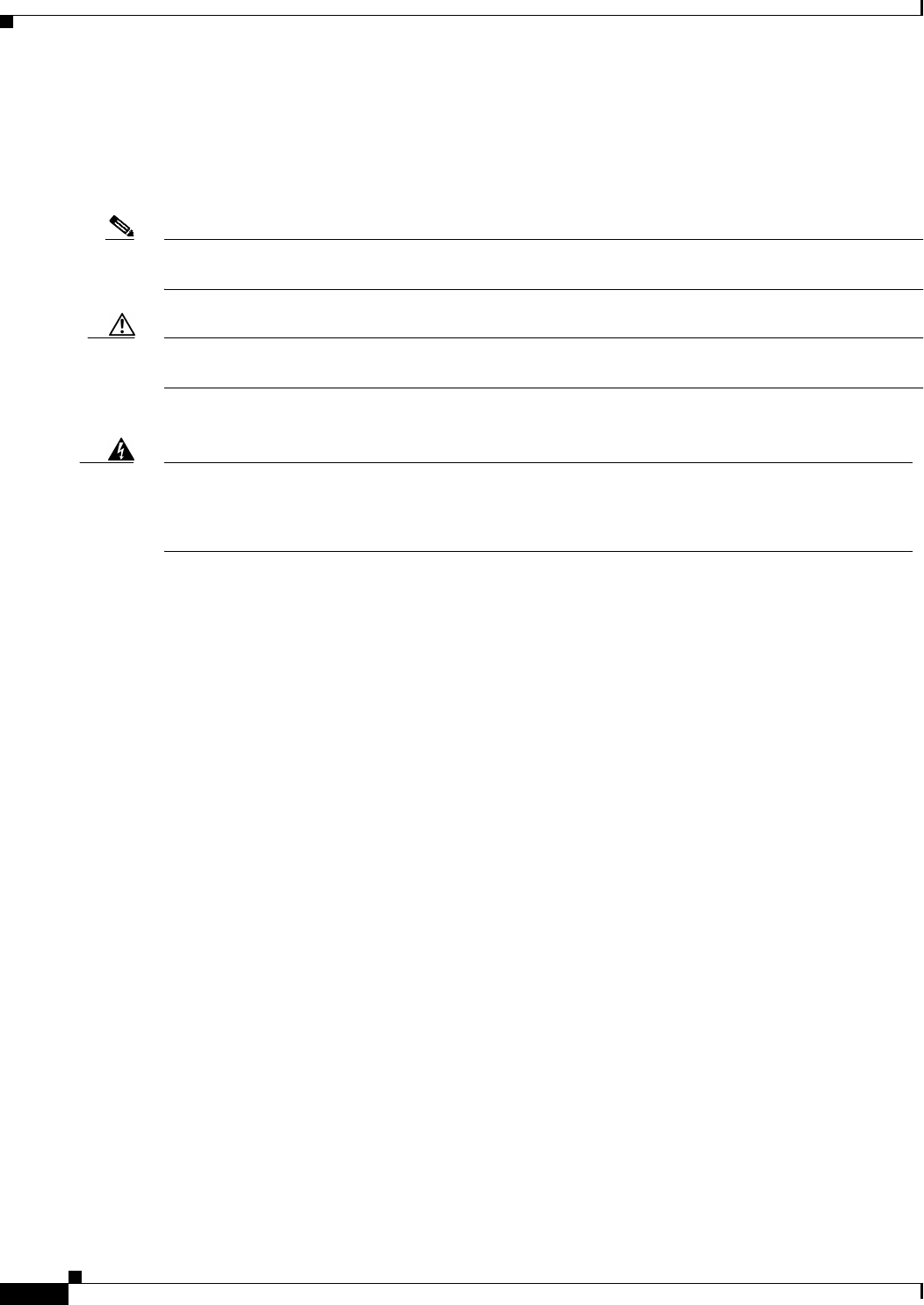
DRAFT - CISCO CONFIDENTIAL
viii
Cisco Aironet 1400 Series Wireless Bridge Hardware Installation Guide
OL-4072-01
Preface
Conventions
Conventions
This publication uses the following conventions to convey instructions and information:
•Commands and keywords are in boldface type.
Note Means reader take note. Notes contain helpful suggestions or references to materials not contained in
this manual.
Caution Means reader be careful. In this situation, you might do something that could result in equipment
damage or loss of data.
Warning
This warning symbol means danger. You are in a situation that could cause bodily injury. Before
you work on any equipment, be aware of the hazards involved with electrical circuitry and be
familiar with standard practices for preventing accidents. (To see translations of the warnings
that appear in this publication, refer to the appendix “Translated Safety Warnings.”)
Waarschuwing
Dit waarschuwingssymbool betekent gevaar. U verkeert in een situatie die lichamelijk letsel kan
veroorzaken. Voordat u aan enige apparatuur gaat werken, dient u zich bewust te zijn van de bij
elektrische schakelingen betrokken risico’s en dient u op de hoogte te zijn van standaard
maatregelen om ongelukken te voorkomen. (Voor vertalingen van de waarschuwingen die in deze
publicatie verschijnen, kunt u het aanhangsel “Translated Safety Warnings” (Vertalingen van
veiligheidsvoorschriften) raadplegen.)
Varoitus
Tämä varoitusmerkki merkitsee vaaraa. Olet tilanteessa, joka voi johtaa ruumiinvammaan. Ennen
kuin työskentelet minkään laitteiston parissa, ota selvää sähkökytkentöihin liittyvistä vaaroista
ja tavanomaisista onnettomuuksien ehkäisykeinoista. (Tässä julkaisussa esiintyvien varoitusten
käännökset löydät liitteestä "Translated Safety Warnings" (käännetyt turvallisuutta koskevat
varoitukset).)
Attention
Ce symbole d’avertissement indique un danger. Vous vous trouvez dans une situation pouvant
entraîner des blessures. Avant d’accéder à cet équipement, soyez conscient des dangers posés
par les circuits électriques et familiarisez-vous avec les procédures courantes de prévention des
accidents. Pour obtenir les traductions des mises en garde figurant dans cette publication,
veuillez consulter l’annexe intitulée « Translated Safety Warnings » (Traduction des avis de
sécurité).
Warnung
Dieses Warnsymbol bedeutet Gefahr. Sie befinden sich in einer Situation, die zu einer
Körperverletzung führen könnte. Bevor Sie mit der Arbeit an irgendeinem Gerät beginnen, seien
Sie sich der mit elektrischen Stromkreisen verbundenen Gefahren und der Standardpraktiken zur
Vermeidung von Unfällen bewußt. (Übersetzungen der in dieser Veröffentlichung enthaltenen
Warnhinweise finden Sie im Anhang mit dem Titel “Translated Safety Warnings” (Übersetzung der
Warnhinweise).)

DRAFT - CISCO CONFIDENTIAL
ix
Cisco Aironet 1400 Series Wireless Bridge Hardware Installation Guide
OL-4072-01
Preface
Related Publications
Related Publications
For more information about bridges and related products, refer to the following publications:
•Quick Start Guide: Cisco Aironet 1400 Series Wireless Bridge describes the bridge, system
components, and how to obtain bridge documentation. This document is included in the shipping
box with your bridge.
•Cisco Aironet 1400 Series Wireless Bridge Software Configuration Guide describes the bridge’s
management system and explains how to configure the bridge. This document is available on the
Cisco CCO web site at the following URL:
TBD
•Cisco Aironet 1400 Series Wireless Bridge Mounting Instructions that was shipped with your bridge
provides detailed instructions for mounting the bridge and aligning the antenna .
•Cisco IOS Command Reference for Cisco Aironet Access Points and Bridges describes the IOS
commands supported by Cisco Aironet access points and bridges. This document is available on the
Cisco CCO web site at the following URL:
TBD
Avvertenza
Questo simbolo di avvertenza indica un pericolo. Si è in una situazione che può causare infortuni.
Prima di lavorare su qualsiasi apparecchiatura, occorre conoscere i pericoli relativi ai circuiti
elettrici ed essere al corrente delle pratiche standard per la prevenzione di incidenti. La
traduzione delle avvertenze riportate in questa pubblicazione si trova nell’appendice, “Translated
Safety Warnings” (Traduzione delle avvertenze di sicurezza).
Advarsel
Dette varselsymbolet betyr fare. Du befinner deg i en situasjon som kan føre til personskade. Før
du utfører arbeid på utstyr, må du være oppmerksom på de faremomentene som elektriske kretser
innebærer, samt gjøre deg kjent med vanlig praksis når det gjelder å unngå ulykker. (Hvis du vil
se oversettelser av de advarslene som finnes i denne publikasjonen, kan du se i vedlegget
"Translated Safety Warnings" [Oversatte sikkerhetsadvarsler].)
Aviso
Este símbolo de aviso indica perigo. Encontra-se numa situação que lhe poderá causar danos
fisicos. Antes de começar a trabalhar com qualquer equipamento, familiarize-se com os perigos
relacionados com circuitos eléctricos, e com quaisquer práticas comuns que possam prevenir
possíveis acidentes. (Para ver as traduções dos avisos que constam desta publicação, consulte
o apêndice “Translated Safety Warnings” - “Traduções dos Avisos de Segurança”).
¡Advertencia!
Este símbolo de aviso significa peligro. Existe riesgo para su integridad física. Antes de
manipular cualquier equipo, considerar los riesgos que entraña la corriente eléctrica y
familiarizarse con los procedimientos estándar de prevención de accidentes. (Para ver
traducciones de las advertencias que aparecen en esta publicación, consultar el apéndice
titulado “Translated Safety Warnings.”)
Varning!
Denna varningssymbol signalerar fara. Du befinner dig i en situation som kan leda till
personskada. Innan du utför arbete på någon utrustning måste du vara medveten om farorna med
elkretsar och känna till vanligt förfarande för att förebygga skador. (Se förklaringar av de
varningar som förekommer i denna publikation i appendix "Translated Safety Warnings"
[Översatta säkerhetsvarningar].)

DRAFT - CISCO CONFIDENTIAL
x
Cisco Aironet 1400 Series Wireless Bridge Hardware Installation Guide
OL-4072-01
Preface
Obtaining Documentation
•Release Notes for Cisco Aironet 1400 Series Wireless Bridge describes features and caveats for the
bridge running IOS release 12.2(11)JA. This document is available on the Cisco CCO web site at
the following URL:
TBD
•Cisco Secure Access Control Server for Windows 2000/NT Servers Version 3.0 User Guide provides
complete instructions for using Cisco Secure ACS, including steps for configuring Cisco Secure
ACS to support access points and bridges. This document is available on the Cisco CCO web site at
the following URL:
http://www.cisco.com/univercd/cc/td/doc/product/access/acs_soft/csacs4nt/csnt30/user/index.htm
Obtaining Documentation
Cisco provides several ways to obtain documentation, technical assistance, and other technical
resources. These sections explain how to obtain technical information from Cisco Systems.
Cisco.com
You can access the most current Cisco documentation on the World Wide Web at this URL:
http://www.cisco.com/univercd/home/home.htm
You can access the Cisco website at this URL:
http://www.cisco.com
International Cisco websites can be accessed from this URL:
http://www.cisco.com/public/countries_languages.shtml
Documentation CD-ROM
Cisco documentation and additional literature are available in a Cisco Documentation CD-ROM
package. The Documentation CD-ROM is updated regularly and may be more current than printed
documentation. The CD-ROM package is available as a single unit or through an annual or quarterly
subscription.
Registered Cisco.com users can order a single Documentation CD-ROM (product number
DOC-CONDOCCD=) through the Cisco Ordering tool:
http://www.cisco.com/en/US/partner/ordering/ordering_place_order_ordering_tool_launch.html
All users can order monthly or quarterly subscriptions through the online Subscription Store:
http://www.cisco.com/go/subscription
Ordering Documentation
You can find instructions for ordering documentation at this URL:
http://www.cisco.com/univercd/cc/td/doc/es_inpck/pdi.htm

DRAFT - CISCO CONFIDENTIAL
xi
Cisco Aironet 1400 Series Wireless Bridge Hardware Installation Guide
OL-4072-01
Preface
Obtaining Technical Assistance
You can order Cisco documentation in these ways:
•Registered Cisco.com users (Cisco direct customers) can order Cisco product documentation from
the Networking Products MarketPlace:
http://www.cisco.com/en/US/partner/ordering/index.shtml
•Nonregistered Cisco.com users can order documentation through a local account representative by
calling Cisco Systems Corporate Headquarters (California, U.S.A.) at 408 526-7208 or, elsewhere
in North America, by calling 800 553-NETS (6387).
Documentation Feedback
You can submit comments electronically on Cisco.com. On the Cisco Documentation home page, click
Feedback at the top of the page.
You can e-mail your comments to bug-doc@cisco.com.
You can submit comments by using the response card (if present) behind the front cover of your
document or by writing to the following address:
Cisco Systems
Attn: Customer Document Ordering
170 West Tasman Drive
San Jose, CA 95134-9883
We appreciate your comments.
Obtaining Technical Assistance
Cisco provides Cisco.com, which includes the Cisco Technical Assistance Center (TAC) website, as a
starting point for all technical assistance. Customers and partners can obtain online documentation,
troubleshooting tips, and sample configurations from the Cisco TAC website. Cisco.com registered users
have complete access to the technical support resources on the Cisco TAC website, including TAC tools
and utilities.
Cisco.com
Cisco.com offers a suite of interactive, networked services that let you access Cisco information,
networking solutions, services, programs, and resources at any time, from anywhere in the world.
Cisco.com provides a broad range of features and services to help you with these tasks:
•Streamline business processes and improve productivity
•Resolve technical issues with online support
•Download and test software packages
•Order Cisco learning materials and merchandise
•Register for online skill assessment, training, and certification programs
To obtain customized information and service, you can self-register on Cisco.com at this URL:
http://tools.cisco.com/RPF/register/register.do

DRAFT - CISCO CONFIDENTIAL
xii
Cisco Aironet 1400 Series Wireless Bridge Hardware Installation Guide
OL-4072-01
Preface
Obtaining Technical Assistance
Technical Assistance Center
The Cisco TAC is available to all customers who need technical assistance with a Cisco product,
technology, or solution. Two types of support are available: the Cisco TAC website and the Cisco TAC
Escalation Center. The type of support that you choose depends on the priority of the problem and the
conditions stated in service contracts, when applicable.
We categorize Cisco TAC inquiries according to urgency:
•Priority level 4 (P4)—You need information or assistance concerning Cisco product capabilities,
product installation, or basic product configuration. There is little or no impact to your business
operations.
•Priority level 3 (P3)—Operational performance of the network is impaired, but most business
operations remain functional. You and Cisco are willing to commit resources during normal business
hours to restore service to satisfactory levels.
•Priority level 2 (P2)—Operation of an existing network is severely degraded, or significant aspects
of your business operations are negatively impacted by inadequate performance of Cisco products.
You and Cisco will commit full-time resources during normal business hours to resolve the situation.
•Priority level 1 (P1)—An existing network is “down,” or there is a critical impact to your business
operations. You and Cisco will commit all necessary resources around the clock to resolve the
situation.
Cisco TAC Website
The Cisco TAC website provides online documents and tools to help troubleshoot and resolve technical
issues with Cisco products and technologies. To access the Cisco TAC website, go to this URL:
http://www.cisco.com/tac
All customers, partners, and resellers who have a valid Cisco service contract have complete access to
the technical support resources on the Cisco TAC website. Some services on the Cisco TAC website
require a Cisco.com login ID and password. If you have a valid service contract but do not have a login
ID or password, go to this URL to register:
http://tools.cisco.com/RPF/register/register.do
If you are a Cisco.com registered user, and you cannot resolve your technical issues by using the Cisco
TAC website, you can open a case online at this URL:
http://www.cisco.com/tac/caseopen
If you have Internet access, we recommend that you open P3 and P4 cases online so that you can fully
describe the situation and attach any necessary files.
Cisco TAC Escalation Center
The Cisco TAC Escalation Center addresses priority level 1 or priority level 2 issues. These
classifications are assigned when severe network degradation significantly impacts business operations.
When you contact the TAC Escalation Center with a P1 or P2 problem, a Cisco TAC engineer
automatically opens a case.
To obtain a directory of toll-free Cisco TAC telephone numbers for your country, go to this URL:
http://www.cisco.com/warp/public/687/Directory/DirTAC.shtml

DRAFT - CISCO CONFIDENTIAL
xiii
Cisco Aironet 1400 Series Wireless Bridge Hardware Installation Guide
OL-4072-01
Preface
Obtaining Additional Publications and Information
Before calling, please check with your network operations center to determine the Cisco support services
to which your company is entitled: for example, SMARTnet, SMARTnet Onsite, or Network Supported
Accounts (NSA). When you call the center, please have available your service agreement number and
your product serial number.
Obtaining Additional Publications and Information
Information about Cisco products, technologies, and network solutions is available from various online
and printed sources.
•The Cisco Product Catalog describes the networking products offered by Cisco Systems, as well as
ordering and customer support services. Access the Cisco Product Catalog at this URL:
http://www.cisco.com/en/US/products/products_catalog_links_launch.html
•Cisco Press publishes a wide range of networking publications. Cisco suggests these titles for new
and experienced users: Internetworking Terms and Acronyms Dictionary, Internetworking
Technology Handbook, Internetworking Troubleshooting Guide, and the Internetworking Design
Guide. For current Cisco Press titles and other information, go to Cisco Press online at this URL:
http://www.ciscopress.com
•Packet magazine is the Cisco quarterly publication that provides the latest networking trends,
technology breakthroughs, and Cisco products and solutions to help industry professionals get the
most from their networking investment. Included are networking deployment and troubleshooting
tips, configuration examples, customer case studies, tutorials and training, certification information,
and links to numerous in-depth online resources. You can access Packet magazine at this URL:
http://www.cisco.com/go/packet
•iQ Magazine is the Cisco bimonthly publication that delivers the latest information about Internet
business strategies for executives. You can access iQ Magazine at this URL:
http://www.cisco.com/go/iqmagazine
•Internet Protocol Journal is a quarterly journal published by Cisco Systems for engineering
professionals involved in designing, developing, and operating public and private internets and
intranets. You can access the Internet Protocol Journal at this URL:
http://www.cisco.com/en/US/about/ac123/ac147/about_cisco_the_internet_protocol_journal.html
•Training—Cisco offers world-class networking training. Current offerings in network training are
listed at this URL:
http://www.cisco.com/en/US/learning/le31/learning_recommended_training_list.html

DRAFT - CISCO CONFIDENTIAL
xiv
Cisco Aironet 1400 Series Wireless Bridge Hardware Installation Guide
OL-4072-01
Preface
Obtaining Additional Publications and Information

CHAPTER
DRAFT - CISCO CONFIDENTIAL
1-1
Cisco Aironet 1400 Series Wireless Bridge Hardware Installation Guide
OL-4072-01
1
Overview
The Cisco Aironet 1400 Series Bridge (hereafter called the bridge) is a wireless device designed for
building to building wireless connectivity. Operating in the 5.8 GHz UNII 3 band (5725 to 5825 MHz),
derived from the 802.11a standard, the bridge delivers 6-54 Mbps data rates without the need for a
license. The bridge is a self contained unit designed for outdoor installations, providing differing
antenna gains as well as coverage patterns and supports both point-to-point and multipoint
configurations.
The bridge uses a browser-based management system, but you can also configure the bridge using Cisco
IOS commands or Simple Network Management Protocol (SNMP).
This chapter provides information on the following topics:
•Key Features, page 1-2
•Network Configuration Examples, page 1-5
•Bridge Specifications, page 1-6
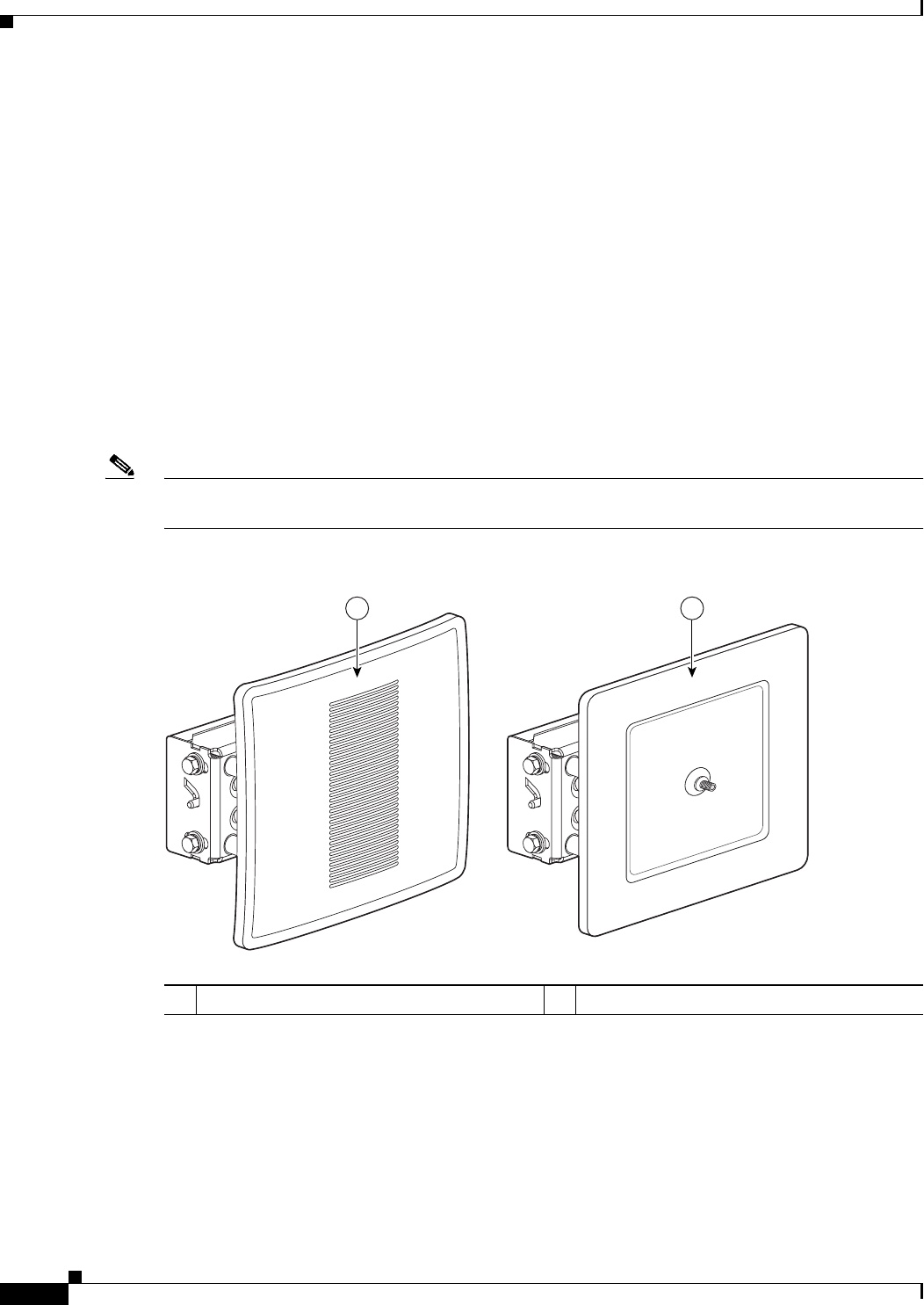
DRAFT - CISCO CONFIDENTIAL
1-2
Cisco Aironet 1400 Series Wireless Bridge Hardware Installation Guide
OL-4072-01
Chapter 1 Overview
Key Features
Key Features
Key features of the bridge:
•Unlicensed UNII-3 5.8-GHz radio operation
•Metal enclosure supports outdoor installations
•Industrial temperature rating
•Integrated antenna or external antenna configurations (see Figure 1-1)
•Dual-coax 100 Mbps Ethernet ports
•Four LED indicators on bridge
•Inline power over dual-coax Ethernet cables
•Receive Signal Strength Indicator (RSSI) voltage port for easy antenna alignment
•Bridge control using IOS commands, Internet browser, or SNMP
Note The bridge communicates only with other bridges and does not support associations with wireless client
adapters.
Figure 1-1 Bridge Configurations
Power
The bridge receives inline power from the Cisco Aironet Power Injector LR (hereafter called the power
injector). Dual-coax Ethernet cables are used to provide Ethernet data and power from the power injector
to the bridge. The power injector is an external unit designed for operation in a sheltered environment,
such as inside a building. The power injector also functions as an Ethernet repeater by connecting to a
Category 5 LAN backbone and using the dual-coaxial cable interface to the bridge.
1Integrated antenna bridge configuration 2External antenna bridge configuration
88795
1 2

DRAFT - CISCO CONFIDENTIAL
1-3
Cisco Aironet 1400 Series Wireless Bridge Hardware Installation Guide
OL-4072-01
Chapter 1 Overview
Key Features
The power injector uses an external 48 VDC power module and after detecting the presence of the
bridge, injects the DC voltage into the dual coax cables to power the bridge.
Note The power injector and the power module should not be placed in an outdoor unprotected environment.
External Antenna
The bridge is available with an N-type RF connector on the front of the unit (see Figure 1-1) for an
external 5.8-GHz antenna. The supported external antennas connect to the bridge antenna connector
using the antenna’s 4.9 ft (1.5 m) long coax cable.
–
9 dBi omnidirectional external antenna with vertical polarization
–
9.5 dBi sector external antenna
–
28 dBi dish external antenna
Note To meet regulatory restrictions, the external antenna bridge configuration and the external antenna must
be professional installed.
Integrated Antenna
The bridge is available with an integrated 22.5 dBi patch array antenna. The antenna is covered with a
special radome cover to protect the antenna from environmental elements. When configured with the
integrated antenna, the antenna polarization is controlled by the mounting orientation of the bridge. The
bridge must be physically rotated 90 degrees to obtain either horizontal or vertical polarization. A special
polarization mark is designed into the bridge housing to indicate the polarization direction.
Dual-Coax Ethernet Ports
The bridge’s dual Ethernet ports accepts a pair of 75 ohm F-type connectors, linking the bridge to your
100BASE-T Ethernet LAN through the power injector. The dual coax cables are used to send and receive
Ethernet data, plus the cables supply inline 48 VDC power from the power injector. For the location of
the ports, refer to Figure 1-2.
Tip You can connect the dual coax cable connectors to either of the bridge’s Ethernet ports. The bridge
senses the Ethernet signals and automatically switches internal circuitry to match the cable connections.
Metal Enclosure
The bridge uses a metal enclosure that supports outdoor operating environments and supports an
industrial temperature operating range (refer to Bridge Specifications, page 1-6).
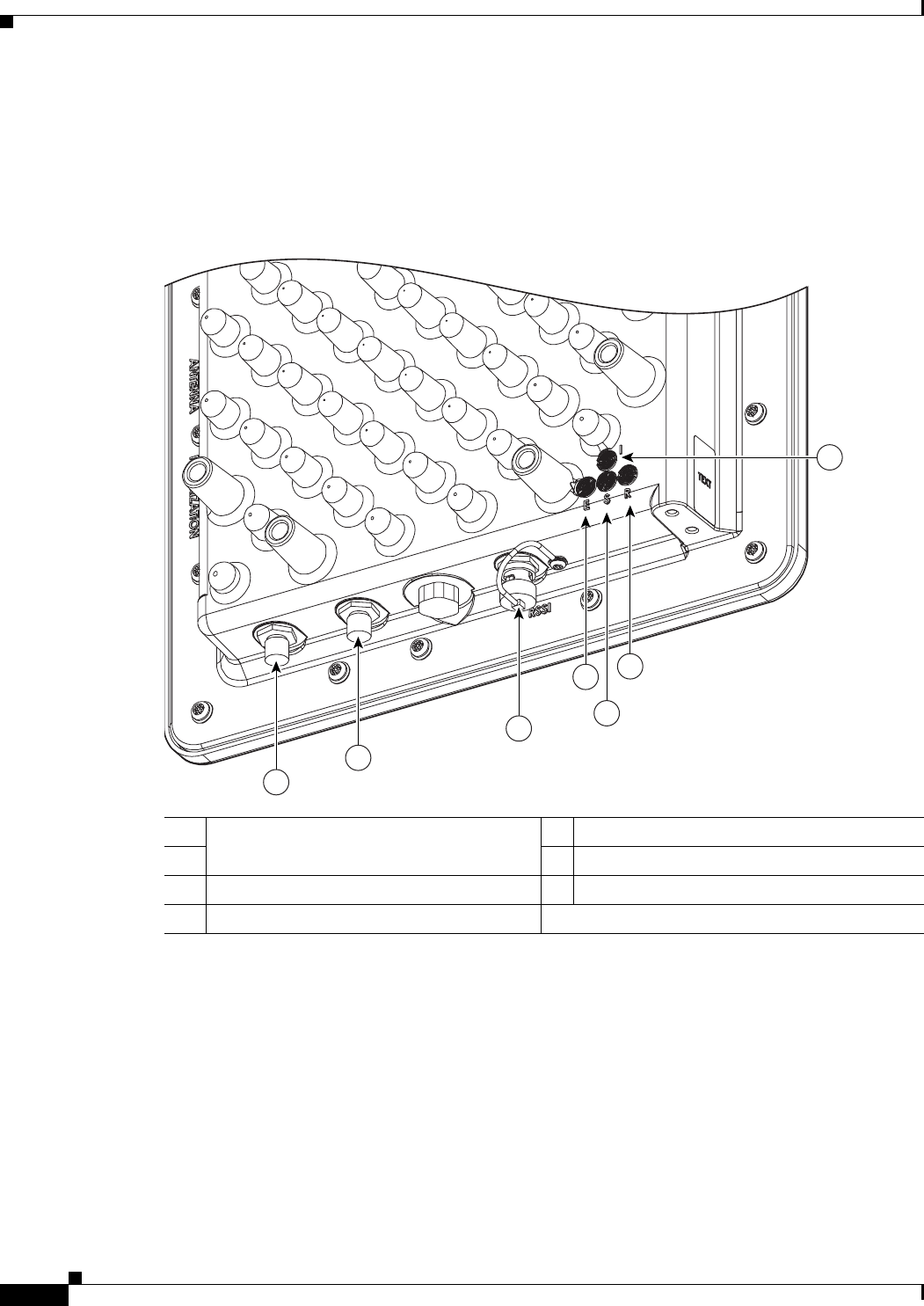
DRAFT - CISCO CONFIDENTIAL
1-4
Cisco Aironet 1400 Series Wireless Bridge Hardware Installation Guide
OL-4072-01
Chapter 1 Overview
Key Features
Indicators
Four indicators are located on back of the housing to report installation/alignment conditions, bridge
status, radio activity, and Ethernet activity. The indicators are shown in Figure 1-2.
Figure 1-2 Bridge Connectors and Indicators
•The install indicator indicates installation mode is activated. During installation mode, the other
indicators provide signal strength readings used for antenna alignment.
•The radio indicator blinks green to indicate radio traffic activity. The light is normally off, but it
blinks green whenever a packet is received or transmitted over the bridge radio link. This indicator
also provides signal strength readings during installation mode.
•The status indicator signals bridge association status. Blinking green indicates that the bridge is not
associated with another bridge. Steady green indicates that the bridge is associated with at least one
other bridge. This indicator also provides signal strength readings during installation mode.
1Power injector dual-coax ports 5Status LED
26Radio LED
3RSSI voltage port 7Install LED
4Ethernet LED
7
1
2
3
46
5
88777
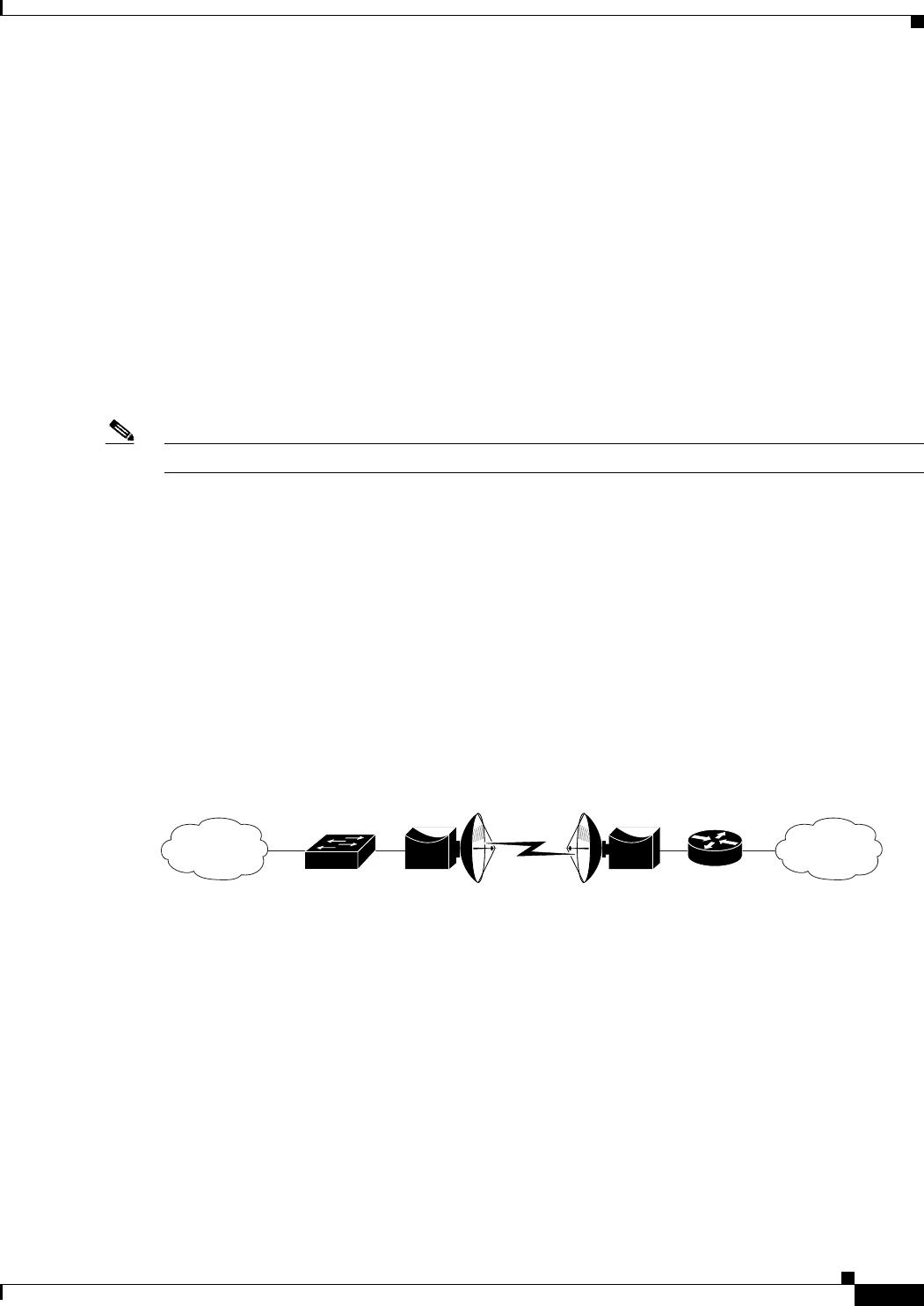
DRAFT - CISCO CONFIDENTIAL
1-5
Cisco Aironet 1400 Series Wireless Bridge Hardware Installation Guide
OL-4072-01
Chapter 1 Overview
Network Configuration Examples
•The Ethernet indicator signals Ethernet traffic. This indicator blinks green when a packet is received
or transmitted over the Ethernet infrastructure. The indicator is off when the Ethernet link not
working or the port is shutdown. This indicator also provides signal strength readings during
installation mode.
For additional information on the LED indicators, refer to“Checking the LED Indicators” section on
page 5-2.
Receive Signal Strength Indicator Port
The bridge supports a radio signal strength indicator (RSSI) port for use in antenna alignment. The RSSI
port produces a DC voltage proportional to the strength of the received radio signal. The highest voltage
indicates the best antenna alignment position. The RSSI port is a male BNC connector located on the
bottom of the bridge housing (see Figure 1-2).
Note The RSSI port requires the use of a voltmeter and a cable with a female BNC connector.
Network Configuration Examples
This section describes the bridge’s role in three common wireless network configurations.
Point-to-Point Configuration
In a point-to-point configuration, two bridges are used to interconnect two remote LAN networks
together using a wireless communication link (see Figure 1-3). The bridge connected to the main LAN
network is classified as a root bridge and the other bridge is classified as a repeater bridge.
Figure 1-3 Point-to-Point Bridge Configuration
Port Aggregation or Redundancy Configuration
The port aggregation or redundancy configuration (Figure 1-4) is used to provide increased bandwidth
or backup redundancy communications between two LANs. Port aggregation or increased bandwidth
occurs when both wireless links are used to simultaneously pass Ethernet traffic. Backup communication
redundancy can be achieved with this configuration when one wireless bridge link is used only if the
other wireless bridge link fails.
88833
Bridge Bridge
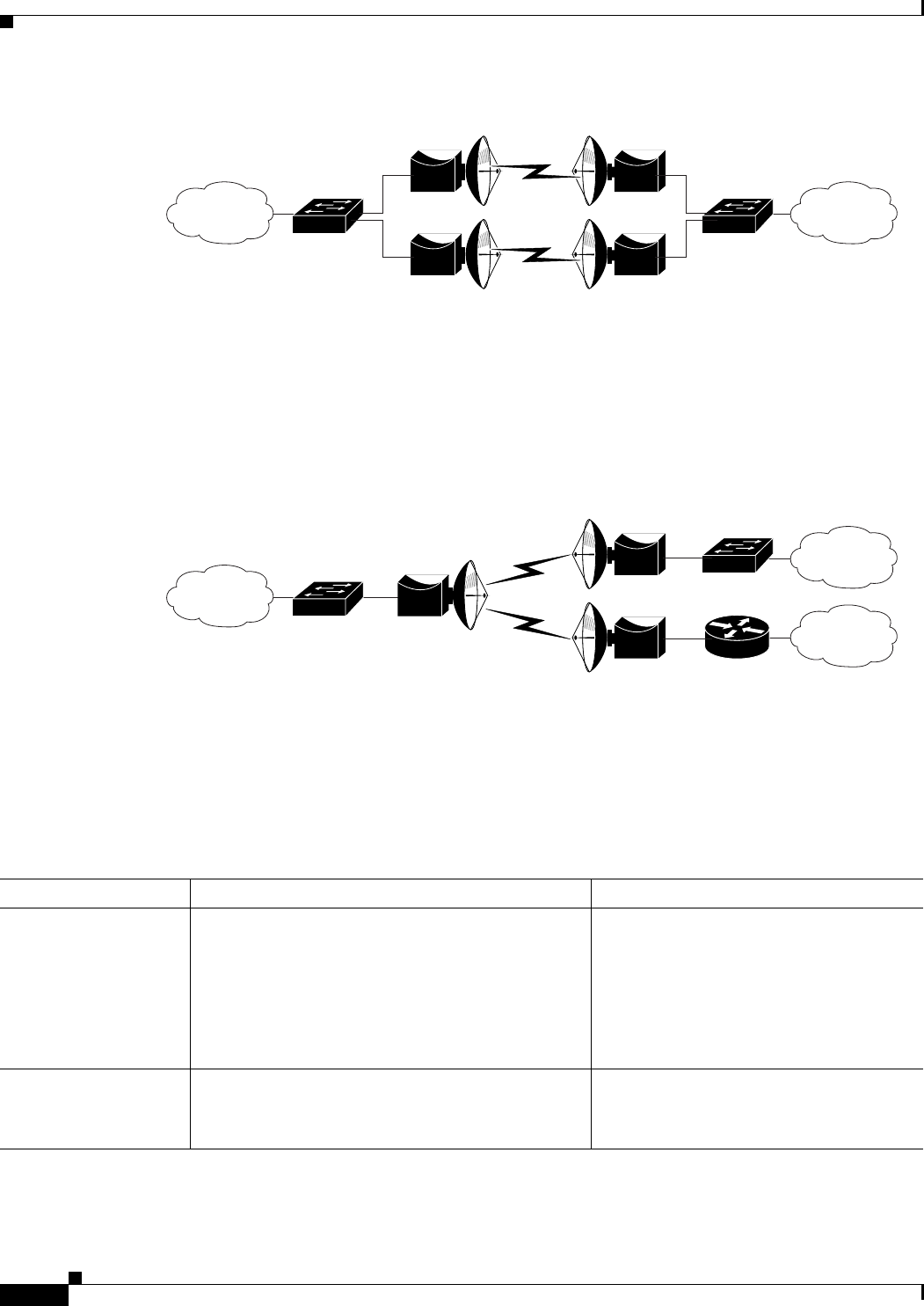
DRAFT - CISCO CONFIDENTIAL
1-6
Cisco Aironet 1400 Series Wireless Bridge Hardware Installation Guide
OL-4072-01
Chapter 1 Overview
Bridge Specifications
Figure 1-4 Port Aggregation or Redundancy Bridge Configuration
Point-to-Multipoint Configuration
The point-to-multipoint configuration (Figure 1-5) is used to interconnect the main LAN network to
multiple remote LAN networks.
Figure 1-5 Point-to-Multipoint Bridge Configuration
Bridge Specifications
The bridge, power injector, and power module specifications are listed in Table 1-1.
88834
Bridge Bridge
Bridge Bridge
88835
Bridge
Bridge
Bridge
Table 1-1 Bridge, Power Injector, and Power Module Specifications
Category Bridge Power Injector
Size Integrated antenna configuration:
11.6 in. W x 11.6 in. H x 3.6 in. D
29.46 cm W x 29.46 cm H x 9.14 cm D
External antenna configuration:
11.4 in. W x 11.4 in. H 4.2 in. D
28.96 cm W x 28.96 cm H 10.67 cm D
Power injector:
6.25 in. W x 6.38 in. H x 1.31 in. D
15.88 cm W x 16.21 cm H x 3.33 cm D
Power module:
6.0 in. W x 2.75 in. H x 1.75 in. D
15.24 cm W x 6.99 cm H x 4.45 cm D
Indicators Four indicators on the back panel: Installation and
Alignment Mode, Ethernet traffic, bridge status, and
radio traffic
Three indicators on the front panel: Uplink
activity, injector status, Ethernet activity
One indicator on the side panel: Power

DRAFT - CISCO CONFIDENTIAL
1-7
Cisco Aironet 1400 Series Wireless Bridge Hardware Installation Guide
OL-4072-01
Chapter 1 Overview
Bridge Specifications
Connectors Bottom panel (left to right): Ethernet port1 and port 2
(two F-type connectors), RSSI port (male BNC
connector)
Front Panel (external antenna configuration):
antenna Type N connector
Side panel (left to right): 48VDC power
connector, two coaxial uplink F-type
connectors, and Ethernet RJ-45 connector
for 100BASE-T Ethernet
Operating Temperature –22 to 131oF (–30 to 55oC) 32 to 122oF (0 to 50oC)
Cold Start Temperature -22oF (-30oC) na
Warm-up time
(for full performance) 15 minutes after cold start na
Non-Operational
Temperature –40 to 185oF (–40 to 85oC) -40 to 158oF (-40 to 70oC)
Operational Altitude 6,562 ft (2000 m) 6,562 ft (2000 m)
Non-Operational
Altitude 16,000 ft (4877 m) 16,000 ft (4877 m)
Humidity 0 to 100% (condensing) 0 to 90% (non-condensing)
Operational Vibration 0.001 G2/Hz from 5-100 Hz 0.001 G2/Hz from 5-100 Hz
Non-Operational
Vibration 0.01 G2/Hz from 5-100 Hz 0.01 G2/Hz from 5-100 Hz
Environmental Testing
Compliance Integrated antenna configuration:
The enclosure has been successfully tested for
protection against the ingress of particulate
matter and fluids in compliance with a NEMA
Type 4 (IP56) enclosure rating.
External antenna configuration:
The enclosure has been successfully tested and is
in compliance with a NEMA Type 4 (IP56)
enclosure rating.
na
Weight Integrated antenna configuration:
11 lbs (4.99 kg)
External antenna configuration:
10 lbs (4.54 kg)
Power injector—1.4 lbs (0.6 Kg)
Power Module—TBD
Input Voltage 48 VDC nominal (supplied by Ethernet dual-coax
cables) Power injector—48 VDC nominal
Power module—100-240 VAC
Power Consumption 41 W (typical)
TBD W (maximum) TBD W (maximum)
Transmit Power 24, 23, 22, 21, 18, 15, 12 dBm na
Frequency UNII 3—5.725 to 5.825 GHz
(Depending on the regulatory domain) na
Wireless modulation Coded Orthogonal Frequency Division Multiplexing
(COFDM) na
Table 1-1 Bridge, Power Injector, and Power Module Specifications (continued)
Category Bridge Power Injector

DRAFT - CISCO CONFIDENTIAL
1-8
Cisco Aironet 1400 Series Wireless Bridge Hardware Installation Guide
OL-4072-01
Chapter 1 Overview
Bridge Specifications
Subcarrier modulation BPSK (6 Mbps and 9 Mbps)
QPSK (12 Mbps and 18 Mbps)
16-QAM (24 Mbps and 36 Mbps)
64-QAM (48 Mbps and 54 Mbps)
na
Data rates 6, 9, 12, 18, 24, 36, 48, and 54 Mbps na
Non-overlapping
channels 4na
Antenna Integrated antenna—22.5 dBi patch array
External antennas:
9 dBi omnidirectional
9.5 dBi sector
28 dBi dish
na
Range (typical) Point-to-Point orientation
•Two 22.5 dBi integrated antennas:
–
7.8 miles at 54 Mbps
–
15.5 miles at 6 Mbps
•Two 28 dBi dish antennas:
–
11.9 miles at 54 Mbps
–
23.4 miles at 6 Mbps
Point-to-Multipoint orientation
•9 dBi omnidirectional antenna at the root
location and 22.5 dBi integrated antenna at the
non-root location:
–
2.0 miles at 54 Mbps
–
8.3 miles at 6 Mbps
•9.5 dBi sector antenna at the root location and
22.5 dBi integrated antenna at the non-root
location:
–
2.2 miles at 54 Mbps
–
8.5 miles at 6 Mbps
•9 dBi omnidirectional antenna at the root
location and 28 dBi dish antenna at the non-root
location:
–
3.0 miles at 54 Mbps
–
9.8 miles at 6 Mbps
•9.5 dBi sector antenna at the root location and
28 dBi dish antenna at the non-root location:
–
3.4 miles at 54 Mbps
–
10.2 miles at 6 Mbps
na
Table 1-1 Bridge, Power Injector, and Power Module Specifications (continued)
Category Bridge Power Injector

DRAFT - CISCO CONFIDENTIAL
1-9
Cisco Aironet 1400 Series Wireless Bridge Hardware Installation Guide
OL-4072-01
Chapter 1 Overview
Bridge Specifications
Safety Bridge, power injector, and power module:
UL 60950
CSA C22.2 No. 60950
IEC 60950
EN 60950
Note The power injector and the power module must be used in an indoor environment.
Electromagnetic
Compatibility (EMC) Bridge, power injector, and power module:
FCC Part 15.107 and 15.109 Class B
ICES-003 Class B (Canada)
EN 55022 Class B
EN 55024
Radio Type Approvals Bridge radio:
FCC Part 15.207, 15.407, and15.209 Class B
ICES-003 Class B (Canada)
Canada DGTP-010
FCC Bulletin OET-65C
Industry Canada RSS-102, RSP100, and
RSS 210 Issue 5
na
RF Exposure Bridge antenna:
AIR-ANT58G28SDA-NAironet
AIR-ANT58G10SSA-NAironet
AIR-ANT58G9VOA-NAironet
na
Table 1-1 Bridge, Power Injector, and Power Module Specifications (continued)
Category Bridge Power Injector

DRAFT - CISCO CONFIDENTIAL
1-10
Cisco Aironet 1400 Series Wireless Bridge Hardware Installation Guide
OL-4072-01
Chapter 1 Overview
Bridge Specifications

CHAPTER
DRAFT - CISCO CONFIDENTIAL
2-1
Cisco Aironet 1400 Series Wireless Bridge Hardware Installation Guide
OL-4072-01
2
Installation Overview
This chapter provides warnings, safety information, and information needed before you begin the
installation of your bridge system. This chapter includes the following sections:
•Warnings, page 2-2
•Safety Information, page 2-3
•Unpacking the Bridge, page 2-5
•Before Beginning the Installation, page 2-6
•Installation Summary, page 2-8
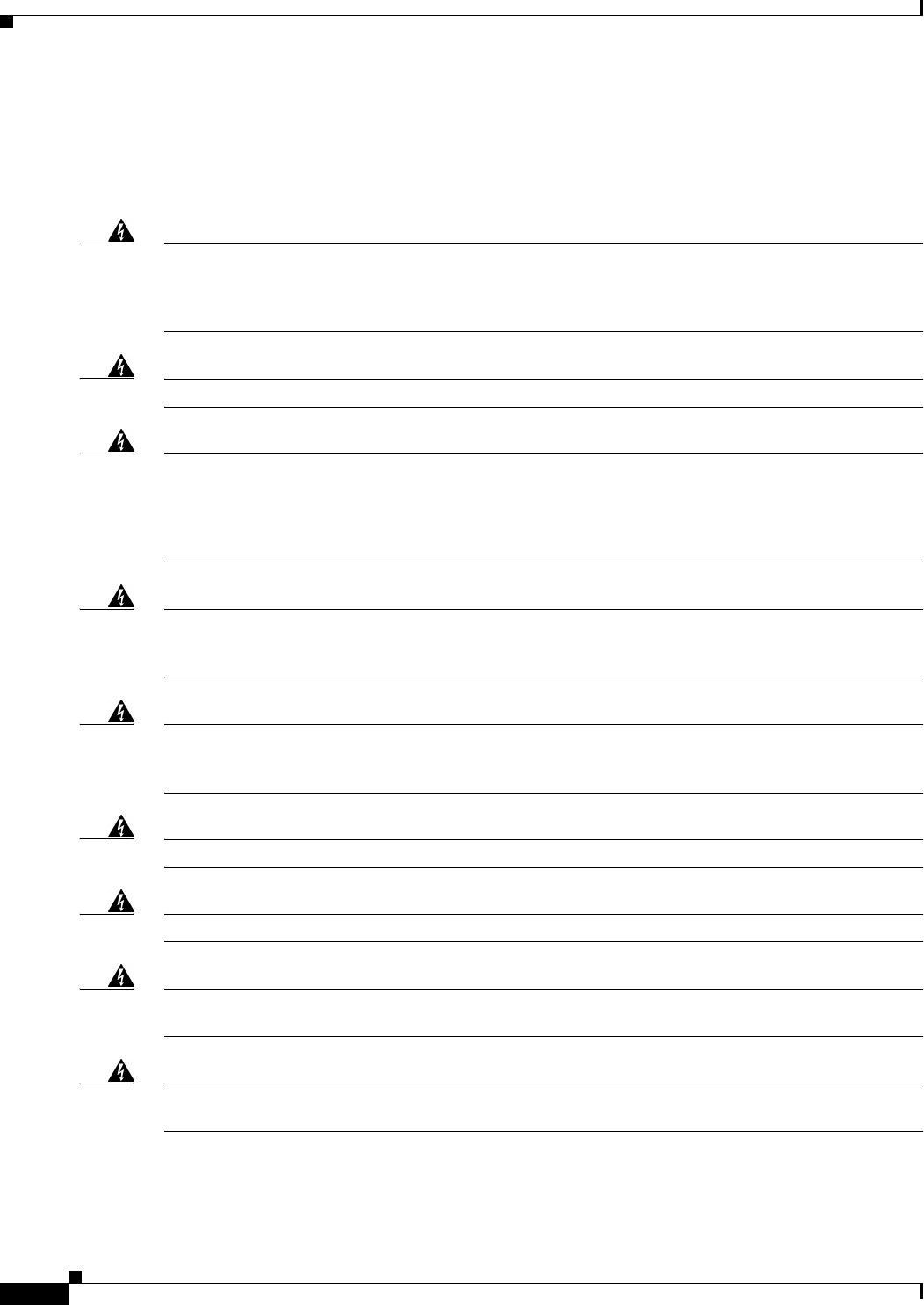
DRAFT - CISCO CONFIDENTIAL
2-2
Cisco Aironet 1400 Series Wireless Bridge Hardware Installation Guide
OL-4072-01
Chapter 2 Installation Overview
Warnings
Warnings
Translated versions of the following safety warnings are provided in Appendix A, “Translated Safety
Warnings.”
Warning
This warning symbol means danger. You are in a situation that could cause bodily injury. Before
you work on any equipment, be aware of the hazards involved with electrical circuitry and be
familiar with standard practices for preventing accidents. (To see translations of the warnings
that appear in this publication, refer to the appendix “Translated Safety Warnings.”)
Warning
Only trained and qualified personnel should be allowed to install, replace, or service this equipment.
Warning
Do not locate the antenna near overhead power lines or other electric light or power circuits, or
where it can come into contact with such circuits. When installing the antenna, take extreme care
not to come into contact with such circuits, as they may cause serious injury or death. For proper
installation and grounding of the antenna, please refer to national and local codes (e.g. U.S.:NFPA 70,
National Electrical Code, Article 810, in Canada: Canadian Electrical Code, Section 54).
Warning
This product relies on the building’s installation for short-circuit (overcurrent) protection. Ensure that
the protective device is rated not greater than:
120Vac, 15A U.S. (240Vac, 10A International)
Warning
Never defeat the ground conductor or operate the equipment in the absence of a suitably installed
ground conductor. Contact the appropriate electrical inspection authority or an electrician if you are
uncertain that suitable grounding is available.
Warning
Read the installation instructions before you connect the system to its power source.
Warning
Do not work on the system or connect or disconnect cables during periods of lightning activity.
Warning
Do not operate your wireless network device near unshielded blasting caps or in an explosive
environment unless the device has been modified to be especially qualified for such use.
Warning
Industry standards relating to radio frequency (RF) exposure limits for this product require that the
antennas should be positioned no less than 6.6 ft (2 m) from your body or nearby persons.

DRAFT - CISCO CONFIDENTIAL
2-3
Cisco Aironet 1400 Series Wireless Bridge Hardware Installation Guide
OL-4072-01
Chapter 2 Installation Overview
Safety Information
Warning
This unit is intended for installation in restricted access areas. A restricted access area can be
accessed only through the use of a special tool, lock and key, or other means of security.
Safety Information
Follow the guidelines in this section to ensure proper operation and safe use of the bridge.
FCC Safety Compliance Statement
The FCC, with its action in ET Docket 96-8, has adopted a safety standard for human exposure to RF
electromagnetic energy emitted by FCC-certified equipment. When used with approved Cisco Aironet
antennas, Cisco Aironet products meet the uncontrolled environmental limits found in OET-65 and ANSI
C95.1, 1991. Proper operation of this radio device according to the instructions in this publication results
in user exposure substantially below the FCC recommended limits.
Safety Precautions
Warning
Do not locate the antenna near overhead power lines or other electric light or power circuits, or
where it can come into contact with such circuits. When installing the antenna, take extreme care
not to come into contact with such circuits, as they may cause serious injury or death. For proper
installation and grounding of the antenna, please refer to national and local codes (e.g. U.S.:NFPA 70,
National Electrical Code, Article 810, in Canada: Canadian Electrical Code, Section 54).
Each year hundreds of people are killed or injured when attempting to install an antenna. In many of
these cases, the victim was aware of the danger of electrocution, but did not take adequate steps to avoid
the hazard.
For your safety, and to help you achieve a good installation, please read and follow these safety
precautions. They may save your life!
1. If you are installing an antenna for the first time, for your own safety as well as others, seek
professional assistance.
2. Select your installation site with safety, as well as performance in mind. Remember: electric power
lines and phone lines look alike. For your safety, assume that any overhead line can kill you.
3. Call your electric power company. Tell them your plans and ask them to come look at your proposed
installation. This is a small inconvenience considering your life is at stake.
4. Plan your installation carefully and completely before you begin. Successful raising of a mast or
tower is largely a matter of coordination. Each person should be assigned to a specific task, and
should know what to do and when to do it. One person should be in charge of the operation to issue
instructions and watch for signs of trouble.
5. When installing your antenna, remember:
a. Do not use a metal ladder.
b. Do not work on a wet or windy day.
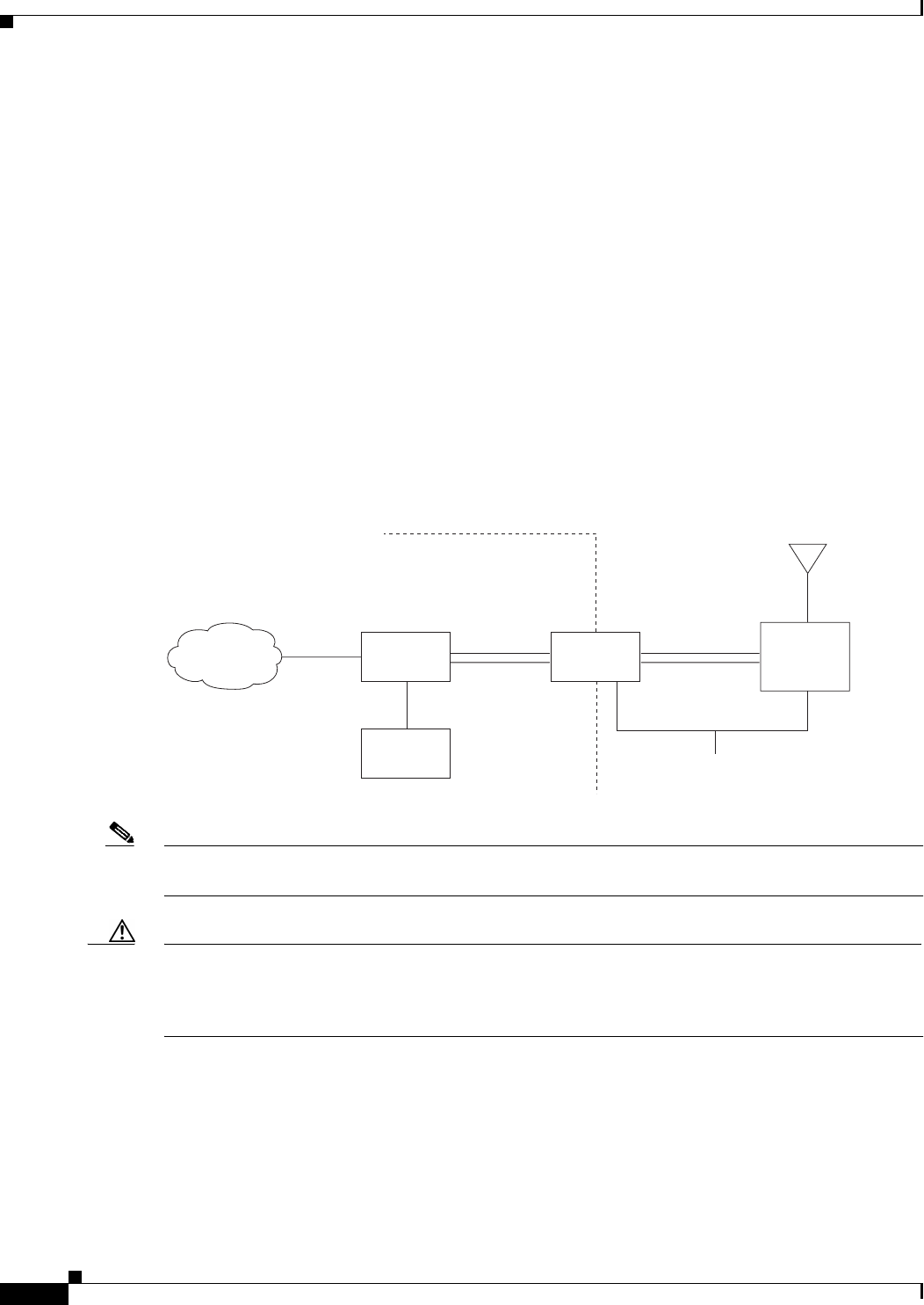
DRAFT - CISCO CONFIDENTIAL
2-4
Cisco Aironet 1400 Series Wireless Bridge Hardware Installation Guide
OL-4072-01
Chapter 2 Installation Overview
Safety Information
c. Do dress properly—shoes with rubber soles and heels, rubber gloves, long sleeved shirt or
jacket.
6. If the assembly starts to drop, get away from it and let it fall. Remember, the antenna, mast, cable,
and metal guy wires are all excellent conductors of electrical current. Even the slightest touch of any
of these parts to a power line complete an electrical path through the antenna and the installer: you!
7. If any part of the antenna system should come in contact with a power line, don’t touch it or try to
remove it yourself. Call your local power company. They will remove it safely.
If an accident should occur with the power lines call for qualified emergency help immediately.
Typical Bridge Installation Components
The bridge is designed to be installed in an outdoor environment, typically, on a tower or a tall building.
A typical bridge installation diagram is shown in Figure 2-1.
Figure 2-1 Typical Bridge Installation Diagram
Note 1) Ground wires must comply with Sections 810 and 820 of the National Electrical Code and Section 54
of the Canadian Electrical Code.
Caution To ensure correct installation and grounding, install the bridge in compliance with your local and
national electrical codes: National Fire Protection Association (NFPA) 70, National Electrical Code
(U.S.); Canadian Electrical Code, Part I, CSA 22.1 (Canada); and if local or national electrical codes are
not available, refer to IEC 364, Part 1 through 7 (other countries).
88836
CAT5
Ethernet
cable
Dual-coax
cables Dual-coax
cables
Indoor
Building
entrance
Outdoor
Ground
(see note 1)
Power
injector
Power
module
Grounding
block Bridge
Integrated
or
external antenna
LAN network

DRAFT - CISCO CONFIDENTIAL
2-5
Cisco Aironet 1400 Series Wireless Bridge Hardware Installation Guide
OL-4072-01
Chapter 2 Installation Overview
Installation Guidelines
Installation Guidelines
Because the bridge is a radio device, it is susceptible to common causes of interference that can reduce
throughput and range. Follow these basic guidelines to ensure the best possible performance:
•Install the bridge in an area where structures, trees, or hills do not obstruct radio signals to and from
the bridge.
•Install the bridge at a height sufficient to provide line-of-sight orientations.
Site Surveys
Because of differences in component configuration, placement, and physical environment, every
network application is a unique installation. Before installing multiple bridges, you should perform a site
survey to determine the optimum utilization of networking components and to maximize range,
coverage, and network performance.
Consider the following operating and environmental conditions when performing a site survey:
•Data rates—Sensitivity and range are inversely proportional to data bit rates. The maximum radio
range is achieved at the lowest workable data rate. A decrease in receiver sensitivity occurs as the
radio data increases.
•Antenna type and placement—Proper antenna configuration is a critical factor in maximizing radio
range. As a general rule, range increases in proportion to antenna height. However, do not place the
antenna higher than necessary, because the extra height also increases potential interference from
other unlicensed radio systems.
•Physical environment—Clear or open areas provide better radio range than closed or filled areas.
•Obstructions—Physical obstructions such as buildings, trees, or hills can hinder performance of
wireless devices. Avoid locating the devices in a location where there is an obstruction between the
sending and receiving antennas.
Unpacking the Bridge
Follow these steps to unpack the bridge:
Step 1 Open the shipping container and carefully remove the contents.
Step 2 Return all packing materials to the shipping container and save it.
Step 3 Ensure that all items listed in the “Package Contents” section are included in the shipment. Check each
item for damage. If any item is damaged or missing, notify your authorized Cisco sales representative.

DRAFT - CISCO CONFIDENTIAL
2-6
Cisco Aironet 1400 Series Wireless Bridge Hardware Installation Guide
OL-4072-01
Chapter 2 Installation Overview
Before Beginning the Installation
Package Contents
Each bridge package contains the following items:
•Bridge unit
•Power injector unit (with mounting screws and wall anchors)
•Power module and AC power cord (with mounting screws and wall anchors)
•Two dual-coax cables [20 ft (6.1 m) and 50 ft (15.2 m)]
•Mounting kit and hardware
–
Multi-function mount (consisting of two bridge brackets and one tower or mast bracket)
–
Two tower clamps (U-bolts) with four nuts, washers, and lock washers
–
Four bolts and washers for securing the bridge brackets to the tower or mast bracket
–
Four bolts, washers, and lock washers for securing the bridge brackets to the bridge
•Grounding Block and mounting screws
•Ground lug for the bridge with screws
•Weatherproofing kit (consisting of Coax Seal and anti-corrosion gel)
•Quick Start Guide: Cisco Aironet 1400 Series Wireless Bridge
•Cisco Aironet 1400 Series Wireless Bridge Mounting Instructions
•Cisco product registration and Cisco documentation feedback cards
Before Beginning the Installation
Before you begin the installation process, please carefully review the following list of figures to become
familiar with the system components, connectors, indicators, cables, system interconnection, and
grounding:
•Bridge block diagram (Figure 2-1)
•Bridge layout (Figure 2-2)
•Power injector layout (Figure 2-3)
•Power module (Figure 2-4)
•Grounding block (Figure 2-5)
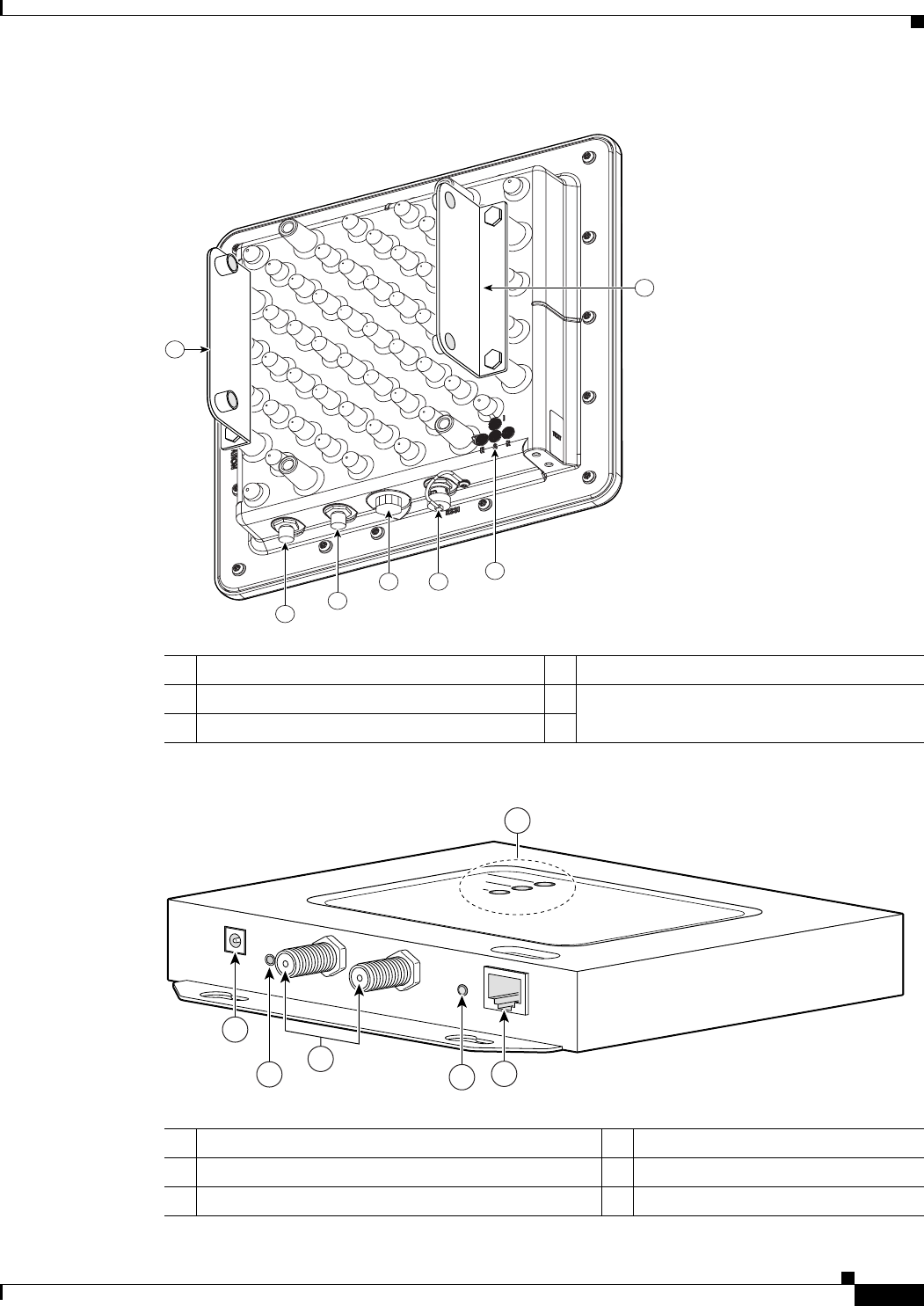
DRAFT - CISCO CONFIDENTIAL
2-7
Cisco Aironet 1400 Series Wireless Bridge Hardware Installation Guide
OL-4072-01
Chapter 2 Installation Overview
Before Beginning the Installation
Figure 2-2 Bridge Layout and Connectors
Figure 2-3 Power Injector Indicators and Connectors
1Bridge mounting brackets 4
2Bridge LED indicators 5Power injector dual-coax ports (F-type
connectors)
3RSSI voltage port (Female BNC connector) 6
88796
1
1
65
4 3 2
1Power jack (+48VDC) 4Mode button
2Power LED indicator 5Ethernet port (RJ45 connector)
3Power injector dual-coax ports (F-Type connectors) 6Indicator LEDs
88809
6
1
245
3
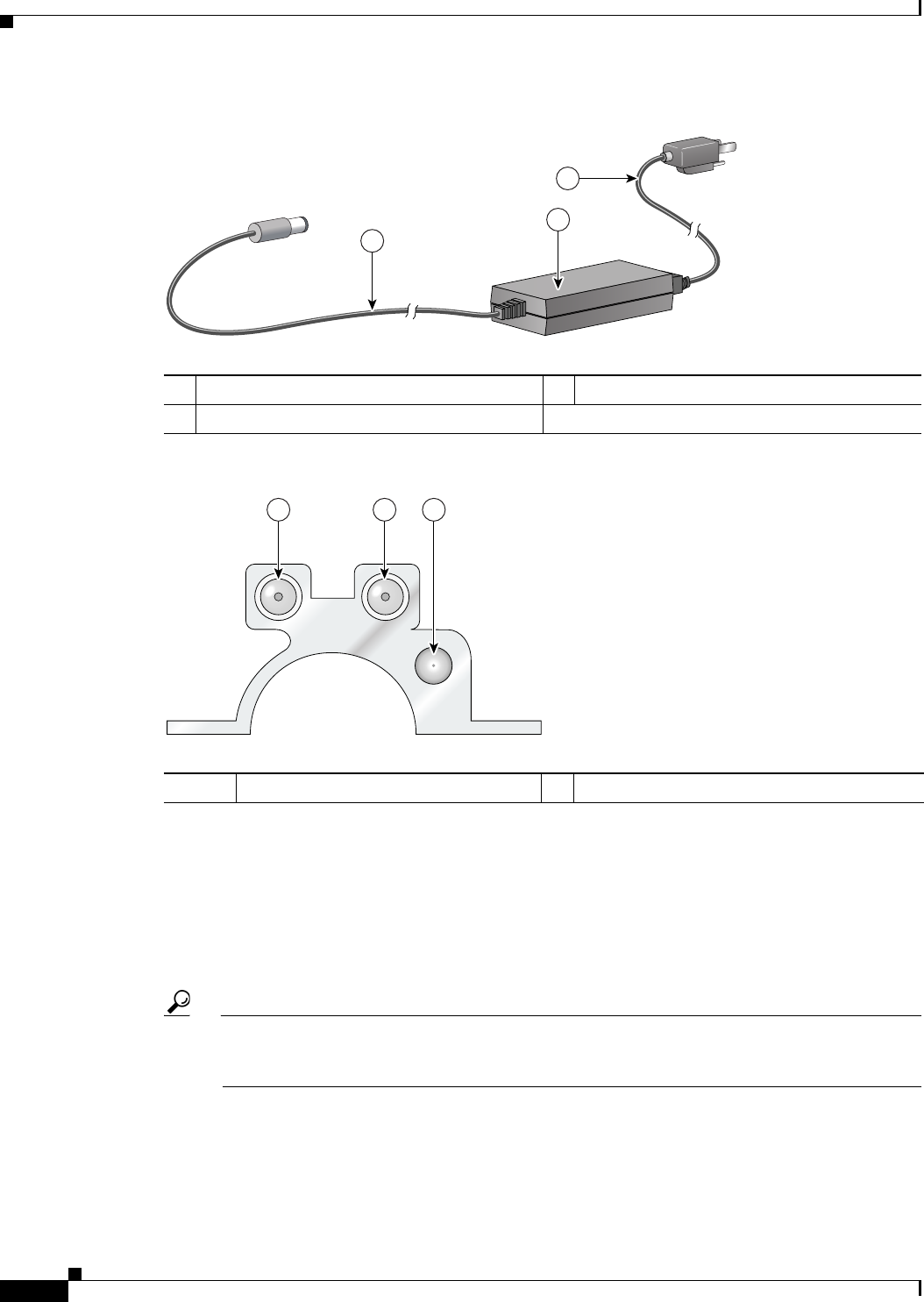
DRAFT - CISCO CONFIDENTIAL
2-8
Cisco Aironet 1400 Series Wireless Bridge Hardware Installation Guide
OL-4072-01
Chapter 2 Installation Overview
Installation Summary
Figure 2-4 Power Module
Figure 2-5 Grounding Block
Installation Summary
During the installation of the bridge, you will perform the following operations:
•Connect a user supplied CAT5 Ethernet cable from your wired LAN network to the power injector.
•Connect the dual-coax Ethernet cables between the power injector and the grounding block
Tip You can connect the dual coax cable connectors to either of the grounding block connectors or
the power injector’s Ethernet ports. The bridge senses the Ethernet signals and automatically
switches internal circuitry to match the cable connections.
•Connect a ground wire to the grounding block.
•Mount the bridge to the external tower or mast. For additional information, refer to the Cisco Aironet
Series 1400 Wireless Bridge Mounting Instructions that shipped with your bridge.
•Connect a ground wire to the bridge (use the bridge ground lug)
148 VDC power output cable 2Power module
3AC power cord
1
2
3
88829
1 and 2 F-type coaxial connectors 3Ground wire lug
88830
1 2 3

DRAFT - CISCO CONFIDENTIAL
2-9
Cisco Aironet 1400 Series Wireless Bridge Hardware Installation Guide
OL-4072-01
Chapter 2 Installation Overview
Installation Summary
•Connect the dual-coax Ethernet cables to the grounding block and to the bridge.
Tip You can connect the dual coax cable connectors to either of the grounding block connectors or
the bridge’s Ethernet ports. The bridge senses the Ethernet signals and automatically switches
internal circuitry to match the cable connections.
•Connect the AC power cord to the 48 VDC power module.
Tip The root bridge should be positioned and powered up before the non-root bridge.
•Connect the power module to the power injector and plug the AC cord into an AC power receptacle.
•Align the bridge antenna. For additional information, refer to the Cisco Aironet 1400 Series Wireless
Bridge Mounting Instructions that shipped with your bridge.
•Configure basic settings (refer to Chapter 4, “Configuring the Bridge for the First Time”).
•Seal all external connectors with special weather sealing material.
•Configure security and other bridge options. For additional information, refer to the Cisco Aironet
1400 Series Wireless Bridge Software Configuration Guide.

DRAFT - CISCO CONFIDENTIAL
2-10
Cisco Aironet 1400 Series Wireless Bridge Hardware Installation Guide
OL-4072-01
Chapter 2 Installation Overview
Installation Summary

CHAPTER
DRAFT - CISCO CONFIDENTIAL
3-1
Cisco Aironet 1400 Series Wireless Bridge Hardware Installation Guide
OL-4072-01
3
Mounting and Alignment Overview
This chapter provides an overview of bridge mounting and antenna alignment. The following sections
are included in this chapter:
•Mounting the Bridge, page 3-2
•Mounting Hardware, page 3-2
•Bridge LED Indicators, page 3-3
•Aligning the Antenna Using LED Indications, page 3-5
•Aligning the Antenna Using the RSSI Voltage, page 3-6

DRAFT - CISCO CONFIDENTIAL
3-2
Cisco Aironet 1400 Series Wireless Bridge Hardware Installation Guide
OL-4072-01
Chapter 3 Mounting and Alignment Overview
Mounting the Bridge
Mounting the Bridge
Typically, the bridge is installed on a rooftop, mast, tower, wall, or a suitable flat surface. Each of these
installation methods requires different approaches to the installation process. This document provides a
mounting overview, refer to the Cisco Aironet 1400 Series Wireless Bridge Installation Instructions that
shipped with your bridge for detailed mounting instructions.
The bridge is available in two configurations
•Integrated antenna bridge (with 22.5 dBi directional antenna)
•External antenna bridge (with antenna connector for use with an external antenna)
Note To meet regulatory restrictions, the external antenna bridge configuration and the external antenna must
be professional installed.
Personnel installing the bridge must understand wireless bridging techniques, antenna alignment and
adjustment, and grounding methods. The integrated antenna configuration can be installed by an
experienced IT professional.
Mounting Hardware
The bridge is shipped with the following mounting hardware:
•Multi-function mount (consisting of two bridge brackets, and one mast bracket)
•Fastener hardware (consisting of nuts, bolts, washers, and U-bolts)
Multi-function Mount
The multi-function mount provides a method for mounting the bridge on a mast, tower, or an optional
roof mast mount. The multi-function mount permits easy azimuth and elevation adjustments for antenna
alignment purposes. The basic mounting procedure is shown below:
•Mount the two bridge brackets to the bridge with the support pins facing the sides of the bridge.
•Mount the mast bracket to the tower or mast using the supplied U-bolts.
•Suspend the bridge on the mast bracket using the bridge bracket support pins.
•Secure the bridge brackets to the mast bracket using the supplied nuts, bolts, and washers (hand
tighten).
•Align the bridge and tighten the nuts and bolts.
Bridge Brackets
The two bridge brackets mount on the back side of the bridge housing. Each bracket mounts on two
screw posts on opposite ends of the unit. The support pin on the bridge bracket must be facing the side
of the unit. These support pins are used to suspend the bridge in the notches on the mast mounting
bracket until you secure the mounting bolts.

DRAFT - CISCO CONFIDENTIAL
3-3
Cisco Aironet 1400 Series Wireless Bridge Hardware Installation Guide
OL-4072-01
Chapter 3 Mounting and Alignment Overview
Bridge LED Indicators
The bridge brackets must be positioned to obtain the correct antenna polarization that matches the
remote antenna. The bridge housing contains an antenna polarization mark consisting of an arrow on the
side of the housing. When the bridge is positioned so that the arrow is pointing up, the bridge antenna is
vertically polarized. For horizontal polarization, the arrow should be pointing from left to right. All
bridges must use the same antenna polarization for best operation.
Mast Bracket
The mast bracket attaches to a mast or tower support and is used to secure the bridge.The procedure for
attaching the mounting bracket to the support depends on the pipe diameter, as shown in Table 3-1.
Bridge LED Indicators
When you power up the bridge for the first time, it starts in a special installation mode. The LEDs
indicate the startup status, operating mode, association status, and received signal strength. This
information simplifies the process of activating the link and positioning the antenna from the bridge
mounting location.
The LEDs are mounted on the back of the housing, near the connectors (see Figure 1).
Table 3-1 Mast Bracket Attachment Methods
Mast Type Mast Diameter Mast Attachment Method
Roof mount,
small mast, or
tower
1.25 to 2.5 inches
(30.5 to 63.5 mm) Attach the pipe inside the mounting bracket, between the
bracket and bridge.
Large mast 2.5 to 4.5 inches
(63.5 to115 mm) Attach the pipe outside the mounting bracket, away from
the bridge.
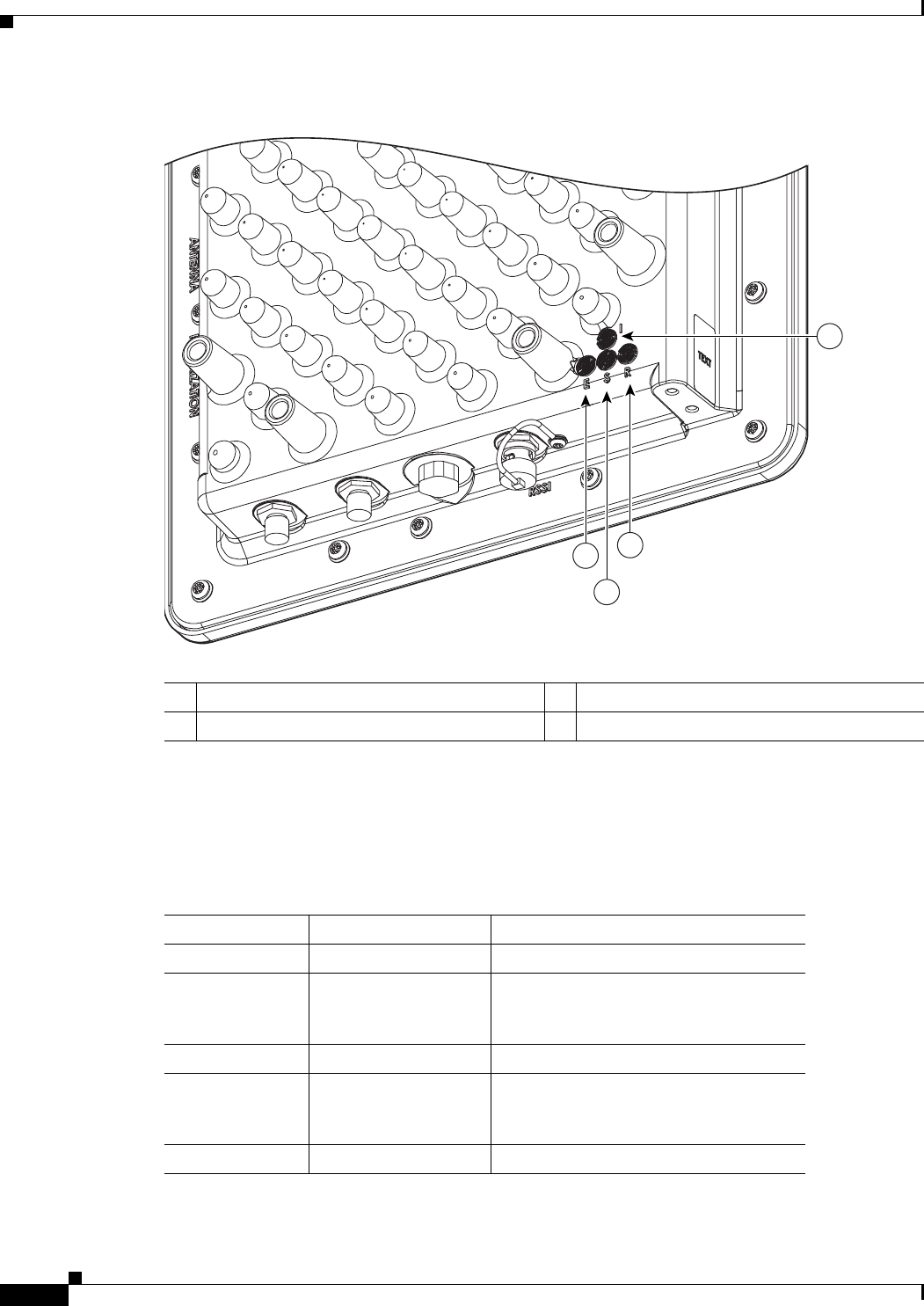
DRAFT - CISCO CONFIDENTIAL
3-4
Cisco Aironet 1400 Series Wireless Bridge Hardware Installation Guide
OL-4072-01
Chapter 3 Mounting and Alignment Overview
Bridge LED Indicators
Figure 1 LED and Connector Locations
When the bridge is initially powered-up, installation mode is activated and the bridge attempts to
associate to a root bridge for 60 seconds. If it is unable to associate with a root bridge, it automatically
assumes the root bridge role. The Install LED provides bridge association status during installation mode
as shown in Table 3-2.
1Ethernet LED 3Radio LED
2Status LED 4Install LED
4
13
2
88818
Table 3-2 Install LED Association Status
Install LED State Bridge State
Off Self test Startup
Amber blink Non-root, searching Not associated (non-root mode). The
bridge attempts to associate with a root
bridge for 30 seconds1.
1. Pre-configured bridges search indefinitely.
Amber solid Non-root, associated Associated (non-root mode)
Green blink Root, searching Not associated (root mode). The bridge
attempts to associate with a non-root
bridge indefinitely.
Green solid Root, associated Associated (root mode)
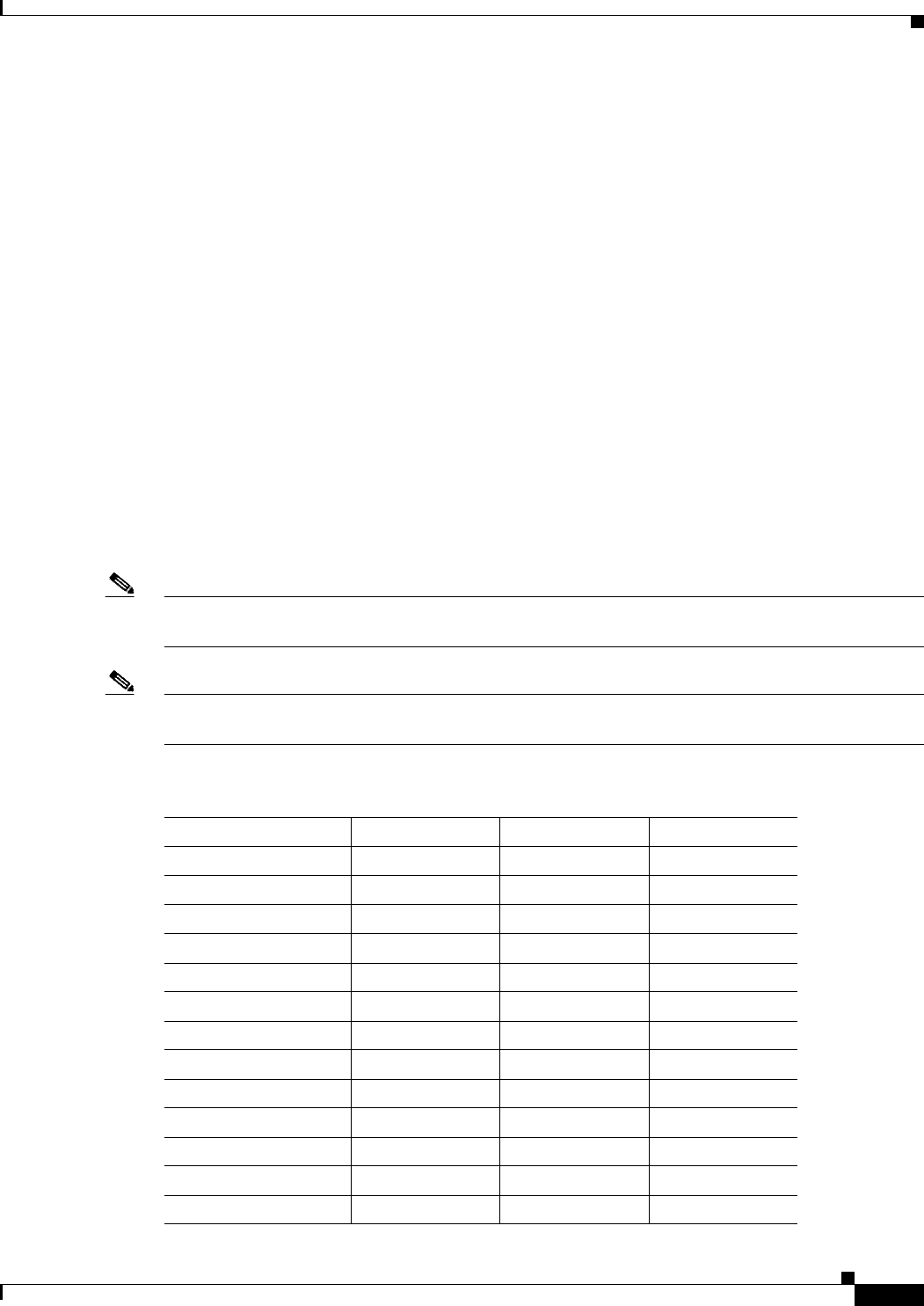
DRAFT - CISCO CONFIDENTIAL
3-5
Cisco Aironet 1400 Series Wireless Bridge Hardware Installation Guide
OL-4072-01
Chapter 3 Mounting and Alignment Overview
Aligning the Antenna Using LED Indications
You use the Install LED to determine when the bridge successfully associates with a remote bridge and
to verify its mode of operation. After association, the other three LEDs indicate signal strength (see
Table 3-3).
The startup and association sequence depends on the bridge configuration, which can be one of the
following types:
•Default—The bridge attempts to associate with a root bridge for 30 seconds. If it does not associate
with a root bridge, it then attempts to associate with a non-root bridge.
•Pre-configured—The bridge attempts to associate with a remote bridge in the configured mode,
either root or non-root. Because there are no time-outs, it is easier to align the antenna.
Aligning the Antenna Using LED Indications
You can align the integrated antenna using LEDs after the bridge successfully associates with a remote
bridge. In the installation mode before association to another bridge, the Install LED blinks amber. If the
bridge associates to a root bridge, the Install LED turns steady amber. If the bridge does not associate to
a root bridge in the first 30 seconds, the Install LED blinks green to indicate beacons are being
transmitted and the bridge is waiting for another non-root bridge to associate. After association, the
Install LED turns into steady green and the Ethernet, status, and radio LEDs then display signal strength
as shown in Table 3-3).
Note For the signal level (dBm), a smaller number represents a stronger signal because the signal level is given
as a negative value.
Note Each time you move the antenna, you must wait approximately 20 seconds before the LED patterns are
valid.
Table 3-3 LED Installation Mode Signal Strength Display
Signal Level (dBm) Ethernet LED Status LED Radio LED
>-44 On On On
-47 to -44 Fast blink1On On
-50 to -47 Medium blink2On On
-53 to -50 Slow blink3On On
-54 to -53 Off On On
-57 to -54 Off Fast blink1On
-60 to -57 Off Medium blink2On
-63 to -60 Off Slow blink3On
-66 to -63 Off Off On
-69 to -66 Off Off Fast blink1
-72 to -69 Off Off Medium blink2
-75 to -72 Off Off Slow blink3
< -75 Off Off Off
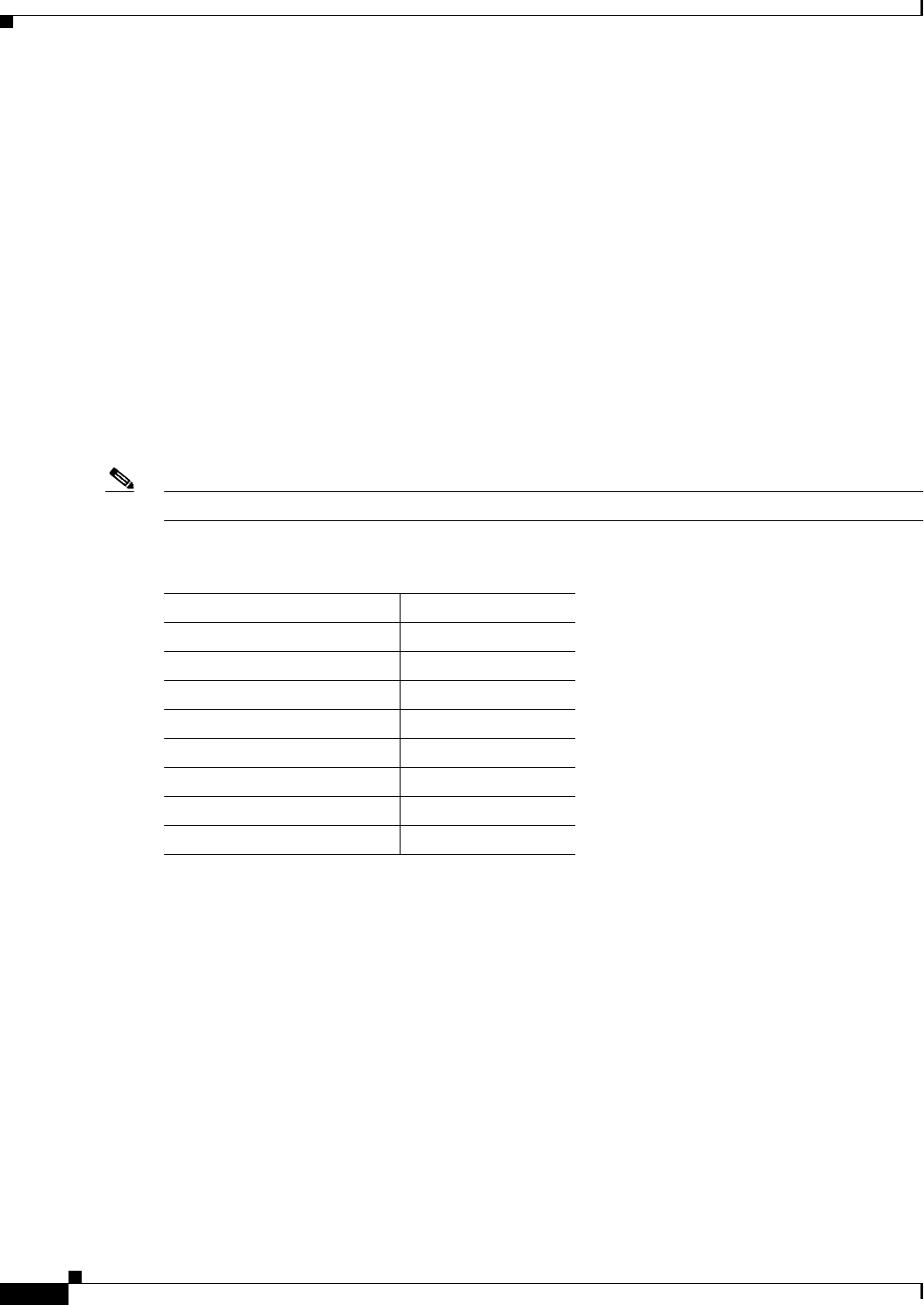
DRAFT - CISCO CONFIDENTIAL
3-6
Cisco Aironet 1400 Series Wireless Bridge Hardware Installation Guide
OL-4072-01
Chapter 3 Mounting and Alignment Overview
Aligning the Antenna Using the RSSI Voltage
When using LEDs to maximize the signal, you adjust the antenna until as many LEDs as possible are
turned-on and the rest are blinking as fast as possible.
Aligning the Antenna Using the RSSI Voltage
The RSSI port outputs a DC voltage that is proportional to the received signal level. The RSSI voltage
is available whenever a signal is present, regardless of the bridge mode (installation or normal),
association status, or pre-configuration role setting. The RSSI voltage provides an instantaneous reading
as you move the antenna. The RSSI port is a female BNC connector on the bridge housing (see Figure 1).
The RSSI voltage increases linearly with signal level as shown in Table 4.
Note A larger RSSI voltage reading indicates a stronger signal.
The voltage varies from 0 to 2.7 volts for signals between -90 and -20 dBm, respectively. The accuracy
over temperature and component variations is ± 4dB. To obtain RSSI readings, you can use any
convenient voltmeter connected to the RSSI port using a cable with a male BNC connector.
1. Slow blinking rate of 1 Hz/sec.
2. Medium blinking rate of 2 Hz/sec.
3. Fast blinking rate of 4 Hz/sec.
Table 4 RSSI Voltage Levels
Nominal Signal Level (dBm) RSSI Reading (volts)
-20 or greater 2.70
-30 2.31
-40 1.93
-50 1.54
-60 1.16
-70 0.77
-80 0.39
-90 or less 0.00

CHAPTER
DRAFT - CISCO CONFIDENTIAL
4-1
Cisco Aironet 1400 Series Wireless Bridge Hardware Installation Guide
OL-4072-01
4
Configuring the Bridge for the First Time
This chapter describes how to configure basic settings on your bridge for the first time. The contents of
this chapter are similar to the instructions in the quick start guide that shipped with your bridge. You can
configure all the settings described in this chapter using the CLI, but it might be simplest to browse to
the bridge’s web-browser interface to complete the initial configuration and then use the CLI to enter
additional settings for a more detailed configuration.
This chapter contains these sections:
•Before You Start, page 4-2
•Obtaining and Assigning an IP Address, page 4-3
•Connecting to the Bridge Locally, page 4-3
•Assigning Basic Settings, page 4-4
•What To Do Next, page 4-8
•Using the IP Setup Utility, page 4-9
•Assigning an IP Address Using the CLI, page 4-12
•Using a Telnet Session to Access the CLI, page 4-12

DRAFT - CISCO CONFIDENTIAL
4-2
Cisco Aironet 1400 Series Wireless Bridge Hardware Installation Guide
OL-4072-01
Chapter 4 Configuring the Bridge for the First Time
Before You Start
Before You Start
Before you install the bridge, make sure you are using a computer connected to the same network as the
bridge, and obtain the following information:
•The following information from your network system administrator:
–
A system name
–
The case-sensitive wireless service set identifier (SSID) for your radio network
–
If not connected to a DHCP server, a unique IP address for your bridge (such as 172.17.255.115)
–
If the bridge is not on the same subnet as your PC, a default gateway address and subnet mask
–
A Simple Network Management Protocol (SNMP) community name and the SNMP file
attribute (if SNMP is in use)
•If you use IPSU to find or assign the bridge IP address, the MAC address from the label on the
bottom of the bridge (such as 00164625854c)
Resetting the Bridge to Default Settings
If you need to start over during the initial setup process, follow these steps to reset the bridge to factory
default settings using the power injector’s Mode button:
Step 1 Disconnect the power jack from the power injector.
Step 2 Press and hold the power injector’s MODE button while you reconnect the power jack.
Step 3 Hold the MODE button until the Status LED turns amber (approximately 1 to 3 seconds), and release the
button. All bridge settings return to factory defaults.
You can also use the web-browser interface to reset the bridge to defaults. Follow these steps to return
to default settings using the web-browser interface:
Step 1 Open your Internet browser. You must use Microsoft Internet Explorer (version 5.x or later) or Netscape
Navigator (version 4.x).
Step 2 Enter the bridge’s IP address in the browser address line and press Enter. An Enter Network Password
window appears.
Step 3 Enter your username in the User Name field. The default username is Cisco.
Step 4 Enter the bridge password in the Password field and press Enter. The default password is Cisco. The
Summary Status page appears.
Step 5 Click System Software and the System Software screen appears.
Step 6 Click System Configuration and the System Configuration screen appears.
Step 7 Click the Default button.
Note If the bridge is configured with a static IP address, the IP address will not be changed.

DRAFT - CISCO CONFIDENTIAL
4-3
Cisco Aironet 1400 Series Wireless Bridge Hardware Installation Guide
OL-4072-01
Chapter 4 Configuring the Bridge for the First Time
Obtaining and Assigning an IP Address
Obtaining and Assigning an IP Address
To browse to the bridge’s Express Setup page, you must either obtain or assign the bridge’s IP address
using one of the following methods:
•Use default address 10.0.0.1 when you connect to the bridge locally. For detailed instructions, see
the “Connecting to the Bridge Locally” section on page 4-3.
•Use a DHCP server (if available) to automatically assign an IP address. You can find out the
DHCP-assigned IP address using one of the following methods:
–
Provide your organization’s network administrator with your bridge’s Media Access Control
(MAC) address. Your network administrator will query the DHCP server using the MAC
address to identify the IP address. The bridge’s MAC address is on label attached to the bottom
of the bridge.
–
Use the Cisco IP Setup Utility (IPSU) to identify the assigned address. You can also use IPSU
to assign an IP address to the bridge if it did not receive an IP address from the DHCP server.
IPSU runs on most Microsoft Windows operating systems: Windows 9x, 2000, Me, NT, and XP.
You can download IPSU from the Software Center on Cisco.com. For additional information
refer to the “Obtaining and Installing IPSU” section on page 4-9.
Connecting to the Bridge Locally
If you need to configure the bridge locally (without connecting the bridge’s power injector to a wired
LAN), you can connect a PC to the power injector’s Ethernet port using a Category 5 Ethernet cable. You
can use a local connection to the Ethernet port much as you would use a serial port connection.
Note You do not need a special crossover cable to connect your PC to the bridge’s power injector; you
can use either a straight-through cable or a crossover cable.
-----Can someone verify the following DHCP Server statement-----
If the bridge is configured with default values and not connected to a DHCP server or cannot obtain an
IP address, it defaults to IP address 10.0.0.1 and becomes a mini-DHCP server. In that capacity, the
bridge provides up to twenty? IP addresses between 10.0.0.11 and 10.0.0.30 to an Ethernet-capable PC
connected to the power injector’s Ethernet port.
The mini-DHCP server feature is disabled automatically when you assign a static IP address to the
bridge.
Caution When a bridge with default settings is connected on a wired LAN and does not receive an IP address
from a DHCP server, the bridge provides an IP address to any DHCP requests it receives.
Follow these steps to connect to the bridge locally:
Step 1 Make sure that the PC you intend to use is configured to obtain an IP address automatically, or manually
assign it an IP address from 10.0.0.31 to 10.0.0.40. Connect your PC to the power injector using a
Category 5 Ethernet cable. You can use either a crossover cable or a straight-through cable.
Step 2 Power up the power injector.

DRAFT - CISCO CONFIDENTIAL
4-4
Cisco Aironet 1400 Series Wireless Bridge Hardware Installation Guide
OL-4072-01
Chapter 4 Configuring the Bridge for the First Time
Assigning Basic Settings
Step 3 Follow the steps in the “Assigning Basic Settings” section on page 4-4. If you make a mistake and need
to start over, follow the steps in the “Resetting the Bridge to Default Settings” section on page 4-2.
Step 4 After configuring the bridge, remove the Ethernet cable from your PC and connect the power injector to
your wired LAN.
Note When you connect your PC to the bridge’s power injector or reconnect your PC to the wired LAN, you
might need to release and renew the IP address on the PC. On most PCs, you can perform a release and
renew by rebooting your PC or by entering ipconfig /release and ipconfig /renew commands in a
command prompt window. Consult your PC operating instructions for detailed instructions.
Assigning Basic Settings
After you determine or assign the bridge’s IP address, you can browse to the bridge’s Express Setup page
and perform an initial configuration. Follow these steps:
Step 1 Open your Internet browser. You must use Microsoft Internet Explorer (version 5.x or later) or Netscape
Navigator (version 4.x).
Step 2 Enter the bridge’s IP address in the browser address line and press Enter. An Enter Network Password
screen appears.
Step 3 Press Tab to bypass the Username field and advance to the Password field.
Step 4 Enter the case-sensitive password Cisco and press Enter. The Summary Status page appears. Figure 4-1
shows the Summary Status page.
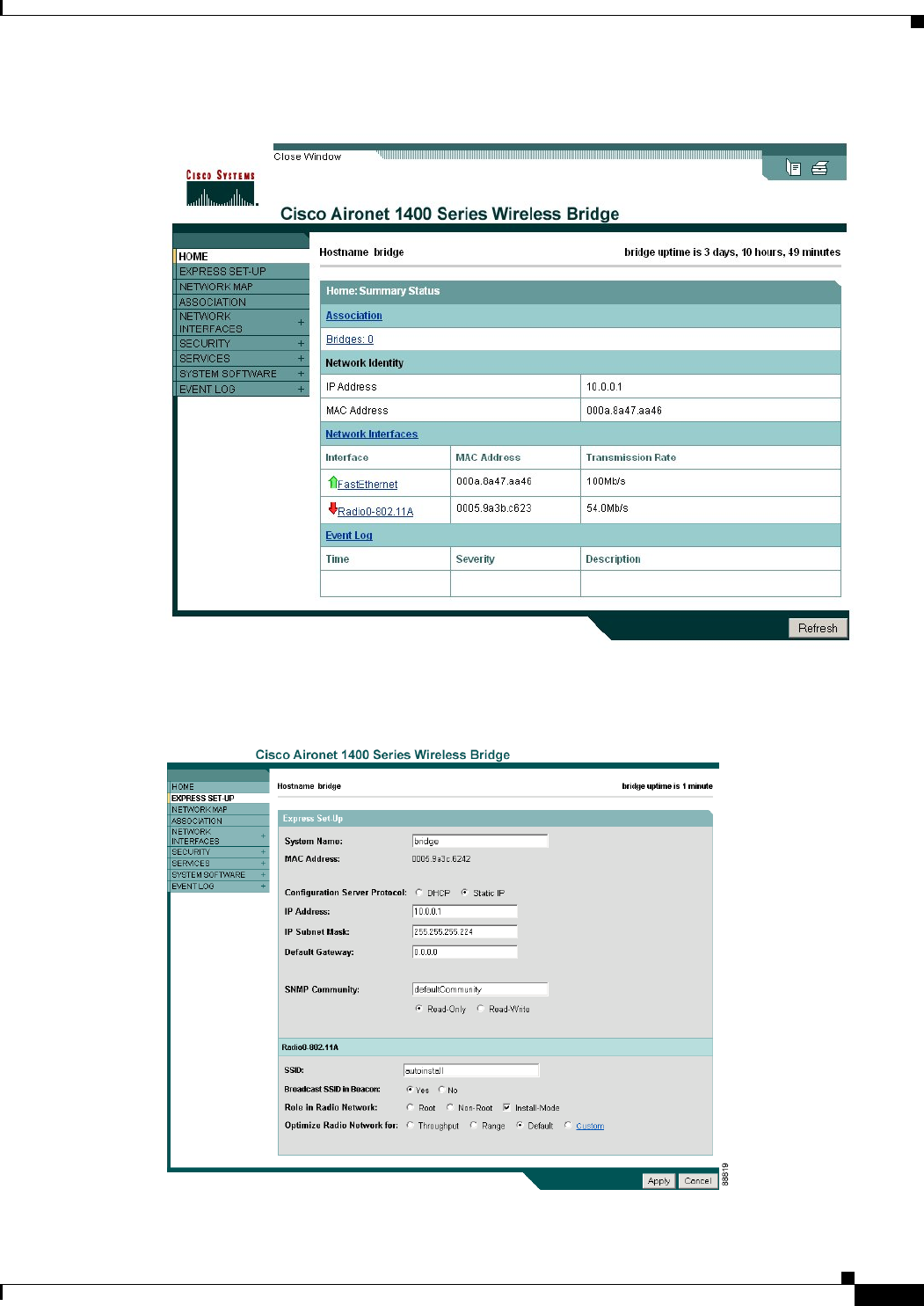
DRAFT - CISCO CONFIDENTIAL
4-5
Cisco Aironet 1400 Series Wireless Bridge Hardware Installation Guide
OL-4072-01
Chapter 4 Configuring the Bridge for the First Time
Assigning Basic Settings
Figure 4-1 Summary Status Page
Step 5 Click Express Setup. The Express Setup screen appears. Figure 4-2 shows the Express Setup page.
Figure 4-2 Express Setup Page
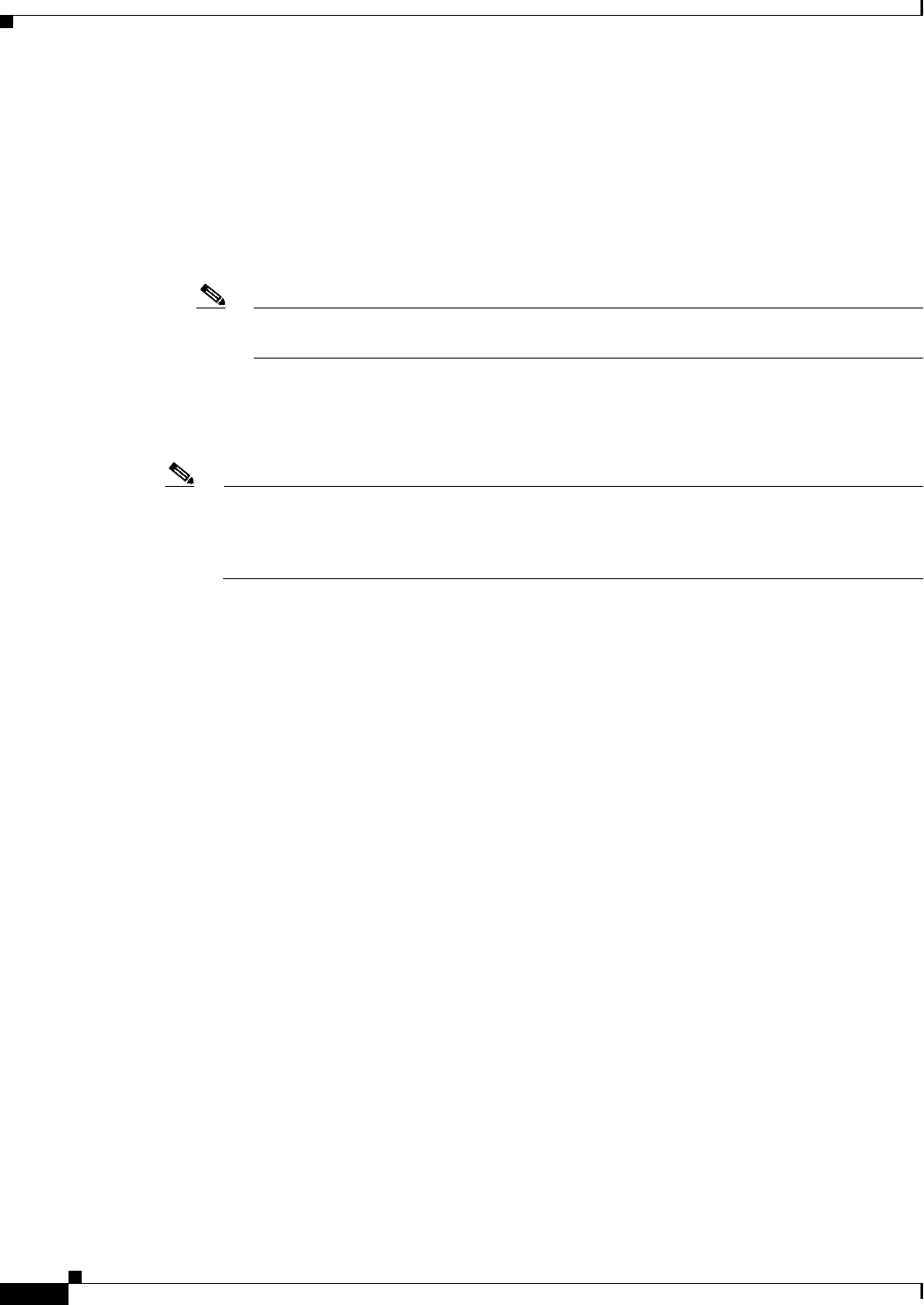
DRAFT - CISCO CONFIDENTIAL
4-6
Cisco Aironet 1400 Series Wireless Bridge Hardware Installation Guide
OL-4072-01
Chapter 4 Configuring the Bridge for the First Time
Assigning Basic Settings
Step 6 Enter the configuration settings you obtained from your system administrator. The configurable settings
include:
•System Name— The system name, while not an essential setting, helps identify the bridge on your
network. The system name appears in the titles of the management system pages.
•Configuration Server Protocol—Click on the button that matches the network’s method of IP
address assignment.
–
DHCP—IP addresses are automatically assigned by your network’s DHCP server.
Note When DHCP is enabled, the IP Address, Subnet Mask, and Default Gateway fields indicate
Negotiated by DHCP
–
Static IP—The bridge uses a static IP address that you enter in the IP address field.
•IP Address—Use this setting to assign or change the bridge’s IP address. If DHCP is enabled for
your network, leave this field blank.
Note If the bridge’s IP address changes while you are configuring the bridge using the web-browser
interface or a Telnet session over the wired LAN, you lose your connection to the bridge. If you
lose your connection, reconnect to the bridge using its new IP address. Follow the steps in the
“Resetting the Bridge to Default Settings” section on page 4-2 if you need to start over.
•IP Subnet Mask—Enter the IP subnet mask provided by your network administrator so the IP
address can be recognized on the LAN. If DHCP is enabled, leave this field blank.
•Default Gateway—Enter the default gateway IP address provided by your network administrator.
If DHCP is enabled, leave this field blank.
•SNMP Community—If your network is using SNMP, enter the SNMP Community name provided
by your network administrator and select the attributes of the SNMP data (also provided by your
network administrator).
–
Read-Only—indicates the bridge allows only SNMP read accesses. Using this option, an
SNMP user can not change bridge configuration settings.
–
Read-Write—indicates the bridge allows SNMP read and write accesses. This setting allows
an SNMP user to change the bridge configuration.
•Radio Service Set ID (SSID)—Enter the case-sensitive SSID (32 alphanumeric characters
maximum) provided by your network administrator. The SSID is a unique identifier that remote
bridges use to associate with your bridge.
•Broadcast SSID in Beacon—Use this setting to allow devices that do not specify an SSID to
associate with the bridge.
–
Yes—This is the default setting; it allows a remote bridge that does not specify an SSID to
associate with the bridge.
–
No—Remote bridges must specify an SSID to associate with the bridge. With No selected, the
SSID used by the remote bridge must match exactly the bridge’s SSID.

DRAFT - CISCO CONFIDENTIAL
4-7
Cisco Aironet 1400 Series Wireless Bridge Hardware Installation Guide
OL-4072-01
Chapter 4 Configuring the Bridge for the First Time
Assigning Basic Settings
•Role in Radio Network—Click on the checkbox and button that describes the role of the bridge on
your network.
–
Install Mode—Activates the bridge install and alignment mode. Specifies that the bridge
automatically determines the network role. If the bridge is able to associate to another root
bridge within 60 seconds, the bridge assumes a non-root bridge role. If the bridge is unable to
associate with another root bridge within 60 seconds, the bridge assumes a root bridge role.
You can also pre-configure the bridge into root or non-root modes and avoid the 60 seconds
automatic detection phase.
–
Root—Specifies the bridge connects directly to the main Ethernet LAN network and accepts
associations from other bridges.
–
Non-root—Specifies the bridge connects to a remote LAN network and must associate with the
root bridge using the wireless interface.
Note When initially powered-up, the bridge is configured in Install mode with automatic detection
activated.
•Optimize Radio Network for—Use this setting to select either preconfigured settings for the bridge
radio or customized settings for the bridge radio.
–
Throughput—Maximizes the data volume handled by the bridge but might reduce its range.
–
Range—Maximizes the bridge’s range but might reduce throughput.
–
Default—The bridge retains default radio settings that are designed to provide good range and
throughput for most bridges.
–
Custom—The bridge uses settings you enter on the Network Interfaces: Radio-802.11a Settings
page. Clicking Custom takes you to the Network Interfaces: Radio-802.11a Settings page.
Step 7 Click Apply to save your settings. If you changed the IP address, you lose your connection to the bridge.
Browse to the new IP address to reconnect to the bridge.
Note You can restore the bridge to its factory defaults by unplugging the power injector’s power jack
and plugging it back in while holding down the Mode button for a few seconds, or until the Status
LED turns amber.

DRAFT - CISCO CONFIDENTIAL
4-8
Cisco Aironet 1400 Series Wireless Bridge Hardware Installation Guide
OL-4072-01
Chapter 4 Configuring the Bridge for the First Time
What To Do Next
Default Settings on the Express Setup Page
Table 4-1 lists the default settings for the settings on the Express Setup page.
What To Do Next
After your bridge has basis settings, you need to complete your bridge’s configuration. You might need
to adjust the output power level and other network and security settings.
Output Power Level
Your bridge’s output power level might require adjustment in the following conditions:
•The bridge’s output power level must be reduced when using an external dish antenna or when using
the integrated antenna in a multipoint configuration (refer to “Maximum Power Levels” section on
page C-2).
•When bridges are located less than 328 ft (100 m) apart, you should reduce their output power to
avoid overloading the bridge’s receivers.
To configure your bridge’s output power level, refer to the Cisco Aironet 1400 Series Software
Configuration Guide.
Table 4-1 Default Settings on the Express Setup Page
Setting Default
System Name bridge
Configuration Server Protocol DHCP
IP Address Assigned by DHCP (default setting); if DHCP is disabled, the
default setting is 10.0.0.1
IP Subnet Mask Assigned by DHCP (default setting); if DHCP is disabled, the
default setting is 255.255.255.224
Default Gateway Assigned by DHCP (default setting); if DHCP is disabled, the
default setting is 0.0.0.0
SNMP defaultCommunity
Read Only
SSID autoinstall1 or tsunami2
1. During Install Mode, the SSID is autoinstall.
2. After a static IP address is assigned or the role is changed from Install, the SSID is tsunami.
Broadcast SSID in Beacon Yes
Role in Radio Network Install
Optimize Radio Network for Throughput

DRAFT - CISCO CONFIDENTIAL
4-9
Cisco Aironet 1400 Series Wireless Bridge Hardware Installation Guide
OL-4072-01
Chapter 4 Configuring the Bridge for the First Time
Using the IP Setup Utility
Protecting Your Wireless LAN
To prevent unauthorized access to your network, you need to configure security settings. Because the
bridge is a radio device, the bridge communicates beyond the physical boundaries of your building.
Refer to the Cisco Aironet 1400 Series Software Configuration Guide to configure security features to
protect your network from intruders:
•Unique SSIDs that are not broadcast in the bridge beacon.
•WEP and additional WEP features, such as TKIP and broadcast key rotation
•Dynamic WEP and EAP authentication
Using the IP Setup Utility
IPSU enables you to find the bridge’s IP address when it has been assigned by a DHCP server. You can
also use IPSU to set the bridge’s IP address and SSID if they have not been changed from the default
settings.
Note IPSU can be used only on the following operating systems: Windows 95, 98, NT, 2000, ME, or XP.
The sections below explain how to install the utility, how to use it to find the bridge’s IP address, and
how to use it to set the IP address and the SSID.
Obtaining and Installing IPSU
IPSU is available on the Cisco web site. Follow these steps to obtain and install IPSU:
Step 1 Step 1 Use your web browser to go to the Cisco Software Center at the following URL:
http://www.cisco.com/public/sw-center/sw-wireless.shtml
Step 2 Select Option #1: Aironet Wireless Software Selector.
Step 3 For the Product Type, select Wireless Bridge and click Submit.
Step 4 Select 1400 Series for the model number and click Submit.
Step 5 Select Current Release (Recommended) and click Submit.
Step 6 Under Utilities, select IPSUvxxxxxx.exe.
Step 7 On the Encryption Authorization Form, enter the requested information, read the encryption
information, and check the boxes that apply. Click Submit.
Step 8 Read and accept the terms and conditions of the Software License Agreement.
Step 9 Select the IPSU file again to download it.
Step 10 Save the file to a temporary directory on your hard drive and then exit the Internet browser.
Step 11 Double-click IPSUvxxxxxx.exe in the temporary directory to expand the file.
Step 12 Double-click Setup.exe and follow the steps provided by the installation wizard to install IPSU.
The IPSU icon appears on your computer desktop.
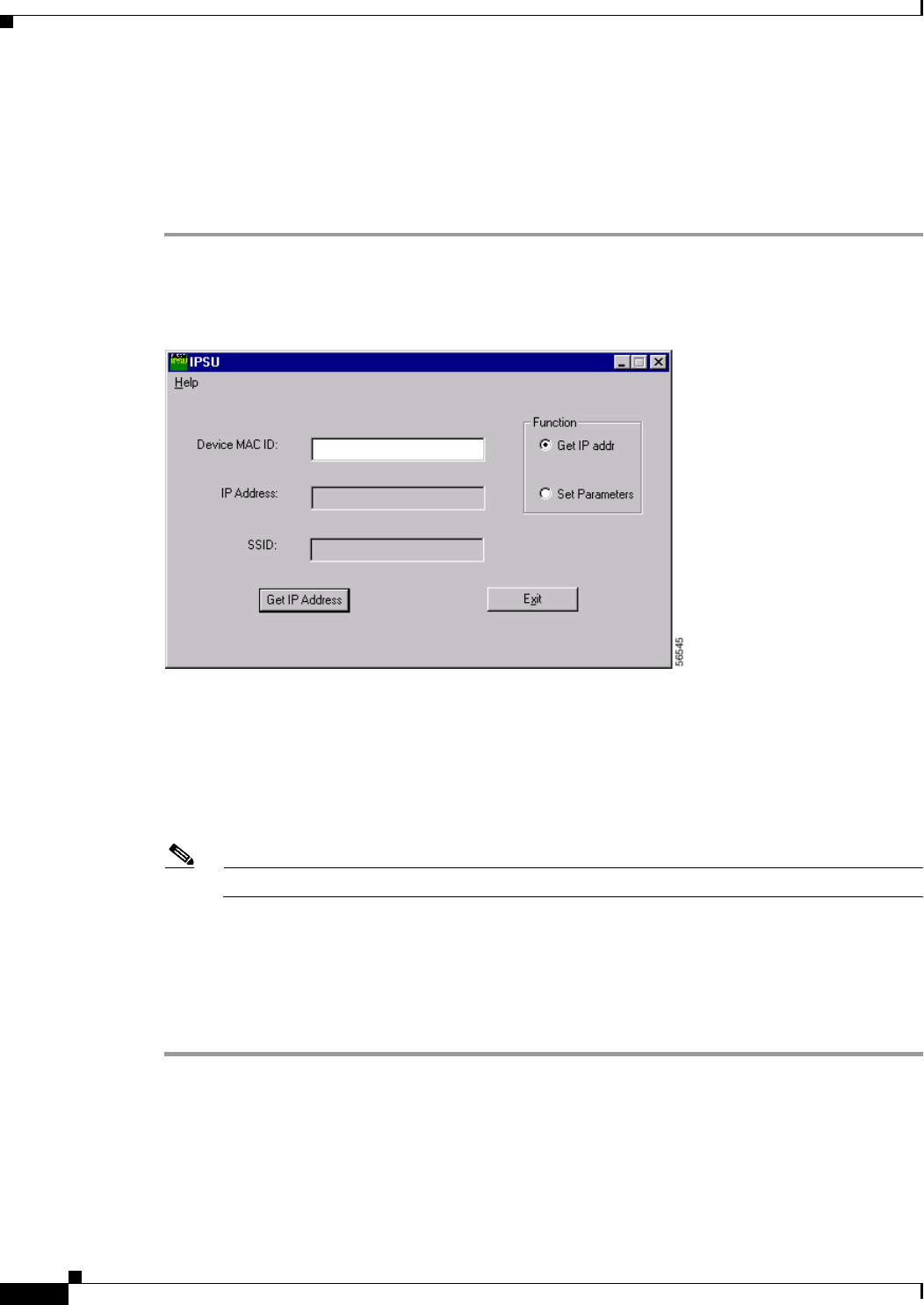
DRAFT - CISCO CONFIDENTIAL
4-10
Cisco Aironet 1400 Series Wireless Bridge Hardware Installation Guide
OL-4072-01
Chapter 4 Configuring the Bridge for the First Time
Using the IP Setup Utility
Using IPSU to Find the Bridge’s IP Address
If your bridge receives an IP address from a DHCP server, you can use IPSU to find its IP address.
Because IPSU sends a reverse-ARP request based on the bridge MAC address, you must run IPSU from
a computer on the same subnet as the bridge. Follow these steps to find the bridge’s IP address:
Step 1 Double-click the IPSU icon on your computer desktop to start the utility. The IPSU screen appears (see
Figure 4-3).
Figure 4-3 IPSU Get IP Address Screen
Step 2 When the utility window opens, make sure the Get IP address radio button in the Function box is
selected.
Step 3 Enter the bridge’s MAC address in the Device MAC ID field. The bridge’s MAC address is printed on
the label on the bottom of the unit. It should contain six pairs of hexadecimal digits. Your bridge’s MAC
address might look like the following example:
000164xxxxxx
Note The MAC address field is not case-sensitive.
Step 4 Click Get IP Address.
Step 5 When the bridge’s IP address appears in the IP Address field, write it down.
If IPSU reports that the IP address is 10.0.0.1, the default IP address, then the bridge did not receive a
DHCP-assigned IP address. To change the bridge IP address from the default value using IPSU, refer to
the “Using IPSU to Set the Bridge’s IP Address and SSID” section on page 4-10.
Using IPSU to Set the Bridge’s IP Address and SSID
If you want to change the default IP address (10.0.0.1) of the bridge, you can use IPSU. You can also set
the bridge’s SSID at the same time.
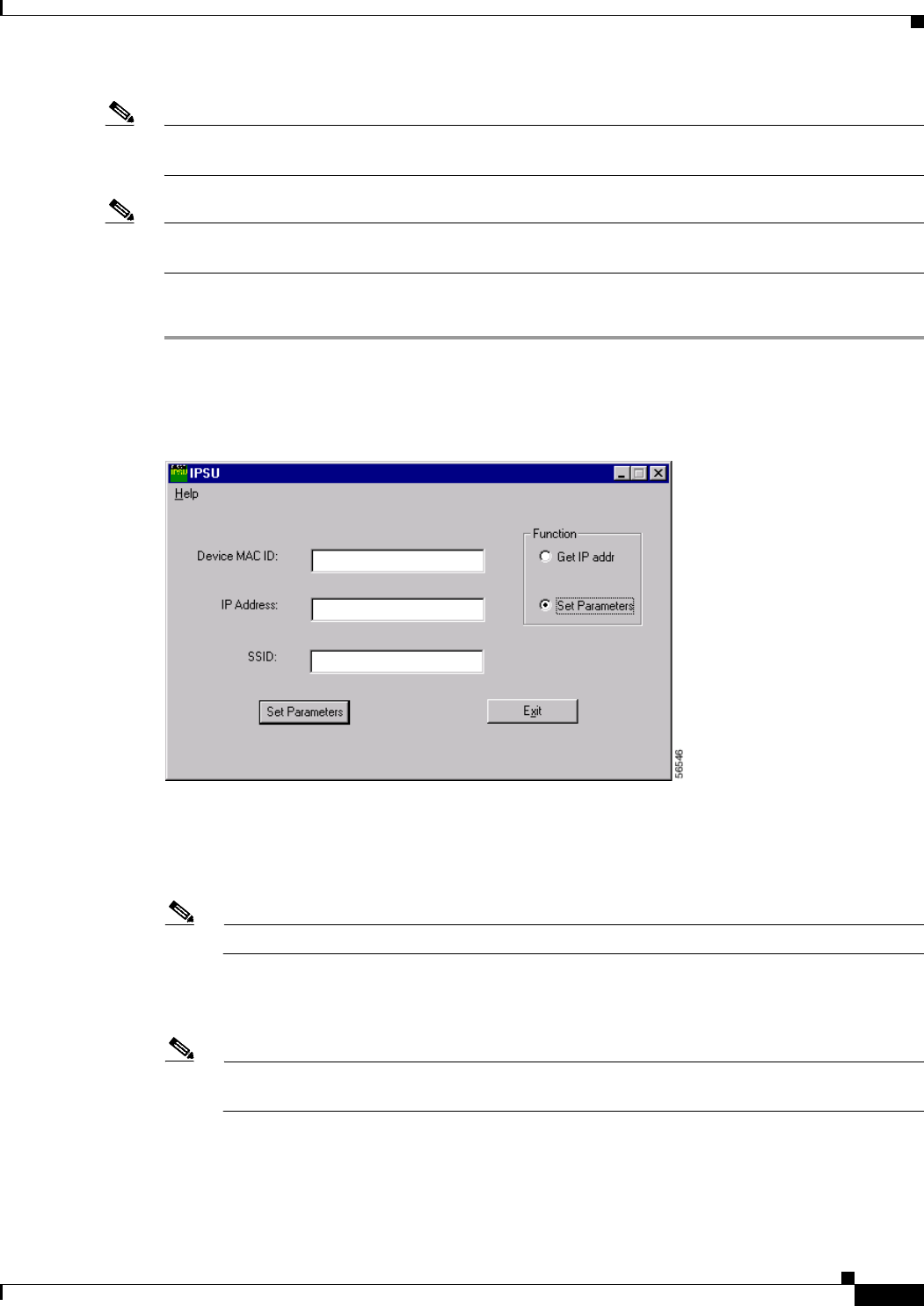
DRAFT - CISCO CONFIDENTIAL
4-11
Cisco Aironet 1400 Series Wireless Bridge Hardware Installation Guide
OL-4072-01
Chapter 4 Configuring the Bridge for the First Time
Using the IP Setup Utility
Note The computer you use to assign an IP address to the bridge must have an IP address in the same subnet
as the bridge (10.0.0.x).
Note IPSU can change the bridge’s IP address and SSID only from their default settings. After the IP address
and SSID have been changed, IPSU cannot change them again.
Follow these steps to assign an IP address and an SSID to the bridge:
Step 1 Double-click the IPSU icon on your computer desktop to start the utility.
Step 2 Click the Set Parameters radio button in the Function box (see Figure 4-4).
Figure 4-4 IPSU Set Parameters Screen
Step 3 Enter the bridge’s MAC address in the Device MAC ID field. The bridge’s MAC address is printed on
the label on the bottom of the unit. It should contain six pairs of hexadecimal digits. Your bridge’s MAC
address might look like this example:
004096xxxxxx
Note The MAC address field is not case-sensitive.
Step 4 Enter the IP address you want to assign to the bridge in the IP Address field.
Step 5 Enter the SSID you want to assign to the bridge in the SSID field.
Note You cannot set the SSID without also setting the IP address. However, you can set the IP address
without setting the SSID.
Step 6 Click Set Parameters to change the bridge’s IP address and SSID settings.
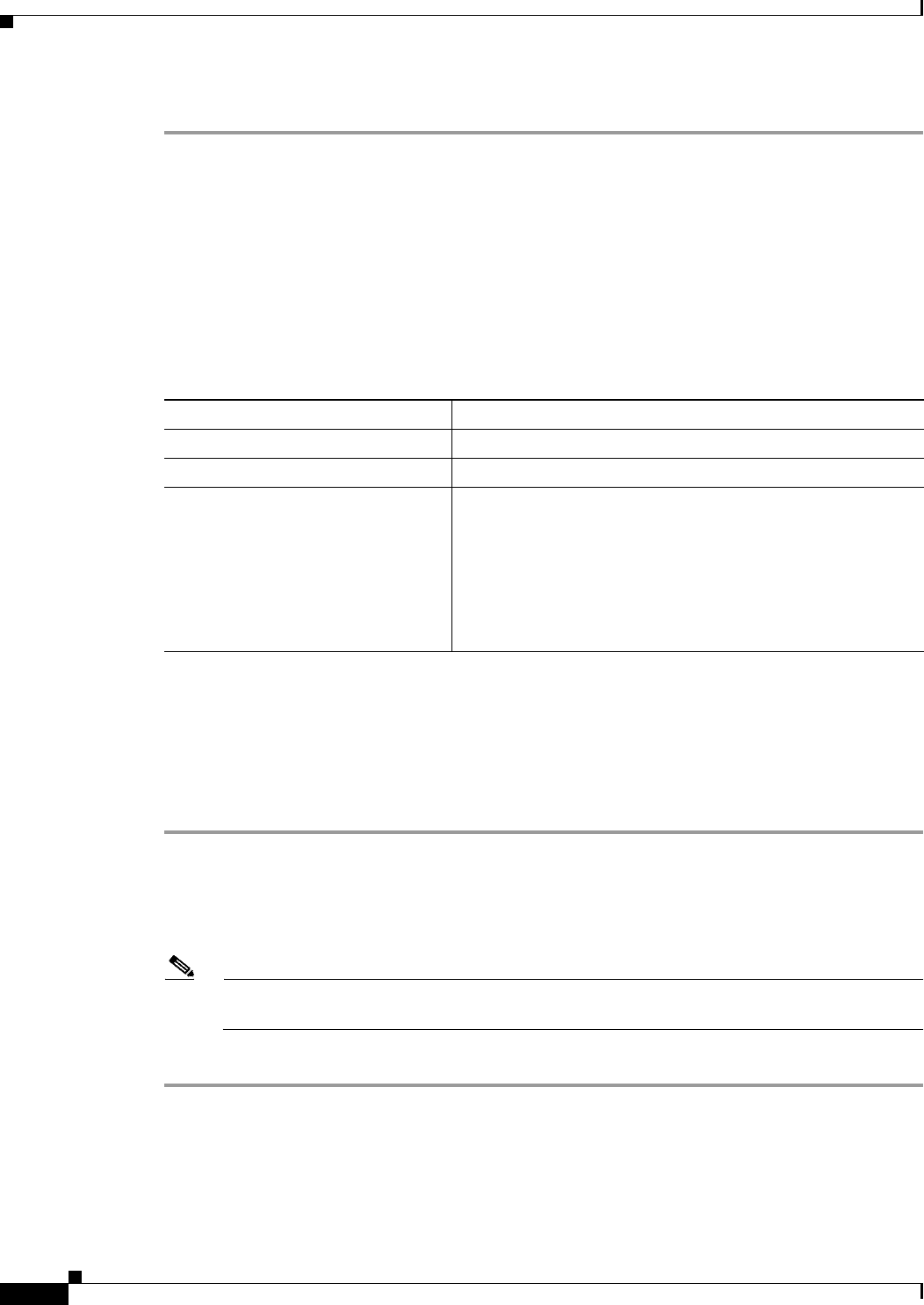
DRAFT - CISCO CONFIDENTIAL
4-12
Cisco Aironet 1400 Series Wireless Bridge Hardware Installation Guide
OL-4072-01
Chapter 4 Configuring the Bridge for the First Time
Assigning an IP Address Using the CLI
Step 7 Click Exit to exit IPSU.
Assigning an IP Address Using the CLI
When you connect the bridge to the wired LAN, the bridge links to the network using a bridge virtual
interface (BVI) that it creates automatically. Instead of tracking separate IP addresses for the bridge’s
Ethernet and radio ports, the network uses the BVI.
When you assign an IP address to the bridge using the CLI, you must assign the address to the BVI.
Beginning in privileged EXEC mode, follow these steps to assign an IP address to the bridge’s BVI:
Using a Telnet Session to Access the CLI
Follow these steps to browse to access the CLI using a Telnet session. These steps are for a PC running
Microsoft Windows with a Telnet terminal application. Check your PC operating instructions for
detailed instructions for your operating system.
Step 1 Select Start > Programs > Accessories > Telnet.
If Telnet is not listed in your Accessories menu, select Start > Run, type Telnet in the entry field, and
press Enter.
Step 2 When the Telnet window appears, click Connect and select Remote System.
Note In Windows 2000, the Telnet window does not contain drop-down menus. To start the Telnet
session in Windows 2000, type open followed by the bridge’s IP address.
Step 3 In the Host Name field, type the bridge’s IP address and click Connect.
Command Purpose
Step 1 configure terminal Enter global configuration mode.
Step 2 interface bvi1 Enter interface configuration mode for the BVI.
Step 3 ip address address
mask Assign an IP address and address mask to the BVI. This step
automatically saves the running configuration to the startup
configuration.
Note You lose your connection to the bridge when you assign
a new IP address to the BVI. If you need to continue
configuring the bridge, use the new IP address to open
another Telnet session to the bridge.

CHAPTER
DRAFT - CISCO CONFIDENTIAL
5-1
Cisco Aironet 1400 Series Wireless Bridge Hardware Installation Guide
OL-4072-01
5
Troubleshooting
This chapter provides troubleshooting procedures for basic problems with the bridge. For the most
up-to-date, detailed troubleshooting information, refer to the Cisco TAC website at the following URL
(select Hardware Support > Wireless Devices):
http://www.cisco.com/tac
Sections in this chapter include:
•Checking the LED Indicators, page 5-2
•Power Injector LED Indicators, page 5-5
•Checking Basic Configuration Settings, page 5-7
•Antenna Alignment, page 5-8
•Resetting to the Default Configuration, page 5-8
•Reloading the Bridge Image, page 5-10
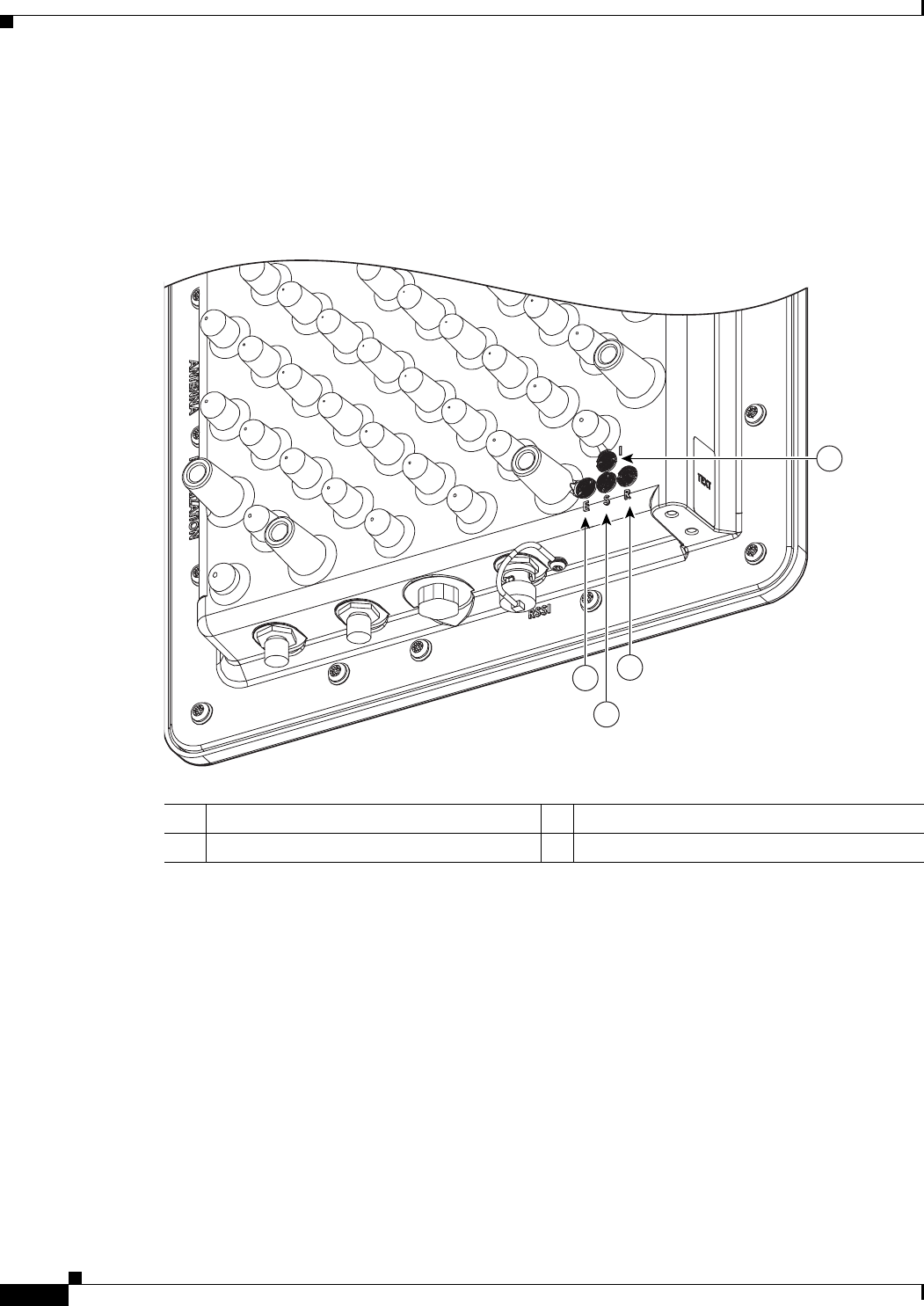
DRAFT - CISCO CONFIDENTIAL
5-2
Cisco Aironet 1400 Series Wireless Bridge Hardware Installation Guide
OL-4072-01
Chapter 5 Troubleshooting
Checking the LED Indicators
Checking the LED Indicators
If your bridge is not associating with the remote bridge, check the four LED indicators on the back panel.
You can use them to quickly assess the unit’s status. Figure 5-1 shows the indicators.
Figure 5-1 Bridge LED Indicators
The indicators signals have the following meanings (for additional details refer to Table 5-3):
•The status indicator signals bridge association status. Blinking green indicates that the bridge is not
associated with another bridge. Steady green indicates that the bridge is associated with at least one
other bridge. This indicator also provides signal strength readings during installation mode.
•The radio indicator blinks green to indicate radio traffic activity. The light is normally off, but it
blinks green whenever a packet is received or transmitted over the bridge radio link. This indicator
also provides signal strength readings during installation mode.
•The Ethernet indicator signals Ethernet traffic. This indicator blinks green when a packet is received
or transmitted over the Ethernet infrastructure. The indicator is off when the Ethernet link not
working or the port is shutdown. This indicator also provides signal strength readings during
installation mode.
•The install indicator provides installation mode association status. During installation mode, the
other indicators provide signal strength readings used for antenna alignment.
1Ethernet LED 3Radio LED
2Status LED 4Install LED
4
13
2
88818
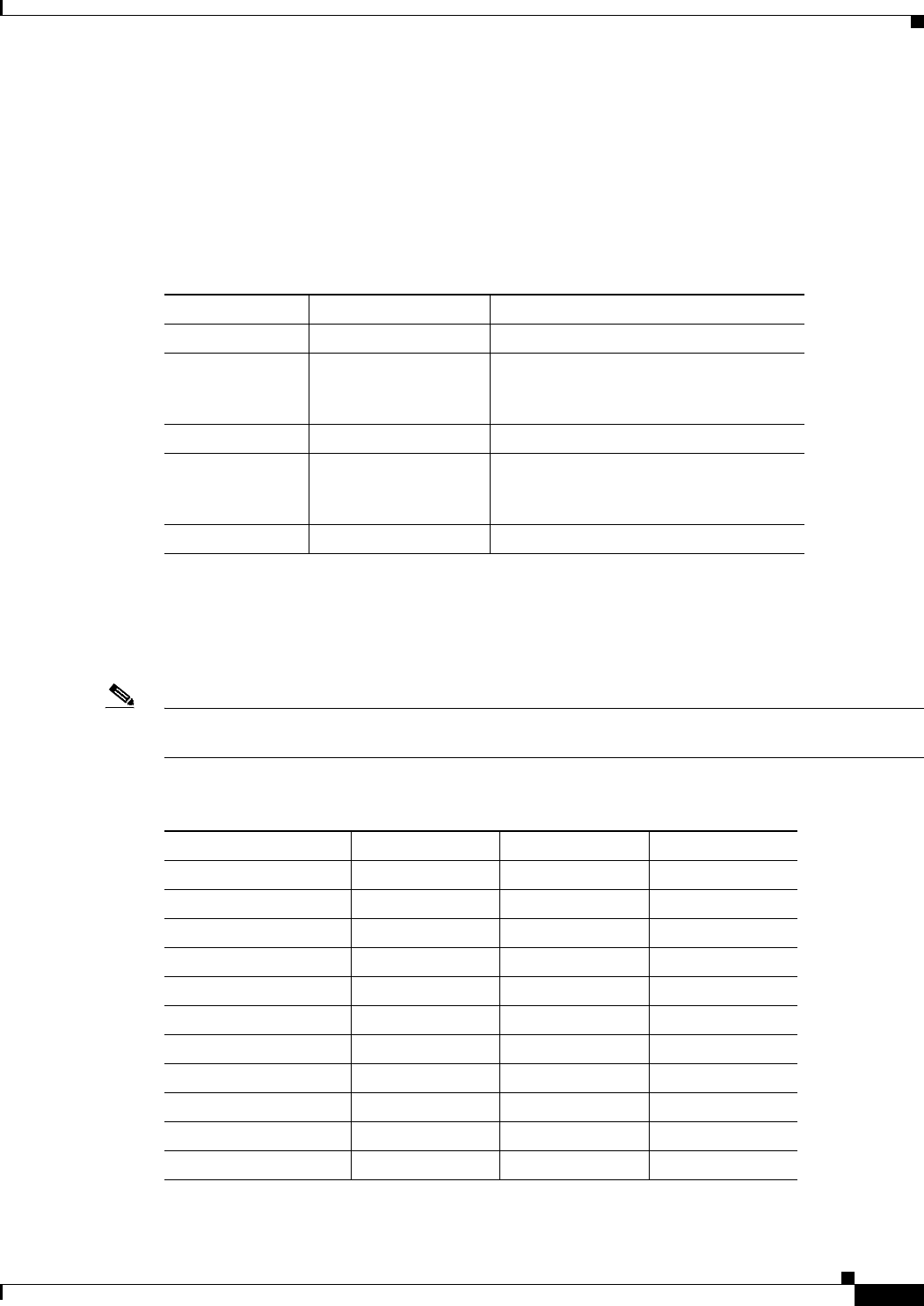
DRAFT - CISCO CONFIDENTIAL
5-3
Cisco Aironet 1400 Series Wireless Bridge Hardware Installation Guide
OL-4072-01
Chapter 5 Troubleshooting
Checking the LED Indicators
Bridge Installation Mode LED Indications
When the bridge is initially powered-up, installation mode is activated and the bridge attempts to
associate to a root bridge for 60 seconds. If it is unable to associate with a root bridge, it automatically
assumes the root bridge role. The Install LED provides bridge association status during installation mode
as shown in Table 5-1.
You use the Install LED to determine when the bridge successfully associates with a remote bridge and
to verify its mode of operation. After association, the other three LEDs indicate signal strength (see
Table 5-2).
Note For the signal level (dBm), a smaller number represents a stronger signal because the signal level is given
as a negative value.
Table 5-1 Install LED Association Status
Install LED State Bridge State
Off Self test Startup
Amber blink Non-root, searching Not associated (non-root mode). The
bridge attempts to associate with a root
bridge for 60 seconds1.
1. Pre-configured bridges search indefinitely.
Amber solid Non-root, associated Associated (non-root mode)
Green blink Root, searching Not associated (root mode). The bridge
attempts to associate with a non-root
bridge indefinitely.
Green solid Root, associated Associated (root mode)
Table 5-2 LED Installation Mode Signal Strength Display
Signal Level (dBm) Ethernet LED Status LED Radio LED
>-44 On On On
-47 to -44 Fast blink On On
-50 to -47 Medium blink On On
-53 to -50 Slow blink On On
-54 to -53 Off On On
-57 to -54 Off Fast blink On
-60 to -57 Off Medium blink On
-63 to -60 Off Slow blink On
-66 to -63 Off Off On
-69 to -66 Off Off Fast blink
-72 to -69 Off Off Medium blink

DRAFT - CISCO CONFIDENTIAL
5-4
Cisco Aironet 1400 Series Wireless Bridge Hardware Installation Guide
OL-4072-01
Chapter 5 Troubleshooting
Checking the LED Indicators
When using LEDs to maximize the signal, you adjust the antenna until as many LEDs as possible are
turned-on and the rest are blinking as fast as possible. With all three LEDS turned-on, the signal is good
enough to support the maximum data rate.
Bridge Normal Mode LED Indications
During normal operation the bridge LEDs provide status information as shown in Table 5-3.
Table 5-3 Bridge Normal Mode LED Indications
-75 to -72 Off Off Slow blink
< -75 Off Off Off
Table 5-2 LED Installation Mode Signal Strength Display (continued)
Signal Level (dBm) Ethernet LED Status LED Radio LED
Ethernet
Indicator
Status
Indicator
Radio
Indicator
Meaning
Off - - Ethernet link is down or disabled
Green - - Ethernet link is operational
Blinking
green - - Transmitting and receiving Ethernet packets
Blinking
amber - - Transmitting and receiving Ethernet errors
amber - - Firmware error—You should disconnect and reconnect the
power injector power jack
- Blinking
green - Root mode—no remote bridges are associated
Non-root mode—not associated to the root bridge
You should check the SSID and security settings of all
bridges
- Green - Root mode—associated to at least one remote bridge
Non-root mode—associated to the root bridge
Normal operation
- Blinking
amber - General warning
- Amber - Loading firmware
Red Amber Red Loading Firmware error—You should disconnect and
reconnect the power injector power
- - Off Normal operation
- - Blinking
green Transmitting and receiving radio packets
- - Blinking
amber Maximum retries or buffer full occurred on the radio
interface
- - Amber Radio firmware error—You should disconnect and
reconnect power injector power
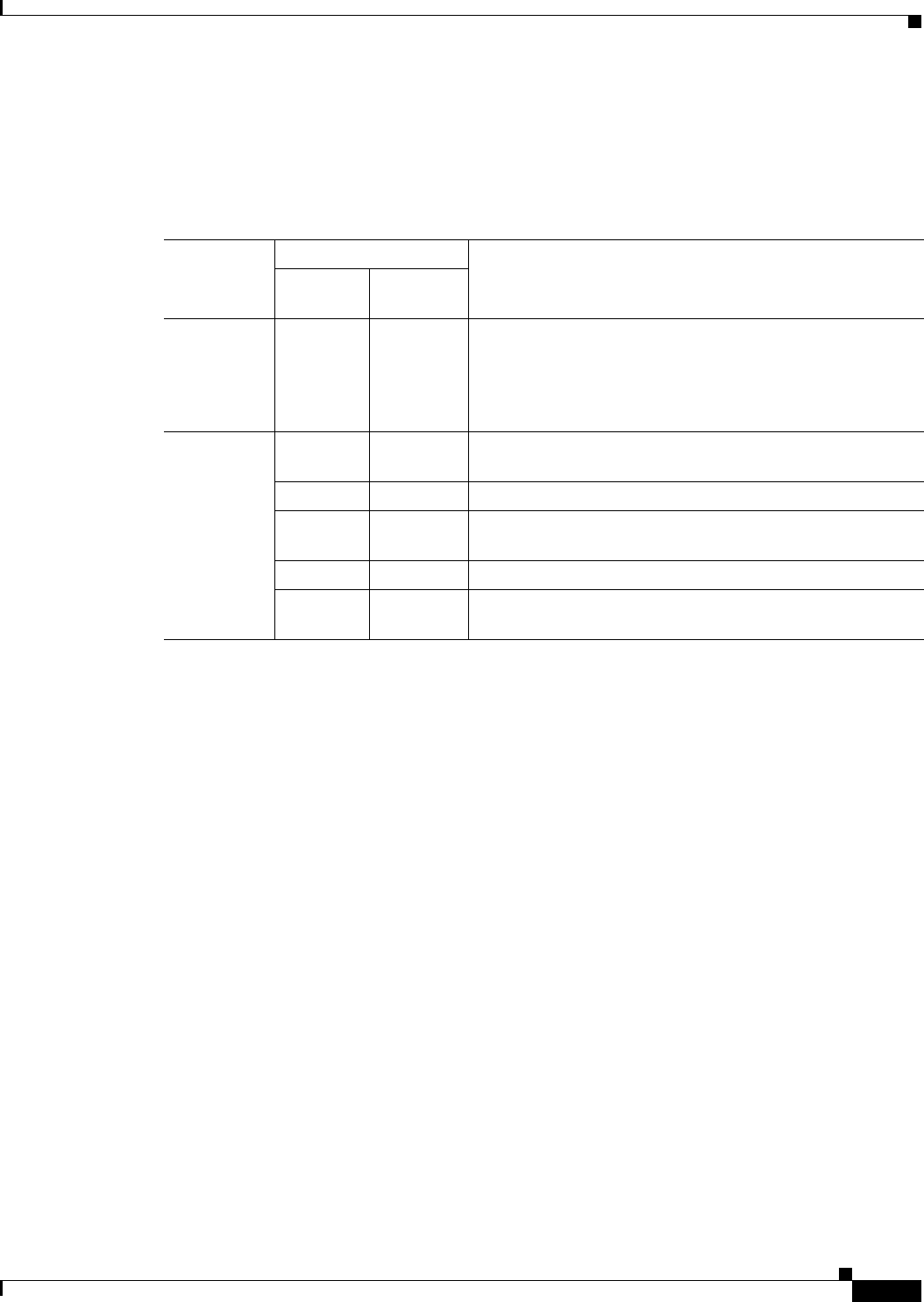
DRAFT - CISCO CONFIDENTIAL
5-5
Cisco Aironet 1400 Series Wireless Bridge Hardware Installation Guide
OL-4072-01
Chapter 5 Troubleshooting
Power Injector LED Indicators
The bridge uses a blinking code to identify various error conditions. The code sequence uses a two-digit
diagnostic code that starts with a long pause to delimit the code, followed by the indicator flashing red
to count out the first digit, then a short pause, followed by the indicator flashing red to count out the
second digit (see Table 5-4).
Power Injector LED Indicators
The power injector contains three LED indicators to provide status information on the wired Ethernet
link, the bridge Ethernet link, and the bridge status. When the power injector is powered up, it sends a
constant discovery tone on the dual-coax cables to the bridge. When the bridge is connected to the
dual-coax cables, it returns the discovery tone to the power injector. When the power injector detects the
returned discovery tone, it applies +48 VDC to the dual-coax cables to the bridge.
When power is applied to the bridge, the bridge activates the bootloader and begins the POST operations.
The bridge begins to load the IOS image when the Post operations are successfully completed. Upon
successfully loading the IOS image, the bridge initializes and tests the radio.
Table 5-4 Bridge LED Blinking Error Codes
Indicator
Blinking Codes
Description
First
Digit
Second
Digit
Ethernet 2 1 Ethernet cable problem—Verify that the cable is properly
connected and not defective. This error might also indicate a
problem with the Ethernet link. If the cable is connected
properly and not defective, contact technical support for
assistance.
Radio 1 2 Radio not detected—Contact technical support for
assistance.
1 3 Radio not ready—Contact technical support for assistance.
1 4 Radio did not start—Contact technical support for
assistance.
1 5 Radio failure—Contact technical support for assistance.
1 6 Radio did not flash its firmware—Contact technical support
for assistance.
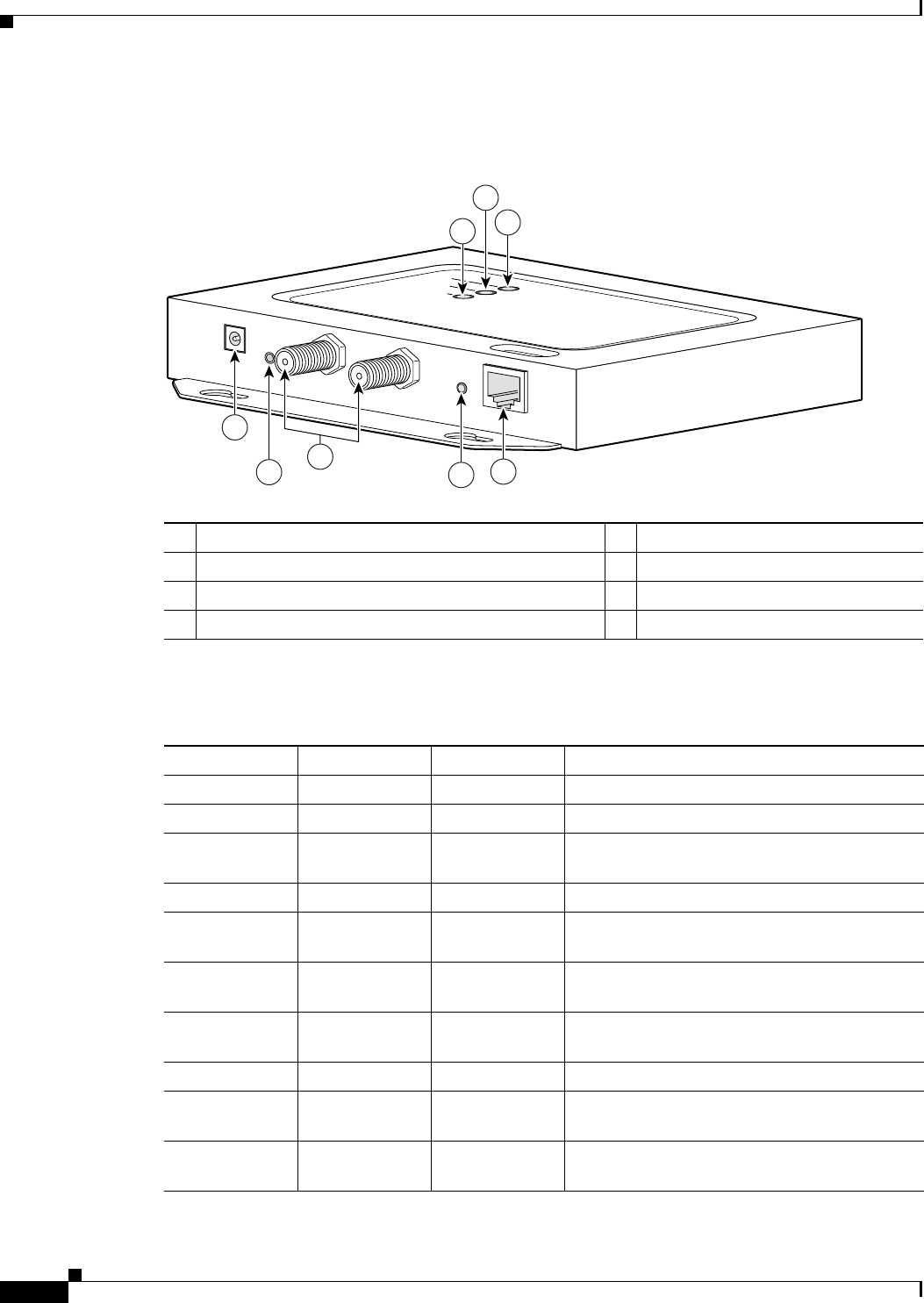
DRAFT - CISCO CONFIDENTIAL
5-6
Cisco Aironet 1400 Series Wireless Bridge Hardware Installation Guide
OL-4072-01
Chapter 5 Troubleshooting
Power Injector LED Indicators
The power injector LED indicators are shown in Figure 5-1.
Figure 5-2 Power Injector LED Indicators
The power injector LED indications are shown in Table 5-5.
1Power jack (+48VDC) 5Ethernet port (RJ45 connector)
2Power LED indicator 6Ethernet Activity LED
3Power injector dual-coax ports (F-Type connectors) 7Injector Status LED
4Mode button 8Uplink Activity LED
88820
1
245
8
7
6
3
Ipsamy opsum
Ipsamy opsum
Ipsamy opsum
Table 5-5 Power Injector LED Indications
Uplink Activity Injector Status Ethernet Activity Description
- - Off Wired LAN Ethernet link is not active
- - Green Wired LAN Ethernet link is operational
- - Blinking Green Transmitting and receiving packets over the
wired LAN Ethernet link
- - Amber Power injector internal memory error
Off - - Link between power injector and bridge is not
active
Green - - Link between power injector and bridge is
operational
Blinking Green - - Transmitting and receiving Ethernet packets
between the power injector and the bridge
Amber - - Power injector internal memory error
- Green - Bridge successfully passed Power On Self Test
(POST) and loaded the IOS image
- Blinking Green - Bridge power is active and the bridge is loading
IOS image or POST operation has started

DRAFT - CISCO CONFIDENTIAL
5-7
Cisco Aironet 1400 Series Wireless Bridge Hardware Installation Guide
OL-4072-01
Chapter 5 Troubleshooting
Checking Basic Configuration Settings
Checking Basic Configuration Settings
Mismatched basic settings are the most common causes of lost wireless connectivity. If the bridge does
not associate with a remote bridge, check the following areas.
SSID
To associate, all bridges must use the same SSID. The bridge installation mode SSID is autoinstall and
the normal mode default SSID is tsunami. You should verify the SSID value shown on the Express Setup
page is the same for all bridges. You should also verify the bridges are configured for the proper network
role; only one bridge can be configured as the root bridge.
Security Settings
Remote bridges attempting to authenticate with your bridge must support the same security options
configured in the bridge, such as WEP, EAP or LEAP, MAC address authentication, Message Integrity
Check (MIC), WEP key hashing, and 802.1X protocol versions.
If a remote bridge is unable to authenticate with your bridge, verify the security settings are same as your
bridge settings. For additional information, refer to the Cisco Aironet 1400 Series Bridge Software
Configuration Guide.
- Blinking Amber - Bridge has not been detected and bridge power
is not active
Amber Amber Amber Power injector internal memory error
Off Amber Off Bridge is resetting the configuration to defaults;
mode button has been depressed more than 2
seconds but less than 20 seconds
- Red - Image recovery mode, downloading new image;
mode button pressed more than 20 seconds
Red Red Red Power injector internal memory error
Table 5-5 Power Injector LED Indications (continued)
Uplink Activity Injector Status Ethernet Activity Description
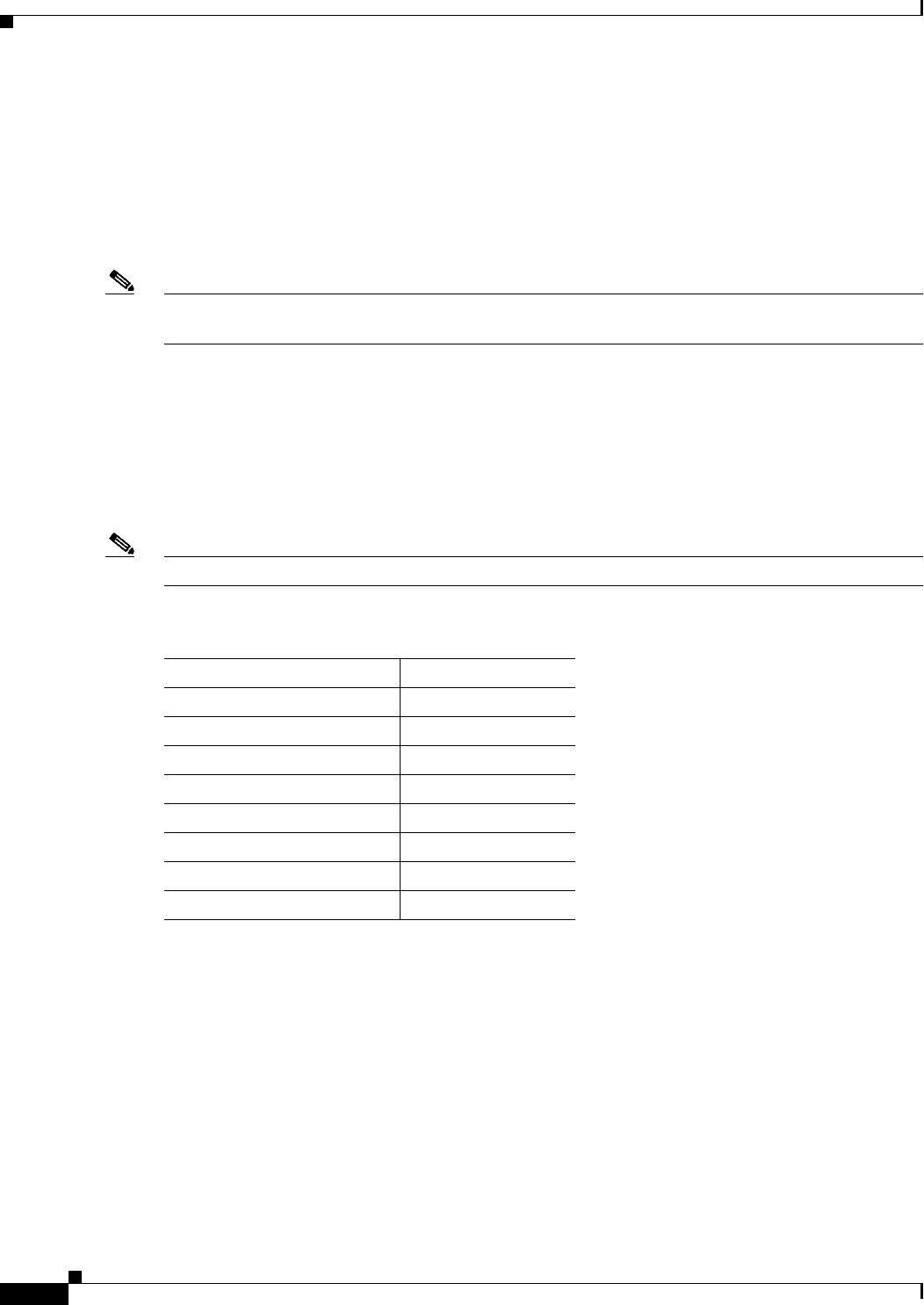
DRAFT - CISCO CONFIDENTIAL
5-8
Cisco Aironet 1400 Series Wireless Bridge Hardware Installation Guide
OL-4072-01
Chapter 5 Troubleshooting
Antenna Alignment
Antenna Alignment
If your bridges are unable to associate together, you should verify the basic configuration settings on all
bridges before attempting to verify bridge antenna alignment (refer to “Configuring the Bridge for the
First Time” section on page 4-1). If your basic configurations settings are correct, you can verify antenna
alignment by using the the RSSI port. The RSSI port can be used even when the bridges are not
associated.
Note To meet regulatory restrictions, the external antenna bridge configuration and the external antenna must
be professional installed.
The RSSI port outputs a DC voltage that is proportional to the received signal level. The RSSI voltage
is available whenever a signal is present, regardless of the bridge mode (installation or normal),
association status, or pre-configuration role setting. The RSSI voltage provides an instantaneous reading
as you move the antenna. The RSSI port is a female BNC connector on the bridge housing. To obtain
RSSI readings, you can use any convenient voltmeter connected to the RSSI port using a cable with a
male BNC connector.
The RSSI voltage increases linearly with signal level as shown in Table 6.
Note A larger RSSI voltage reading indicates a stronger signal.
The voltage varies from 0 to 2.7 volts for signals between -90 and -20 dBm, respectively.
For additional alignment information, refer to the Cisco Aironet 1400 Series Bridge Mounting
Instructions that shipped with your bridge.
Resetting to the Default Configuration
If you forget the password that allows you to configure the bridge, you may need to completely reset the
configuration. You can use the MODE button on the power injector or the web-browser interface.
Table 6 RSSI Voltage Levels
Nominal Signal Level (dBm) RSSI Reading (volts)
-20 or greater 2.70
-30 2.31
-40 1.93
-50 1.54
-60 1.16
-70 0.77
-80 0.39
-90 or less 0.00

DRAFT - CISCO CONFIDENTIAL
5-9
Cisco Aironet 1400 Series Wireless Bridge Hardware Installation Guide
OL-4072-01
Chapter 5 Troubleshooting
Resetting to the Default Configuration
Note The following steps reset all configuration settings to factory defaults, including passwords, WEP keys,
the IP address, and the SSID.
Using the MODE Button
Follow these steps to delete the current configuration and return all bridge settings to factory defaults
using the MODE button:
Step 1 Disconnect the power jack on the power injector.
Step 2 Press and hold the MODE button while you reconnect power to the power injector.
Step 3 Hold the MODE button until the Status LED turns amber (approximately 3 seconds), and release the
button.
Step 4 After the bridge reboots, you must reconfigure the bridge by using the Web browser interface, the
Telnet interface, or IOS commands.
Note The bridge is configured with the factory default values including the IP address (set to receive
an IP address using DHCP). To obtain the bridge’s new IP address, refer to the “Using the IP
Setup Utility” section on page 4-9.
Using the Web Browser Interface
Follow the steps below to delete the current configuration and return all bridge settings to the factory
defaults using the web browser interface.
Step 1 Open your Internet browser. You must use Microsoft Internet Explorer (version 5.x or later) or Netscape
Navigator (version 4.x).
Step 2 Enter the bridge’s IP address in the browser address line and press Enter. An Enter Network Password
screen appears.
Step 3 Enter your username in the User Name field.
Step 4 Enter the bridge password in the Password field and press Enter. The Summary Status page appears.
Step 5 Click System Software and the System Software screen appears.
Step 6 Click System Configuration and the System Configuration screen appears.
Step 7 Click the Default button.
Note If the bridge is configured with a static IP address, the IP address does not change.
Step 8 After the bridge reboots, you must reconfigure the bridge by using the Web browser interface, the Telnet
interface, or IOS commands.

DRAFT - CISCO CONFIDENTIAL
5-10
Cisco Aironet 1400 Series Wireless Bridge Hardware Installation Guide
OL-4072-01
Chapter 5 Troubleshooting
Reloading the Bridge Image
Reloading the Bridge Image
If your bridge has a firmware failure, you must reload the complete bridge image file using the Web
browser interface or by pressing and holding the MODE button for around 30 seconds. You can use the
browser interface if the bridge firmware is still fully operational and you want to upgrade the firmware
image. However, you can use the MODE button when the bridge has a corrupt firmware image.
Using the MODE button
You can use the MODE button on the bridge to reload the bridge image file from an active Trivial File
Transfer Protocol (TFTP) server on your network or on a PC connected to the bridge Ethernet port.
Note If your bridge experiences a firmware failure or a corrupt firmware image, indicated by three red LED
indicators, you must reload the image from a connected TFTP server.
Note This process resets all configuration settings to factory defaults, including passwords, WEP keys, the
bridge IP address, and SSIDs.
Follow the steps below to reload the bridge image file:
Step 1 The PC you intend to use must be configured with a static IP address in the range of 10.0.0.2 to 10.0.0.30.
Step 2 Make sure the PC contains the bridge image file (TBD) in the TFTP server folder and the TFTP server
is activated. For additional information, refer to the “Obtaining the Bridge Image File” and “Obtaining
the TFTP Server Software” sections.
Step 3 Connect the PC to the bridge using a Category 5 (CAT5) Ethernet cable.
Step 4 Disconnect the power jack from the power injector.
Step 5 Press and hold the MODE button while you reconnect power to the power injector.
Step 6 Hold the MODE button until the status LED turns red (approximately 20 to 30 seconds), and release the
MODE button.
Step 7 Wait until the bridge reboots as indicated by all LEDs turning green followed by the Status LED
blinking green.
Step 8 After the bridge reboots, you must reconfigure the bridge by using the Web interface, the Telnet
interface, or IOS commands.
Note The bridge is configured with the factory default values including the IP address (set to receive an IP
address using DHCP). To obtain the bridge’s new IP address, refer to the “Using the IP Setup Utility”
section on page 4-9.

DRAFT - CISCO CONFIDENTIAL
5-11
Cisco Aironet 1400 Series Wireless Bridge Hardware Installation Guide
OL-4072-01
Chapter 5 Troubleshooting
Reloading the Bridge Image
Web Browser Interface
You can also use the Web browser interface to reload the bridge image file. The Web browser interface
supports loading the image file using HTTP or TFTP interfaces.
Note Your bridge configuration is not changed when using the browser to reload the image file.
Browser HTTP Interface
The HTTP interface enables you to browse to the bridge image file on your PC and download the image
to the bridge. Follow the instructions below to use the HTTP interface:
Step 1 Open your Internet browser. You must use Microsoft Internet Explorer (version 5.x or later) or Netscape
Navigator (version 4.x).
Step 2 Enter the bridge’s IP address in the browser address line and press Enter. An Enter Network Password
screen appears.
Step 3 Enter your username in the User Name field.
Step 4 Enter the bridge password in the Password field and press Enter. The Summary Status page appears.
Step 5 Click the System Software tab and then click Software Upgrade. The HTTP Upgrade screen appears.
Step 6 Click the Browse button to locate the image file on your PC.
Step 7 Click the Upload button.
For additional information, click the Help icon on the Software Upgrade screen.
Browser TFTP Interface
The TFTP interface allows you to use a TFTP server on a network device to load the bridge image file.
Follow the instructions below to use a TFTP server:
Step 1 Open your Internet browser. You must use Microsoft Internet Explorer (version 5.x or later) or Netscape
Navigator (version 4.x).
Step 2 Enter the bridge’s IP address in the browser address line and press Enter. An Enter Network Password
screen appears.
Step 3 Enter your username in the User Name field.
Step 4 Enter the bridge password in the Password field and press Enter. The Summary Status page appears.
Step 5 Click the System Software tab and then click Software Upgrade. The HTTP Upgrade screen appears.
Step 6 Click the TFTP Upgrade tab.
Step 7 Enter the IP address for the TFTP server in the TFTP Server field.
Step 8 Enter the file name for the bridge image file in the Upload New System Image Tar File field. If the file
is located in a subdirectory of the TFTP server root directory, include the relative path of the TFTP server
root directory with the filename. If the file is located in the TFTP root directory, enter only the filename.
Step 9 Click the Upload button.

DRAFT - CISCO CONFIDENTIAL
5-12
Cisco Aironet 1400 Series Wireless Bridge Hardware Installation Guide
OL-4072-01
Chapter 5 Troubleshooting
Reloading the Bridge Image
For additional information click the Help icon on the Software Upgrade screen.
Obtaining the Bridge Image File
The bridge image file can be obtained from the Cisco.com software center using the following steps:
IPSU is available on the Cisco web site. Follow these steps to obtain and install IPSU:
Step 1 Step 1 Use your web browser to go to the Cisco Software Center at the following URL:
http://www.cisco.com/public/sw-center/sw-wireless.shtml
Step 2 Select Option #1: Aironet Wireless Software Selector.
Step 3 For the Product Type, select Wireless Bridge and click Submit.
Step 4 Select 1400 Series for the model number and click Submit.
Step 5 Select Current Release (Recommended) and click Submit.
Step 6 Select the latest bridge image file (TBD).
Step 7 On the Encryption Authorization Form, enter the requested information, read the encryption
information, and check the boxes that apply. Click Submit.
Step 8 Read and accept the terms and conditions of the Software License Agreement.
Step 9 Select the latest bridge image file again to download it.
Step 10 Save the file to a directory on your hard drive and then exit the Internet browser.
Obtaining the TFTP Server Software
You can download TFTP server software from several web sites. Cisco recommends the shareware TFTP
utility available at this URL:
http://tftpd32.jounin.net
Follow the instructions on the website for installing and using the utility.

DRAFT - CISCO CONFIDENTIAL
A-1
Cisco Aironet 1400 Series Wireless Bridge Hardware Installation Guide
OL-4072-01
APPENDIX
A
Translated Safety Warnings
This appendix provides translations of the safety warnings that appear in this publication. These
translated warnings apply to other documents in which they appear in English. The following safety
warnings appear in this appendix:
•Installation Warning, page A-3
•Installation and Grounding Warning, page A-4
•Circuit Breaker Warning, page A-6
•Ground Conductor Warning, page A-7
•Installation Warning, page A-9
•Lightning Activity Warning, page A-10
•Explosive Device Proximity Warning, page A-11
•Bridge Antenna Exposure Limits -TBD, page A-11

DRAFT - CISCO CONFIDENTIAL
A-2
Cisco Aironet 1400 Series Wireless Bridge Hardware Installation Guide
OL-4072-01
Appendix A Translated Safety Warnings
Warning Definition
Warning Definition
Warning
This warning symbol means danger. You are in a situation that could cause bodily injury. Before
you work on any equipment, be aware of the hazards involved with electrical circuitry and be
familiar with standard practices for preventing accidents. (To see translations of the warnings
that appear in this publication, refer to the appendix “Translated Safety Warnings.”)
Waarschuwing
Dit waarschuwingssymbool betekent gevaar. U verkeert in een situatie die lichamelijk letsel kan
veroorzaken. Voordat u aan enige apparatuur gaat werken, dient u zich bewust te zijn van de bij
elektrische schakelingen betrokken risico’s en dient u op de hoogte te zijn van standaard
maatregelen om ongelukken te voorkomen. (Voor vertalingen van de waarschuwingen die in deze
publicatie verschijnen, kunt u het aanhangsel “Translated Safety Warnings” (Vertalingen van
veiligheidsvoorschriften) raadplegen.)
Varoitus
Tämä varoitusmerkki merkitsee vaaraa. Olet tilanteessa, joka voi johtaa ruumiinvammaan. Ennen
kuin työskentelet minkään laitteiston parissa, ota selvää sähkökytkentöihin liittyvistä vaaroista
ja tavanomaisista onnettomuuksien ehkäisykeinoista. (Tässä julkaisussa esiintyvien varoitusten
käännökset löydät liitteestä "Translated Safety Warnings" (käännetyt turvallisuutta koskevat
varoitukset).)
Attention
Ce symbole d’avertissement indique un danger. Vous vous trouvez dans une situation pouvant en-
traîner des blessures. Avant d’accéder à cet équipement, soyez conscient des dangers posés par
les circuits électriques et familiarisez-vous avec les procédures courantes de prévention des ac-
cidents. Pour obtenir les traductions des mises en garde figurant dans cette publication, veuillez
consulter l’annexe intitulée «Translated Safety Warnings » (Traduction des avis de sécurité).
Warnung
Dieses Warnsymbol bedeutet Gefahr. Sie befinden sich in einer Situation, die zu einer Körperver-
letzung führen könnte. Bevor Sie mit der Arbeit an irgendeinem Gerät beginnen, seien Sie sich der
mit elektrischen Stromkreisen verbundenen Gefahren und der Standardpraktiken zur Vermeidung
von Unfällen bewußt. (Übersetzungen der in dieser Veröffentlichung enthaltenen Warnhinweise
finden Sie im Anhang mit dem Titel “Translated Safety Warnings” (Übersetzung der Warnhin-
weise).)
Avvertenza
Questo simbolo di avvertenza indica un pericolo. Si è in una situazione che può causare infortuni.
Prima di lavorare su qualsiasi apparecchiatura, occorre conoscere i pericoli relativi ai circuiti
elettrici ed essere al corrente delle pratiche standard per la prevenzione di incidenti. La traduz-
ione delle avvertenze riportate in questa pubblicazione si trova nell’appendice, “Translated Safe-
ty Warnings” (Traduzione delle avvertenze di sicurezza).
Advarsel
Dette varselsymbolet betyr fare. Du befinner deg i en situasjon som kan føre til personskade. Før
du utfører arbeid på utstyr, må du være oppmerksom på de faremomentene som elektriske kretser
innebærer, samt gjøre deg kjent med vanlig praksis når det gjelder å unngå ulykker. (Hvis du vil
se oversettelser av de advarslene som finnes i denne publikasjonen, kan du se i vedlegget "Trans-
lated Safety Warnings" [Oversatte sikkerhetsadvarsler].)
Aviso
Este símbolo de aviso indica perigo. Encontra-se numa situação que lhe poderá causar danos fi-
sicos. Antes de começar a trabalhar com qualquer equipamento, familiarize-se com os perigos
relacionados com circuitos eléctricos, e com quaisquer práticas comuns que possam prevenir
possíveis acidentes. (Para ver as traduções dos avisos que constam desta publicação, consulte
o apêndice “Translated Safety Warnings” - “Traduções dos Avisos de Segurança”).

DRAFT - CISCO CONFIDENTIAL
A-3
Cisco Aironet 1400 Series Wireless Bridge Hardware Installation Guide
OL-4072-01
Appendix A Translated Safety Warnings
Installation Warning
Installation Warning
¡Advertencia!
Este símbolo de aviso significa peligro. Existe riesgo para su integridad física. Antes de manipu-
lar cualquier equipo, considerar los riesgos que entraña la corriente eléctrica y familiarizarse
con los procedimientos estándar de prevención de accidentes. (Para ver traducciones de las ad-
vertencias que aparecen en esta publicación, consultar el apéndice titulado “Translated Safety
Warnings.”)
Varning!
Denna varningssymbol signalerar fara. Du befinner dig i en situation som kan leda till personska-
da. Innan du utför arbete på någon utrustning måste du vara medveten om farorna med elkretsar
och känna till vanligt förfarande för att förebygga skador. (Se förklaringar av de varningar som
förekommer i denna publikation i appendix "Translated Safety Warnings" [Översatta säkerhets-
varningar].)
Warning
Only trained and qualified personnel should be allowed to install, replace, or service
this equipment.
Waarschuwing
Deze apparatuur mag alleen worden geïnstalleerd, vervangen of hersteld door bevoegd
geschoold personeel.
Varoitus
Tämän laitteen saa asentaa, vaihtaa tai huoltaa ainoastaan koulutettu ja laitteen
tunteva henkilökunta.
Attention
Il est vivement recommandé de confier l'installation, le remplacement et la maintenance de ces
équipements à des personnels qualifiés et expérimentés.
Warnung
Das Installieren, Ersetzen oder Bedienen dieser Ausrüstung sollte nur geschultem, qualifiziertem
Personal gestattet werden.
Figyelem!
A berendezést csak szakképzett személyek helyezhetik üzembe, cserélhetik és tarthatják karban.
Avvertenza
Questo apparato può essere installato, sostituito o mantenuto unicamente da un personale
competente.
Advarsel
Bare opplært og kvalifisert personell skal foreta installasjoner, utskiftninger eller service på
dette utstyret.
Aviso
Apenas pessoal treinado e qualificado deve ser autorizado a instalar, substituir ou fazer a revisão
deste equipamento.
¡Advertencia!
Solamente el personal calificado debe instalar, reemplazar o utilizar este equipo.
Varning!
Endast utbildad och kvalificerad personal bör få tillåtelse att installera, byta ut eller reparera
denna utrustning.
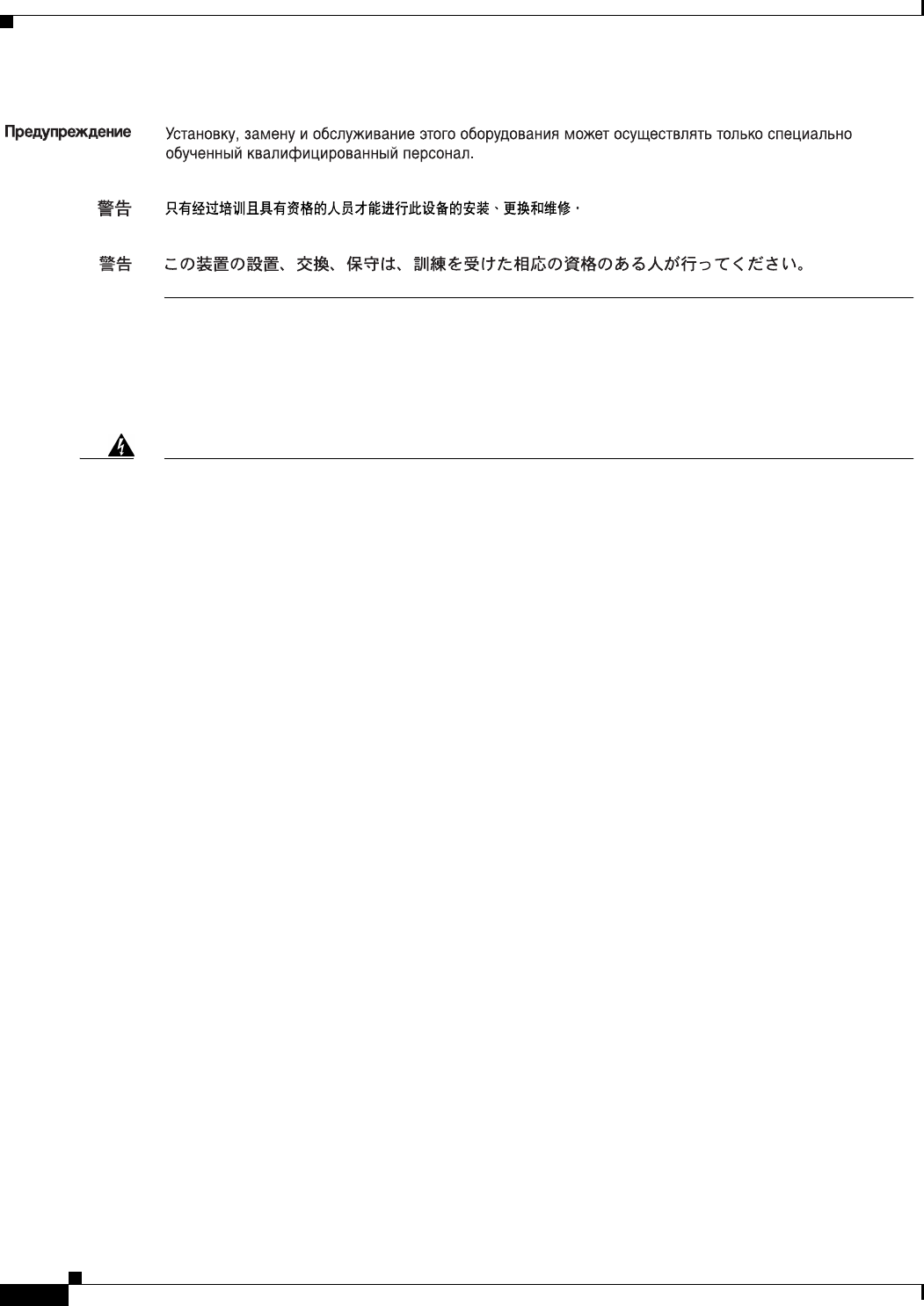
DRAFT - CISCO CONFIDENTIAL
A-4
Cisco Aironet 1400 Series Wireless Bridge Hardware Installation Guide
OL-4072-01
Appendix A Translated Safety Warnings
Installation and Grounding Warning
Installation and Grounding Warning
Warning
Do not locate the antenna near overhead power lines or other electric light or power circuits, or
where it can come into contact with such circuits. When installing the antenna, take extreme care
not to come into contact with such circuits, because they may cause serious injury or death. For
proper installation and grounding of the antenna, please refer to national and local codes (for
example, U.S.:NFPA 70, National Electrical Code, Article 810, Canada: Canadian Electrical Code,
Section 54).
Waarschuwing
Zorg dat antenne niet in de buurt wordt geplaatst van langs het plafond lopende stroomkabels of
andere voorzieningen voor licht of elektriciteit of op een plaats waar contact met dergelijke
stroomvoorzieningen mogelijk is. Wees bij het installeren van de antenne voorzichtig dat u niet in
contact komt met dergelijke stroomvoorzieningen aangezien dit kan leiden to ernstig lichamelijk of
dodelijk letsel. Voor het juist installeren en aarden van de antenne, dient u de nationale en
plaatselijke verordeningen te raadplegen (bijv. in de VS NFPA 70, National Electrical Code, Artikel
810, in Canada: Canadian Electrical Code, Sectie 54).
Varoitus
Älä sijoita antennia lähelle voimajohtoja, muita sähkövalo- tai virtapiirejä tai paikkaa, jossa se voi
joutua kosketuksiin sellaisten piirien kanssa. Kun asennat antennia, varo, ettet joudu kosketuksiin
mainittujen piirien kanssa, sillä seurauksena voi olla vakava vamma tai kuolema. Tarkista antennin
asennus- ja maadoitustiedot kansallisista ja paikallisista sähkösäännöksistä (esimerkiksi
Yhdysvalloissa NFPA 70, National Electrical Code, Article 810 ja Kanadassa Canadian Electrical
Code, Section 54).
Attention
Ne placez pas l'antenne à proximité d'une ligne aérienne ou d'autres circuits d'éclairage ou
d'alimentation, ou dans un endroit où elle risque d'être en contact avec des circuits de ce type. Lors
de son installation, assurez-vous bien qu'elle ne touche pas de tels circuits car cela risquerait
d'entraîner des blessures graves, voire mortelles. Pour une installation et mise à la terre correctes
de l'antenne, veuillez consulter les codes nationaux et locaux (par exemple, États-Unis : NFPA 70,
National Electrical Code, Article 810 ; Canada : Code électrique canadien, Section 54).

DRAFT - CISCO CONFIDENTIAL
A-5
Cisco Aironet 1400 Series Wireless Bridge Hardware Installation Guide
OL-4072-01
Appendix A Translated Safety Warnings
Installation and Grounding Warning
Warnung
Platzieren Sie die Antenne nicht in der Nähe von Starkstrom-Freileitungen oder Schwach- bzw.
Starkstromkreisen oder an Stellen, wo sie damit in Kontakt kommen könnte. Gehen Sie bei der
Installation der Antenne besonders vorsichtig vor, damit Sie nicht in Kontakt mit derartigen
Stromkreisen kommt, da dies zu schweren Verletzungen sogar mit Todesfolge führen kann.
Installieren und erden Sie die Antenne sachgerecht unter Einhaltung der jeweils gültigen
Sicherheitsvorschriften (zum Beispiel USA: NFPA 70, National Electrical Code, Artikel 810 oder
Kanada: Canadian Electrical Code, Abschnitt 54).
Figyelem!
Ne helyezze az antennát elektromos felsõvezetékek és más elektromos világítási és tápellátási
áramkörök közelébe, és semmilyen olyan környezetbe, ahol ilyen áramkörökkel érintkezhet. Az
antenna felszerelésekor különösképpen ügyeljen arra, hogy ne kerüljön érintkezésbe ilyen
áramkörökkel, mert az súlyos sérülést vagy halált okozhat. Az antenna helyes üzembe helyezésével
és földelésével kapcsolatban az országos és helyi elõírások tartalmaznak útmutatást (például az
USA-ban: NFPA 70, National Electrical Code, Article 810, Kanadában: Canadian Electrical Code,
Section 54).
Avvertenza
Non sistemare l'antenna nelle vicinanze di circuiti elettrici generali o di altri circuiti di
illuminazione o di alimentazione, o dove questa possa venire a contatto con tali circuiti. Durante
l'installazione dell'antenna, prestare particolare attenzione a non entrare in contatto con tali
circuiti, in quanto questo potrebbe provocare seri danni o morte. Per una corretta installazione e
messa a terra dell'antenna, fare riferimento ai codici nazionali e locali (es. U.S.A.: NFPA 70, Codice
Elettrico Nazionale, articolo 810, Canada: Codice Elettrico Canadese, sezione 54).
Advarsel
Plasser ikke antennen nær de overliggende strømledningene eller andre lys- eller strømkretser,
eller der den kan komme i kontakt med slike kretser. Ved installering av antennen må du være ytterst
forsiktig slik at du ikke kommer i kontakt med slike kretser. Dette kan føre til alvorlig skade eller
død. For riktig installasjon og jording av antennen, se statlige og lokale forskrifter (for eksempel i
USA: NFPA 70, National Electrical Code, Article 810, og i Canada: Canadian Electrical Code,
Section 54).
Aviso
Não coloque a antena perto de linhas de alimentação, de outros circuitos ou onde possa entrar em
contato com esses circuitos. Ao instalar a antena, tenha muito cuidado para não tocar nesses
circuitos, visto que podem provocar ferimentos graves ou até a morte. Para obter informações sobre
como instalar e aterrar corretamente a antena, consulte a legislação local e nacional (por ex., U.S.:
NFPA 70, National Electrical Code, Artigo 810, Canadá: Canadian Electrical Code, Seção 54).
¡Advertencia!
No coloque la antena cerca de cables de tendido eléctrico u otros circuitos eléctricos, ni donde
pueda entrar en contacto con los mismos. Al instalar la antena, extreme las precauciones para no
entrar en contacto con dichos circuitos, ya que puede causar heridas graves e incluso la muerte.
Para instalar la antena y conectarla a tierra correctamente, consulte los códigos nacionales y
locales (p.ej., Estados Unidos: NFPA 70, National Electrical Code, Sección 810, Canadá: Canadian
Electrical Code, Artículo 54).
Varning!
Placera inte antennen nära överhängande kraftledningar, andra elljus- eller strömkretsar eller där
den kan komma i kontakt med sådan kretsar. Vid installation av antennen måste du vara mycket
försiktig så att du inte kommer i kontakt med sådana kretsar eftersom de kan orsaka allvarlig
kroppsskada eller dödsfall. För riktig installation och jordning av antennen, hänvisas du till
nationella och lokala koder (t.ex. USA: NFPA 70, National Electrical Code, Article 810, Kanada:
Canadian Electrical Code, Section 54).
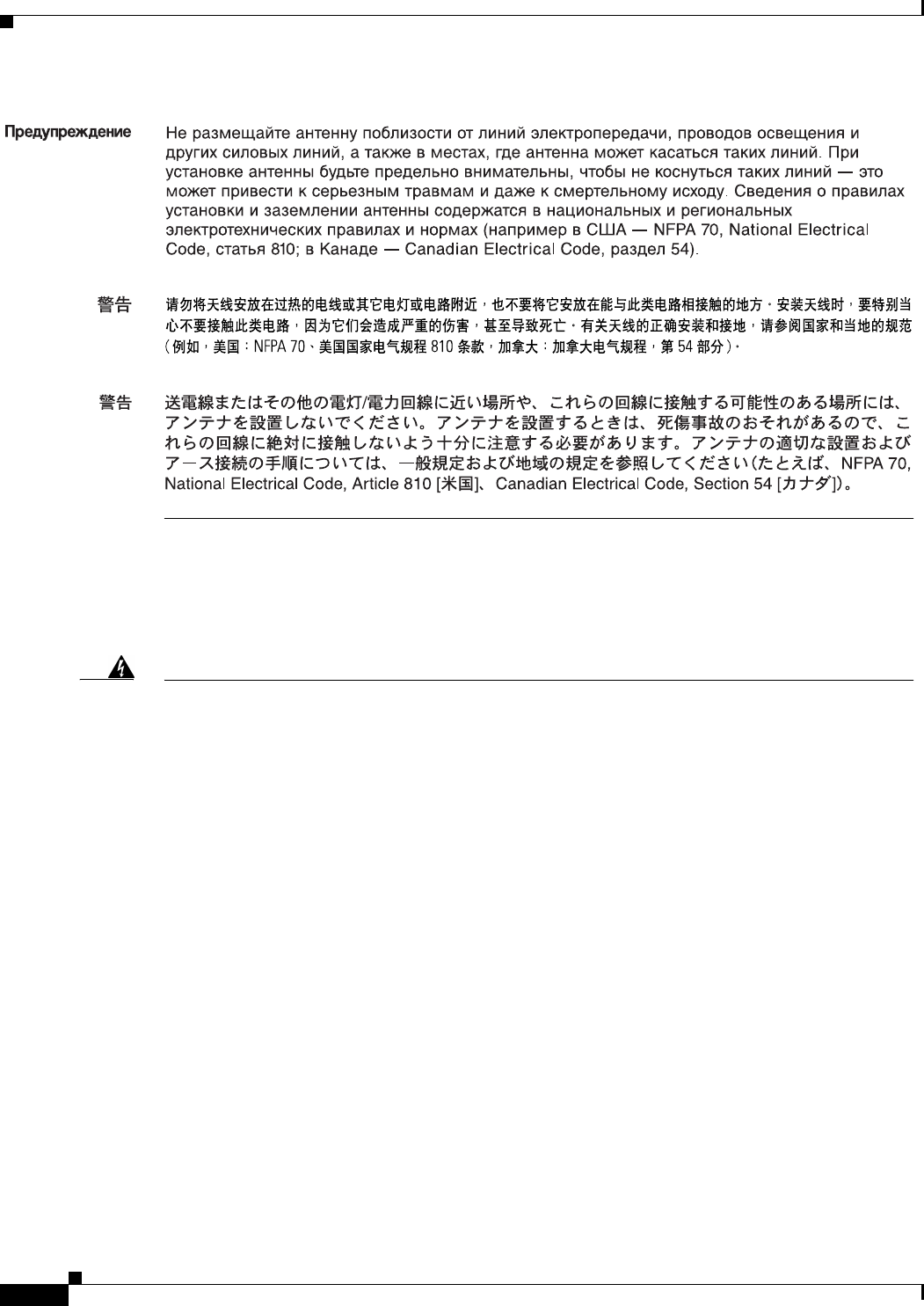
DRAFT - CISCO CONFIDENTIAL
A-6
Cisco Aironet 1400 Series Wireless Bridge Hardware Installation Guide
OL-4072-01
Appendix A Translated Safety Warnings
Circuit Breaker Warning
Circuit Breaker Warning
Warning
This product relies on the building’s installation for short-circuit (overcurrent) protection. Ensure
that the protective device is rated not greater than:
120Vac, 15A U.S. (240Vac, 10A International)
Waarschuwing
Dit product is afhankelijk van de installatie van het gebouw voor beveiliging tegen kortsluiting
(overstroom). Controleer of de beschermingsinrichting niet meer dan:
120Vac, 15A U.S. (240Vac, 10A International)
is.
Varoitus
Tämä tuote on riippuvainen rakennukseen asennetusta oikosulkusuojauksesta
(ylivirtasuojauksesta). Varmista, että suojalaitteen mitoitus ei ole yli:
120Vac, 15A U.S. (240Vac, 10A International)
Attention
Pour ce qui est de la protection contre les courts-circuits (surtension), ce produit dépend de
l'installation électrique du local. Vérifiez que le courant nominal du dispositif de protection n'est
pas supérieur à :
120Vac, 15A U.S. (240Vac, 10A International)
Warnung
Dieses Produkt ist darauf angewiesen, dass im Gebäude ein Kurzschluss- bzw. Überstromschutz
installiert ist. Stellen Sie sicher, dass der Nennwert der Schutzvorrichtung nicht mehr als:
120Vac, 15A U.S. (240Vac, 10A International)
beträgt.
Figyelem!
A termék védelmi rendszerének része az épület kábelezésébe épített rövidzárlat (túláram) elleni
védelem is. Gondoskodjon róla, hogy a készüléket védõ eszköz legfeljebb
120Vac, 15A U.S. (240Vac, 10A International)
áramerõsségre legyen méretezve.
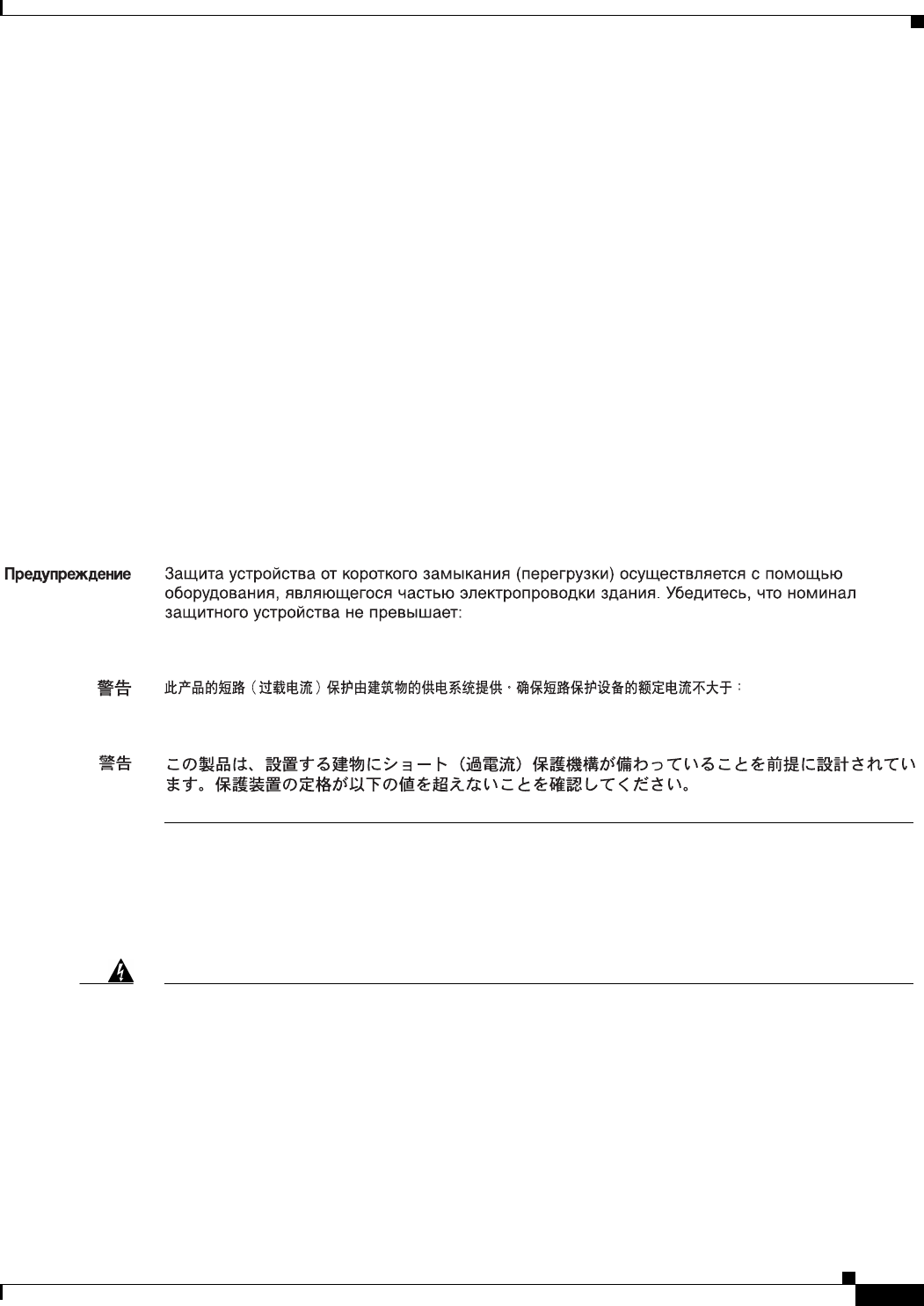
DRAFT - CISCO CONFIDENTIAL
A-7
Cisco Aironet 1400 Series Wireless Bridge Hardware Installation Guide
OL-4072-01
Appendix A Translated Safety Warnings
Ground Conductor Warning
Ground Conductor Warning
Avvertenza
Questo prodotto dipende dall'impianto dell'edificio per quanto riguarda la protezione contro
cortocircuiti (sovracorrente). Assicurarsi che il dispositivo di protezione non abbia un rating
superiore a:
120Vac, 15A U.S. (240Vac, 10A International)
Advarsel
Dette produktet er avhengig av bygningens installasjoner av kortslutnings (overstrøm)-beskyttelse.
Påse at verneenheten ikke er merket høyere enn:
120Vac, 15A U.S. (240Vac, 10A International)
Aviso
Este produto depende das instalações existentes para proteção contra curto-circuito (sobrecarga).
Assegure-se de que o fusível ou disjuntor não seja superior a:
120Vac, 15A U.S. (240Vac, 10A International)
¡Advertencia!
Este equipo utiliza el sistema de protección contra cortocircuitos (o sobrecorrientes) del edificio. Asegúrese
de que el dispositivo de protección no sea superior a:
120Vac, 15A U.S. (240Vac, 10A International)
Varning!
Denna produkt är beroende av i byggnaden installerat kortslutningsskydd (överströmsskydd).
Kontrollera att skyddsanordningen inte har högre märkvärde än:
120Vac, 15A U.S. (240Vac, 10A International)
120Vac, 15A U.S. (240Vac, 10A International)
120Vac, 15A U.S. (240Vac, 10A International)
120Vac, 15A U.S. (240Vac, 10A International)
Warning
This equipment must be grounded. Never defeat the ground conductor or operate the equipment in
the absence of a suitably installed ground conductor. Contact the appropriate electrical inspection
authority or an electrician if you are uncertain that suitable grounding is available.
Waarschuwing
Deze apparatuur dient geaard te zijn. De aardingsleiding mag nooit buiten werking worden gesteld
en de apparatuur mag nooit bediend worden zonder dat er een op de juiste wijze geïnstalleerde
aardingsleiding aanwezig is. Neem contact op met de bevoegde instantie voor elektrische
inspecties of met een elektricien als u er niet zeker van bent dat er voor passende aarding
gezorgd is.

DRAFT - CISCO CONFIDENTIAL
A-8
Cisco Aironet 1400 Series Wireless Bridge Hardware Installation Guide
OL-4072-01
Appendix A Translated Safety Warnings
Ground Conductor Warning
Varoitus
Laitteiden on oltava maadoitettuja. Älä koskaan ohita maajohdinta tai käytä laitteita ilman oikein
asennettua maajohdinta. Ota yhteys sähkötarkastusviranomaiseen tai sähköasentajaan, jos olet
epävarma maadoituksen sopivuudesta.
Attention
Cet équipement doit être mis à la masse. Ne jamais rendre inopérant le conducteur de masse ni
utiliser l'équipement sans un conducteur de masse adéquatement installé. En cas de doute sur la
mise à la masse appropriée disponible, s'adresser à l'organisme responsable de la sécurité
électrique ou à un électricien.
Warnung
Dieses Gerät muss geerdet sein. Auf keinen Fall den Erdungsleiter unwirksam machen oder das
Gerät ohne einen sachgerecht installierten Erdungsleiter verwenden. Wenn Sie sich nicht sicher
sind, ob eine sachgerechte Erdung vorhanden ist, wenden Sie sich an die zuständige
Inspektionsbehörde oder einen Elektriker.
Figyelem!
A berendezés csak megfelelõ védõföldeléssel mûködtethetõ. Ne iktassa ki a földelés csatlakozóját,
és ne üzemeltesse a berendezést szabályosan felszerelt földelõ vezeték nélkül! Ha nem biztos
benne, hogy megfelelõ földelés áll rendelkezésbe, forduljon a helyi elektromos hatóságokhoz vagy
egy villanyszerelõhöz.
Avvertenza
Questa apparecchiatura deve essere dotata di messa a terra. Non escludere mai il conduttore di
protezione né usare l'apparecchiatura in assenza di un conduttore di protezione installato in modo
corretto. Se non si è certi della disponibilità di un adeguato collegamento di messa a terra,
richiedere un controllo elettrico presso le autorità competenti o rivolgersi a un elettricista.
Advarsel
Dette utstyret må jordes. Omgå aldri jordingslederen og bruk aldri utstyret uten riktig montert
jordingsleder. Ta kontakt med fagfolk innen elektrisk inspeksjon eller med en elektriker hvis du er
usikker på om det finnes velegnet jordning.
Aviso
Este equipamento deve ser aterrado. Nunca anule o fio terra nem opere o equipamento sem um
aterramento adequadamente instalado. Em caso de dúvida com relação ao sistema de aterramento
disponível, entre em contato com os serviços locais de inspeção elétrica ou um eletricista
qualificado.
¡Advertencia!
Este equipo debe estar conectado a tierra. No inhabilite el conductor de tierra ni haga funcionar el
equipo si no hay un conductor de tierra instalado correctamente. Póngase en contacto con la
autoridad correspondiente de inspección eléctrica o con un electricista si no está seguro de que
haya una conexión a tierra adecuada.
Varning!
Denna utrustning måste jordas. Koppla aldrig från jordledningen och använd aldrig utrustningen
utan en på lämpligt sätt installerad jordledning. Om det föreligger osäkerhet huruvida lämplig
jordning finns skall elektrisk besiktningsauktoritet eller elektriker kontaktas.
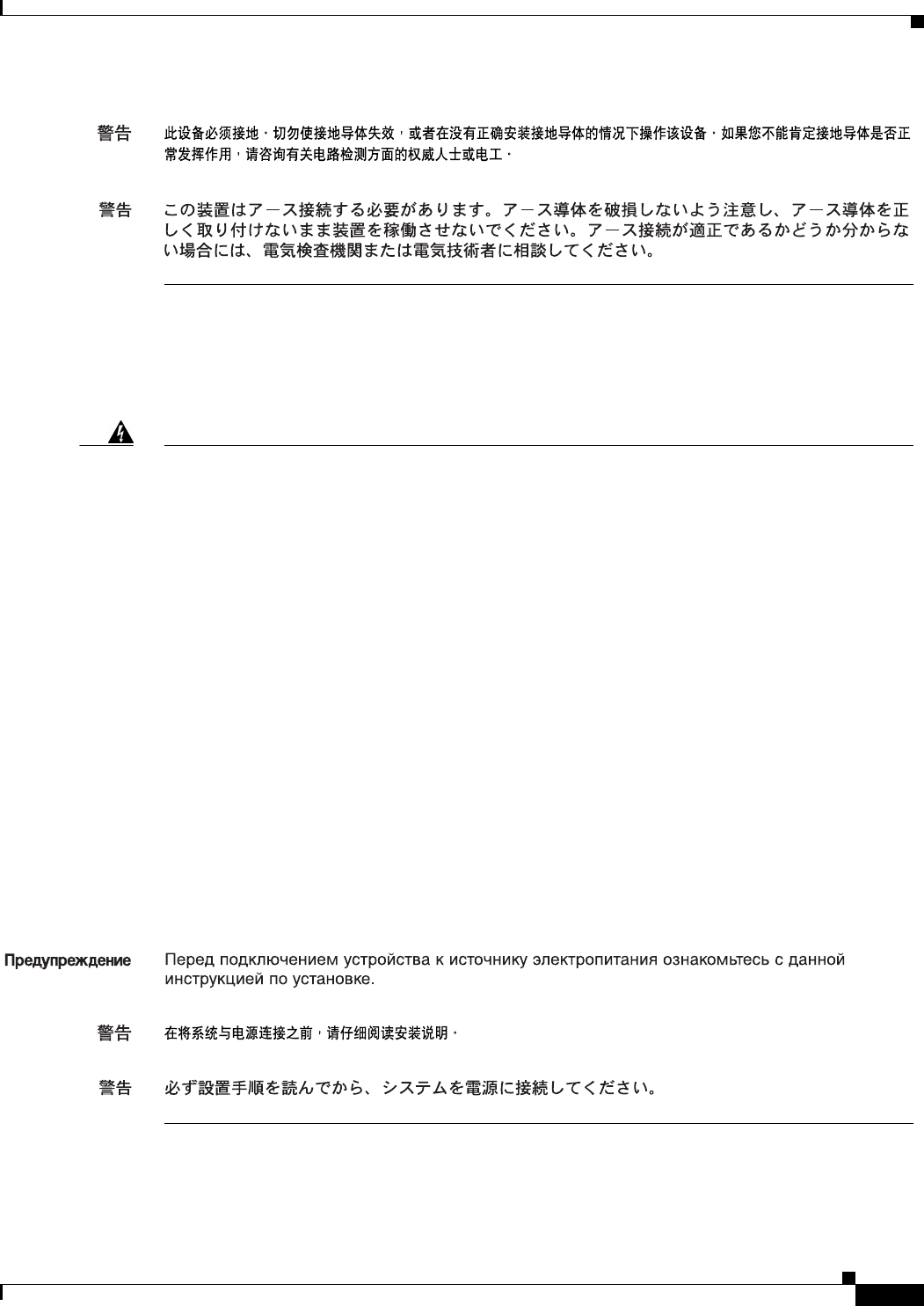
DRAFT - CISCO CONFIDENTIAL
A-9
Cisco Aironet 1400 Series Wireless Bridge Hardware Installation Guide
OL-4072-01
Appendix A Translated Safety Warnings
Installation Warning
Installation Warning
Warning
Read the installation instructions before connecting the system to the power source.
Waarschuwing
Raadpleeg de installatie-instructies voordat u het systeem op de voedingsbron aansluit.
Varoitus
Lue asennusohjeet ennen järjestelmän yhdistämistä virtalähteeseen.
Attention
Avant de brancher le système sur la source d'alimentation, consulter les directives d'installation.
Warnung
Vor dem Anschließen des Systems an die Stromquelle die Installationsanweisungen lesen.
Figyelem!
Mielõtt áramforráshoz csatlakoztatná a rendszert, olvassa el az üzembe helyezési útmutatót!
Avvertenza
Consultare le istruzioni di installazione prima di collegare il sistema all'alimentatore.
Advarsel
Les installasjonsinstruksjonene før systemet kobles til strømkilden.
Aviso
Leia as instruções de instalação antes de ligar o sistema à fonte de energia.
¡Advertencia!
Lea las instrucciones de instalación antes de conectar el sistema a la red de alimentación.
Varning!
Läs installationsanvisningarna innan du kopplar systemet till strömförsörjningsenheten.
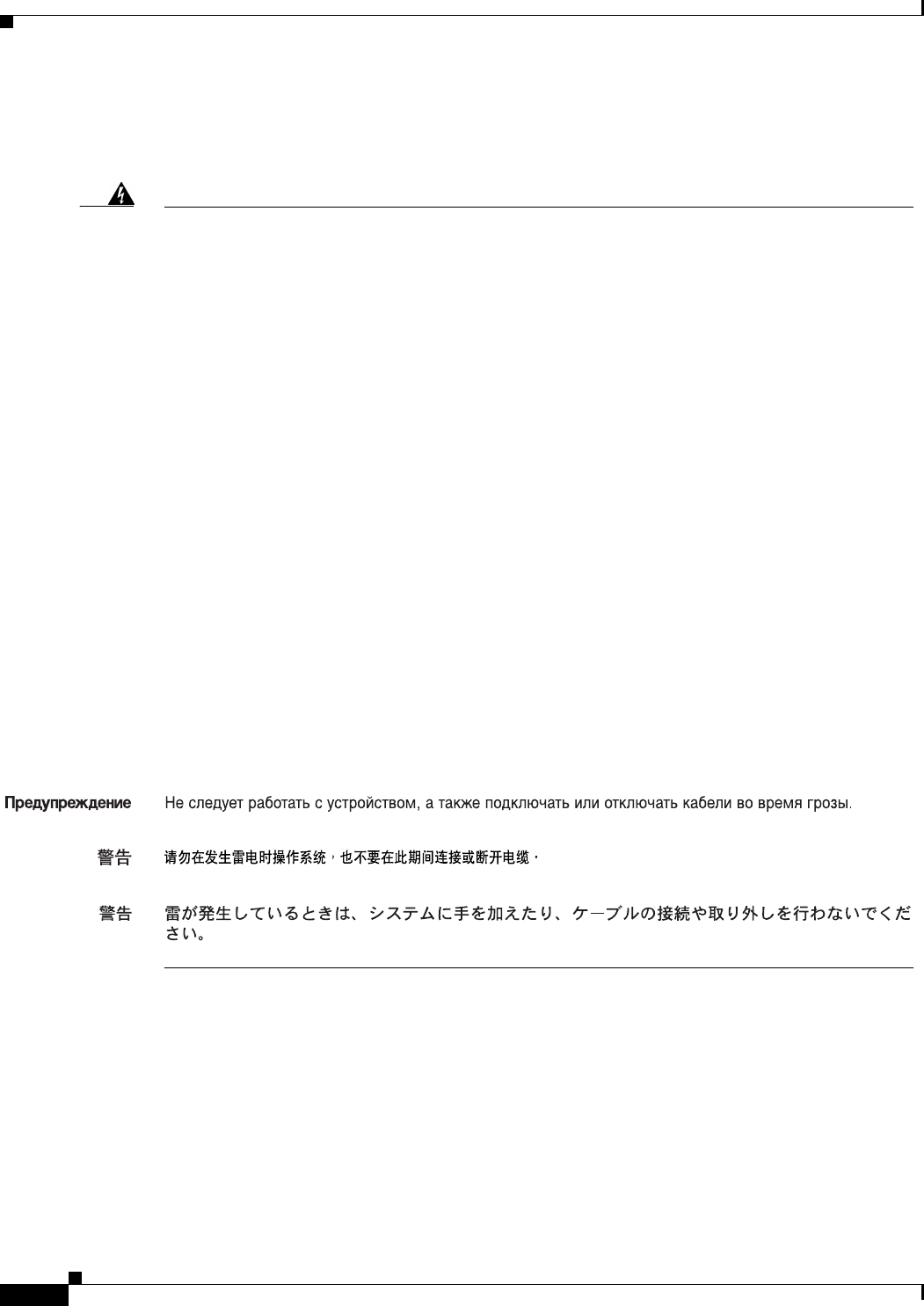
DRAFT - CISCO CONFIDENTIAL
A-10
Cisco Aironet 1400 Series Wireless Bridge Hardware Installation Guide
OL-4072-01
Appendix A Translated Safety Warnings
Lightning Activity Warning
Lightning Activity Warning
Warning
Do not work on the system or connect or disconnect cables during periods of lightning activity.
Waarschuwing
Tijdens onweer dat gepaard gaat met bliksem, dient u niet aan het systeem te werken of kabels aan
te sluiten of te ontkoppelen.
Varoitus
Älä työskentele järjestelmän parissa äläkä yhdistä tai irrota kaapeleita ukkosilmalla.
Attention
Ne pas travailler sur le système ni brancher ou débrancher les câbles pendant un orage.
Warnung
Arbeiten Sie nicht am System und schließen Sie keine Kabel an bzw. trennen Sie keine ab, wenn
es gewittert.
Figyelem!
Villámlás közben ne dolgozzon a rendszeren, valamint ne csatlakoztasson és ne húzzon ki
kábeleket!
Avvertenza
Non lavorare sul sistema o collegare oppure scollegare i cavi durante un temporale con fulmini.
Advarsel
Utfør aldri arbeid på systemet, eller koble kabler til eller fra systemet når det tordner eller lyner.
Aviso
Não trabalhe no sistema ou ligue e desligue cabos durante períodos de mau tempo (trovoada).
¡Advertencia!
No operar el sistema ni conectar o desconectar cables durante el transcurso de descargas
eléctricas en la atmósfera.
Varning!
Vid åska skall du aldrig utföra arbete på systemet eller ansluta eller koppla loss kablar.

DRAFT - CISCO CONFIDENTIAL
A-11
Cisco Aironet 1400 Series Wireless Bridge Hardware Installation Guide
OL-4072-01
Appendix A Translated Safety Warnings
Explosive Device Proximity Warning
Explosive Device Proximity Warning
Bridge Antenna Exposure Limits -TBD
Warning In order to comply with radio frequency (RF) exposure limits
, the antennas for this product should be
positioned no less than 6.56 ft (2 m) from your body or nearby persons.
Warning
Do not operate your wireless network device near unshielded blasting
caps or in an explosive environ-
ment unless the device has been modified to be especially qualified for such use.
Waarschuwing
Gebruik dit draadloos netwerkapparaat alleen in de buurt van onbeschermde ontstekers of in
een omgeving met explosieven indien het apparaat speciaal is aangepast om aan de eisen voor
een dergelijk gebruik te voldoen.
Varoitus
Älä käytä johdotonta verkkolaitetta suojaamattomien räjäytysnallien läheisyydessä tai räjäy-
tysalueella, jos laitetta ei ole erityisesti muunnettu sopivaksi sellaiseen käyttöön.oen.
Attention
Ne jamais utiliser un équipement de réseau sans fil à proximité d'un détonateur non blindé ou
dans un lieu présentant des risques d'explosion, sauf si l'équipement a été modifié à cet effet.
Warnung
Benutzen Sie Ihr drahtloses Netzwerkgerät nicht in der Nähe ungeschützter Sprengkapseln oder
anderer explosiver Stoffe, es sei denn, Ihr Gerät wurde eigens für diesen Gebrauch modifiziert
und bestimmt.
Avvertenza
Non utilizzare la periferica di rete senza fili in prossimità di un detonatore non protetto o di es-
plosivi a meno che la periferica non sia stata modificata a tale proposito.
Advarsel
Ikke bruk den trådløse nettverksenheten nært inntil uisolerte fenghetter eller i et eksplosivt mil-
jø med mindre enheten er modifisert slik at den tåler slik bruk.
Aviso
Não opere o dispositivo de rede sem fios perto de cápsulas explosivas não protegidas ou num
ambiente explosivo, a não ser que o dispositivo tenha sido modificado para se qualificar espe-
cialmente para essa utilização.
¡Advertencia!
No utilizar un aparato de la red sin cable cerca de un detonador que no esté protegido ni tam-
poco en un entorno explosivo a menos que el aparato haya sido modificado con ese fin.
Varning!
Använd inte den trådlösa nätverksenheten i närheten av oskyddade tändhattar eller i en explo-
siv miljö om inte enheten modifierats för att kunna användas i sådana sammanhang.

DRAFT - CISCO CONFIDENTIAL
A-12
Cisco Aironet 1400 Series Wireless Bridge Hardware Installation Guide
OL-4072-01
Appendix A Translated Safety Warnings
Bridge Antenna Exposure Limits -TBD

DRAFT - CISCO CONFIDENTIAL
B-1
Cisco Aironet 1400 Series Wireless Bridge Hardware Installation Guide
OL-4072-01
APPENDIX
B
Declarations of Conformity and Regulatory
Information
This appendix provides declarations of conformity and regulatory information for the Cisco Aironet
1400 Series Wireless Bridge.
This appendix contains the following sections:
•Manufacturers Federal Communication Commission Declaration of Conformity Statement, page
B-2
•Department of Communications—Canada, page B-3
•Declaration of Conformity for RF Exposure, page B-4
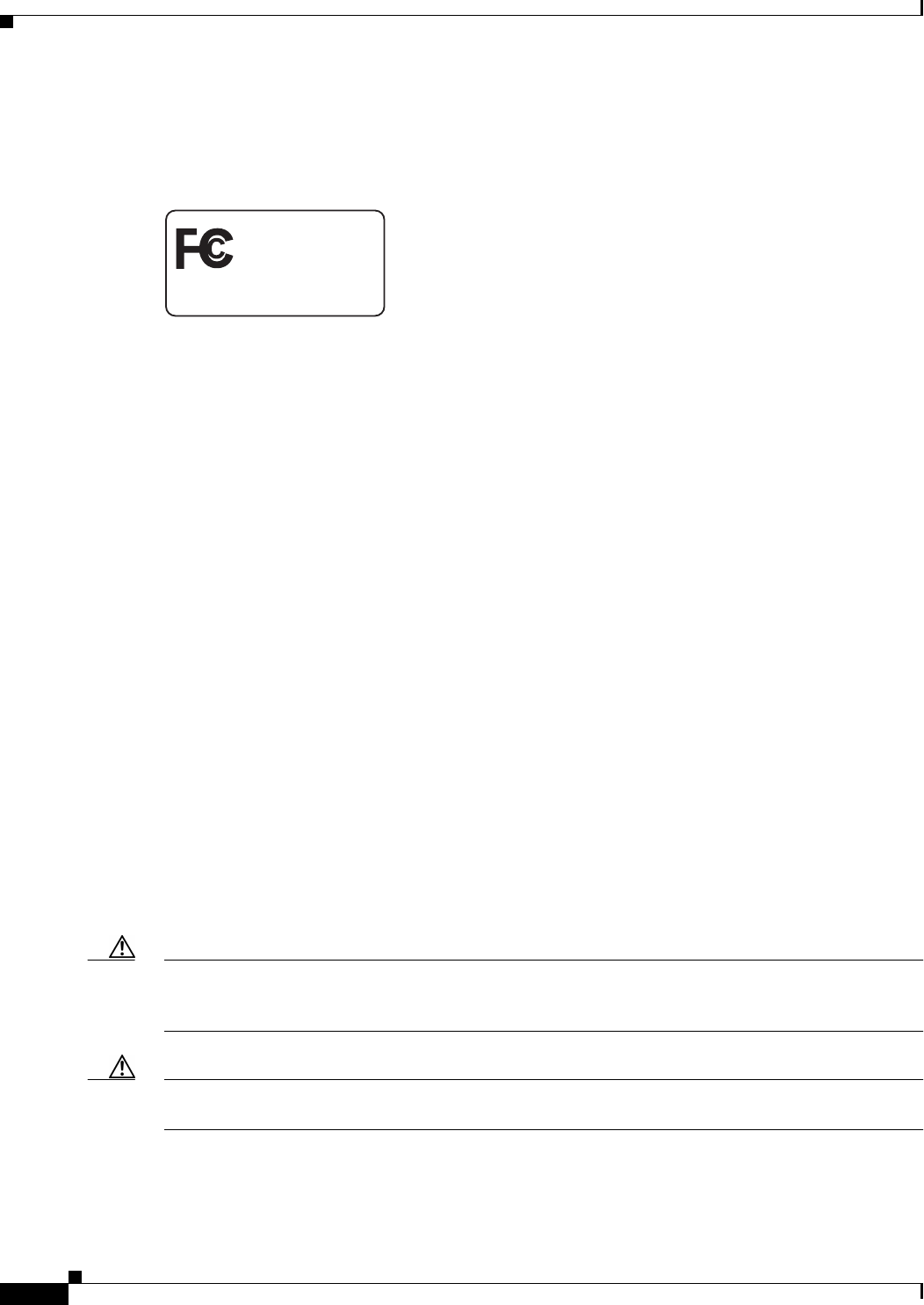
DRAFT - CISCO CONFIDENTIAL
B-2
Cisco Aironet 1400 Series Wireless Bridge Hardware Installation Guide
OL-4072-01
Appendix B Declarations of Conformity and Regulatory Information
Manufacturers Federal Communication Commission Declaration of Conformity Statement
Manufacturers Federal Communication Commission
Declaration of Conformity Statement
Models: AIR-BR1410A-A-K9
AIR-BR-1410-A-A-K9-N
FCC Certification number: LDK 102047
LDK 102047P
Manufacturer: Cisco Systems, Inc.
170 West Tasman Drive
San Jose, CA 95134-1706
USA
This device complies with Part 15 rules. Operation is subject to the following two conditions:
1. This device may not cause harmful interference, and
2. This device must accept any interference received, including interference that may cause undesired
operation.
This equipment has been tested and found to comply with the limits of a Class B digital device, pursuant
to Part 15 of the FCC Rules. These limits are designed to provide reasonable protection against harmful
interference when the equipment is operated in a residential environment. This equipment generates,
uses, and radiates radio frequency energy, and if not installed and used in accordance with the
instructions, may cause harmful interference. However, there is no guarantee that interference will not
occur. If this equipment does cause interference to radio or television reception, which can be determined
by turning the equipment off and on, the user is encouraged to correct the interference by one of the
following measures:
•Reorient or relocate the receiving antenna.
•Increase separation between the equipment and receiver.
•Connect the equipment to an outlet on a circuit different from which the receiver is connected.
•Consult the dealer or an experienced radio/TV technician.
Caution The Part 15 radio device operates on a non-interference basis with other devices operating at this
frequency when using integrated antennas or those listed in Table B-1. Any changes or modification to
the product not expressly approved by Cisco could void the user’s authority to operate this device.
Caution To meet regulatory restrictions, the bridge with the antenna connector and the external antenna must be
installed by a professional installer.
Tested To Comply
With FCC Standards
FOR HOME OR OFFICE USE

DRAFT - CISCO CONFIDENTIAL
B-3
Cisco Aironet 1400 Series Wireless Bridge Hardware Installation Guide
OL-4072-01
Appendix B Declarations of Conformity and Regulatory Information
Department of Communications—Canada
Department of Communications—Canada
Canadian Compliance Statement
This Class B Digital apparatus meets all the requirements of the Canadian Interference-Causing
Equipment Regulations.
Cet appareil numerique de la classe B respecte les exigences du Reglement sur le material broilleur du
Canada.
This device complies with Class B Limits of Industry Canada. Operation is subject to the following two
conditions:
1. This device may not cause harmful interference, and
2. This device must accept any interference received, including interference that may cause undesired
operation.
Cisco’s 54-Mbps, 5.8-GHz bridges are certified to the requirements of RSS-210 issue 5, RSP 100, and
RSS 102 for 5-GHz spread spectrum devices.
Table B-1 Access Point 2.4-GHz Antennas
Cisco Part Number Model Gain
AIR-ANT58G9VOA-NAironet Vertically polarized
omnidirectional 9 dBi
AIR-ANT58G10SSA-NAironet Sector 9.5 dBi
AIR-ANT58G28SDA-NAironet Dish 28 dBi

DRAFT - CISCO CONFIDENTIAL
B-4
Cisco Aironet 1400 Series Wireless Bridge Hardware Installation Guide
OL-4072-01
Appendix B Declarations of Conformity and Regulatory Information
Declaration of Conformity for RF Exposure
Declaration of Conformity for RF Exposure
This bridge product has been found to be compliant to the requirements set forth in CFR 47
Section 1.1307 addressing RF Exposure from radio frequency devices as defined in Evaluating
Compliance with FCC Guidelines for Human Exposure to Radio Frequency Electromagnetic Fields. For
antennas, AIR-ANT58G9VOA-NAironet, AIR-ANT58G10SSA-NAironet, and
AIR-ANT58G28SDA-NAironet, the antennas should be positioned more than 6.8 feet (2 meters) from
your body or nearby persons.
This transmitter may not be co-located or operating in conjunction with
other transmitters or antennas separated by less than 2m .

DRAFT - CISCO CONFIDENTIAL
C-1
Cisco Aironet 1400 Series Wireless Bridge Hardware Installation Guide
OL-4072-01
APPENDIX
C
Channels and Antenna Settings
This appendix lists the IEEE 802.11a (5.8-GHz band) channels and the maximum power levels supported
by the Americas regulatory domain.
The following topics are covered in this appendix:
•Channels, page C-2
•Maximum Power Levels, page C-2
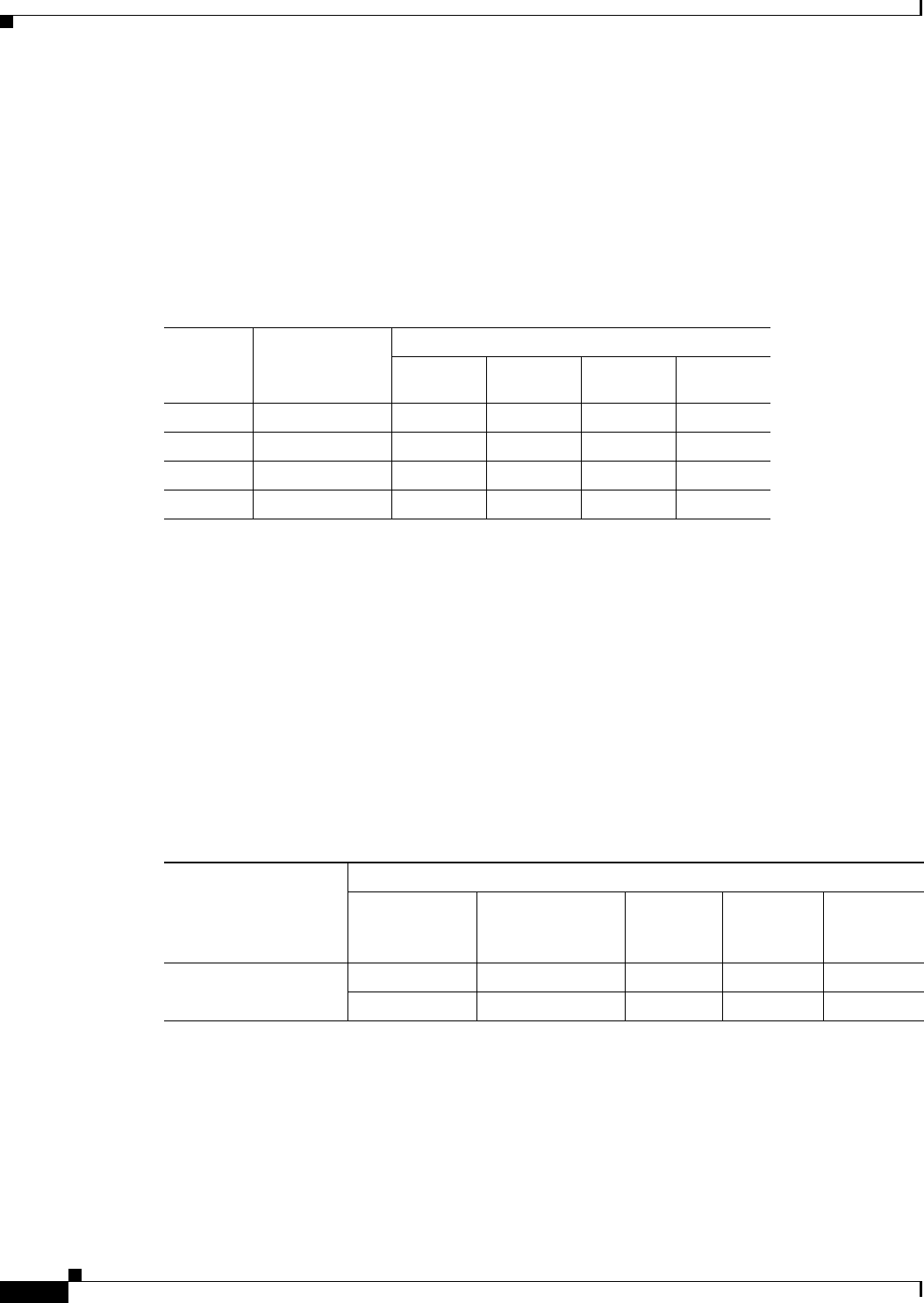
DRAFT - CISCO CONFIDENTIAL
C-2
Cisco Aironet 1400 Series Wireless Bridge Hardware Installation Guide
OL-4072-01
Appendix C Channels and Antenna Settings
Channels
Channels
IEEE 802.11a (5.8-GHz Band)
The channel identifiers, channel center frequencies and regulatory domain of each 20-MHz-wide
channel are shown in Table C-1.
.
This product is for outdoor use with regard to the channel identifiers indicated in Table C-1.
Maximum Power Levels
5.8-GHz Band
An improper combination of power level and antenna configurations can result in equivalent isotropic
radiated power (EIRP) above the amount allowed per regulatory domain. Table C-2 indicates the
maximum power levels and antenna gains allowed.
Table C-1 Channels for IEEE 802.11a (5.8-GHz Band)
Channel
Identifier
Center
Frequency
(MHz)
Regulatory Domains
Americas
(-A)
149 5745 X
153 5765 X
157 5785 X
161 5805 X
Table C-2 Maximum Power Levels and Antenna Gains
Regulatory Domains
Maximum Power Settings
Orientation
9 dBi
Omnidirectional
Antenna
9.5 dBi
Sector
Antenna
22.5 dBi
Integrated
Antenna
28 dBi
Dish
Antenna
Americas (-A) P2P1
1. Point-to-Point
24 dBm 24 dBm 24 dBm 22 dBm
P2MP2
2. Point-to-Multipoint
24 dBm 24 dBm 123 dBm4
3. A maximum of 13 dBm is allowed, but that setting is not supported by the bridge.
4. On point-to-multipoint links, the remote bridges communicating with the central bridge are allowed to use a maximum power
setting of 24 dBm. The central bridge is limited to a maximum power setting of 12 dBm.
na
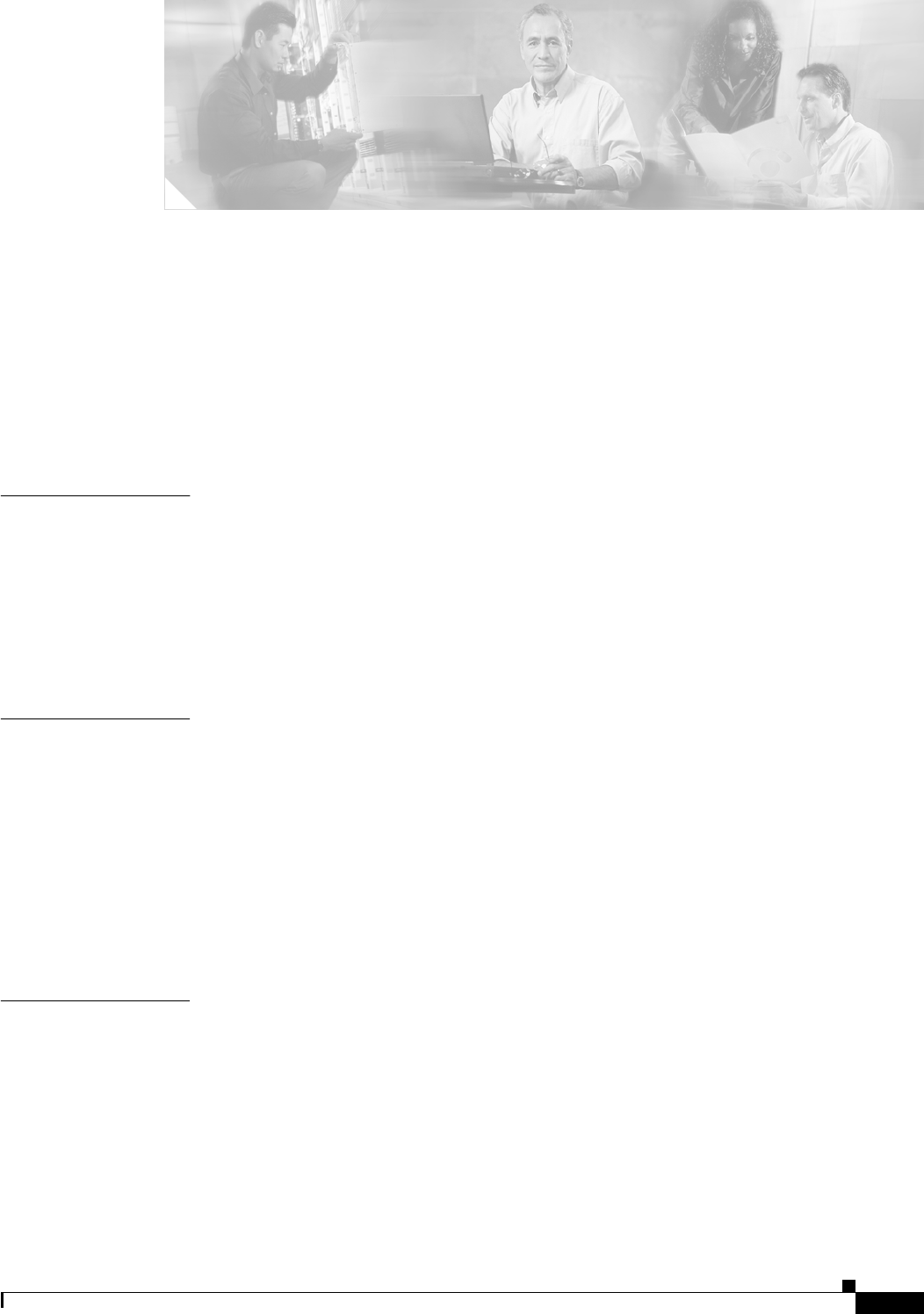
DRAFT - CISCO CONFIDENTIAL
GL-1
Cisco Aironet 1400 Series Wireless Bridge Hardware Installation Guide
OL-4072-01
GLOSSARY
802.11 The IEEE standard that specifies carrier sense media access control and physical layer
specifications for 1- and 2-megabit-per-second (Mbps) wireless LANs operating in the 2.4-GHz
band.
802.11a The IEEE standard that specifies carrier sense media access control and physical layer
specifications for wireless LANs operating in the 5-GHz frequency band.
A
Ad Hoc Network A wireless network composed of stations without Access Points.
Antenna Gain The gain of an antenna is a measure of the antenna’s ability to direct or focus radio energy over a
region of space. High gain antennas have a more focused radiation pattern in a specific direction.
Associated A station is configured properly to allow it to wirelessly communicate with an Access Point.
B
Beacon A wireless LAN packet that signals the availability and presence of the wireless device. Beacon
packets are sent by access points and base stations; however, client radio cards send beacons when
operating in computer to computer (Ad Hoc) mode.
BOOTP Boot Protocol. A protocol used for the static assignment of IP addresses to devices on the network.
Bridge A wireless LAN transceiver that is used to interconnect two or more wired Ethernet networks.
Broadcast Packet A single data message (packet) sent to all addresses on the same subnet.
C
Cell The area of radio range or coverage in which the wireless devices can communicate with the base
station. The size of the cell depends upon the speed of the transmission, the type of antenna used,
and the physical environment, as well as other factors.
CSMA Carrier sense multiple access. A wireless LAN media access method specified by the IEEE 802.11
specification.

DRAFT - CISCO CONFIDENTIAL
Glossary
GL-2
Cisco Aironet 1400 Series Wireless Bridge Hardware Installation Guide
OL-4072-01
D
Data Rates The range of data transmission rates supported by a device. Data rates are measured in megabits
per second (Mbps).
dBi A ratio of decibels to an isotropic antenna that is commonly used to measure antenna gain. The
greater the dBi value, the higher the gain, and the more acute the angle of coverage.
dBm A power measurement described in decibels per milliwatt. 0 dBm is defined as 1 mw at 1 kHz of
frequency at 600 ohms of impedance.
DHCP Dynamic host configuration protocol. A protocol available with many operating systems that
automatically issues IP addresses within a specified range to devices on the network. The device
retains the assigned address for a specific administrator-defined period.
Dipole A type of low-gain (2.2-dBi) antenna consisting of two (often internal) elements.
Domain Name The text name that refers to a grouping of networks or network resources based on
organization-type or geography; for example: name.com—commercial; name.edu—educational;
name.gov—government; ISPname.net—network provider (such as an ISP); name.ar—Argentina;
name.au—Australia; and so on.
DNS Domain Name System server. A server that translates text names into IP addresses. The server
maintains a database of host alphanumeric names and their corresponding IP addresses.
DSSS Direct sequence spread spectrum. A type of spread spectrum radio transmission that spreads its
signal continuously over a wide frequency band.
E
EAP Extensible Authentication Protocol. An optional IEEE 802.1x security feature ideal for
organizations with a large user base and access to an EAP-enabled Remote Authentication Dial-In
User Service (RADIUS) server.
Ethernet The most widely used wired local area network. Ethernet uses carrier sense multiple access
(CSMA) to allow computers to share a network and operates at 10, 100, or 1000 Mbps, depending
on the physical layer used.
F
File Server A repository for files so that a local area network can share files, mail, and programs.
Firmware Software that is programmed on a memory chip.
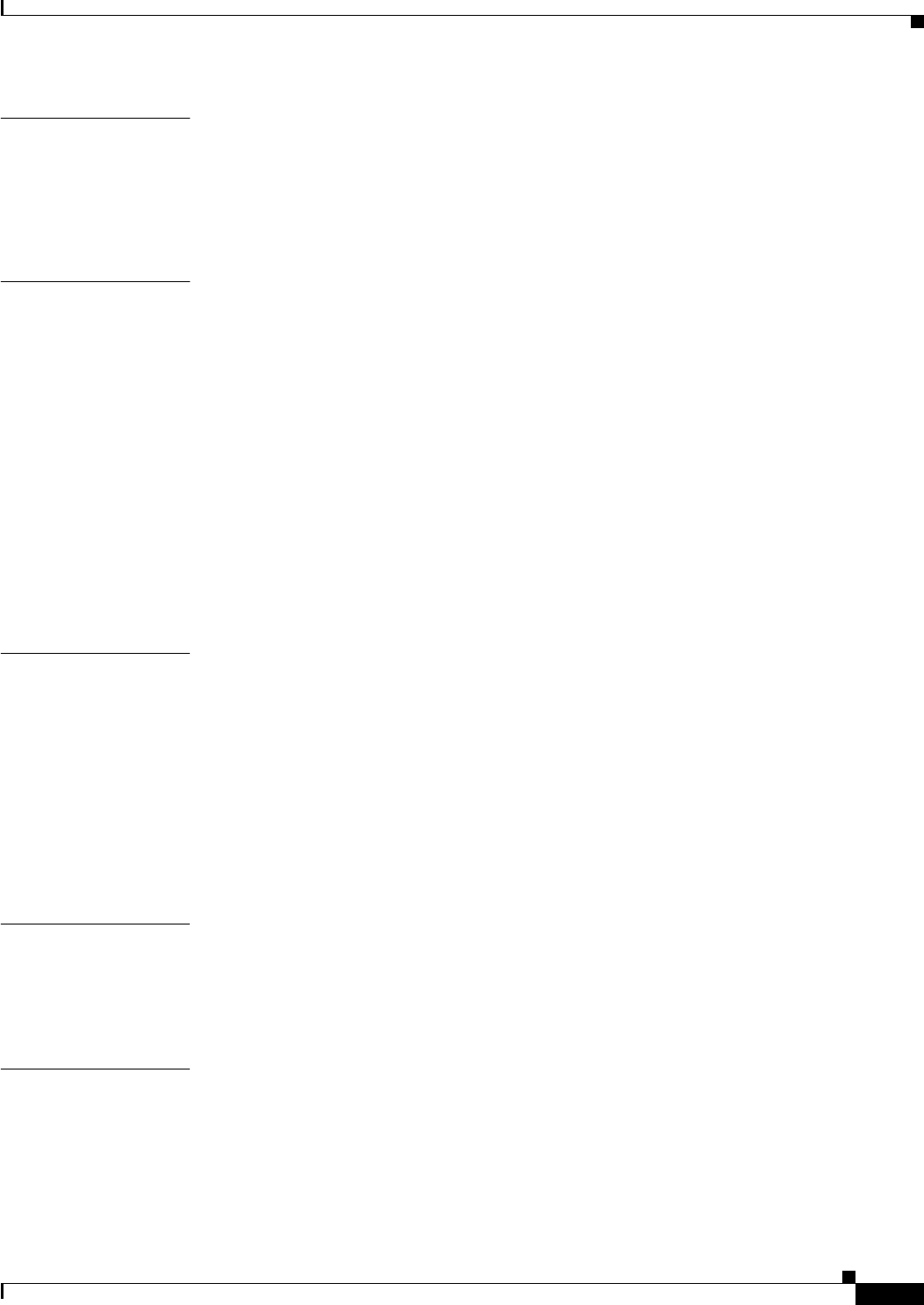
DRAFT - CISCO CONFIDENTIAL
Glossary
GL-3
Cisco Aironet 1400 Series Wireless Bridge Hardware Installation Guide
OL-4072-01
G
Gateway A device that connects two otherwise incompatible networks together.
GHz Gigahertz. One billion cycles per second. A unit of measure for frequency.
I
IEEE Institute of Electrical and Electronic Engineers. A professional society serving electrical engineers
through its publications, conferences, and standards development activities. The body responsible
for the Ethernet 802.3 and wireless LAN 802.11 specifications.
Infrastructure The wired Ethernet network.
IP Address The Internet Protocol (IP) address of a station.
IP Subnet Mask The number used to identify the IP subnetwork, indicating whether the IP address can be
recognized on the LAN or if it must be reached through a gateway. This number is expressed in a
form similar to an IP address; for example: 255.255.255.0.
Isotropic An antenna that radiates its signal 360 degrees both vertically and horizontally in a perfect sphere.
M
MAC Media Access Control address. A unique 48-bit number used in Ethernet data packets to identify
an Ethernet device, such as an access point or your client adapter.
Modulation Any of several techniques for combining user information with a transmitter’s carrier signal.
Multipath The echoes created as a radio signal bounces off of physical objects.
Multicast Packet A single data message (packet) sent to multiple addresses.
N
Non-root Bridge A wireless LAN transceiver connected to a remote Ethernet network and communicates only with
another wireless LAN transceiver connected to the main Ethernet network.
O
Omni-directional This typically refers to a primarily circular antenna radiation pattern.
Orthogonal Frequency
Division Multiplex
(OFDM)
A modulation technique used by IEEE 802.11a-compliant wireless LANs for transmission at 6, 9,
12, 18, 24, 36, 48, and 54 Mbps.

DRAFT - CISCO CONFIDENTIAL
Glossary
GL-4
Cisco Aironet 1400 Series Wireless Bridge Hardware Installation Guide
OL-4072-01
P
Packet A basic message unit for communication across a network. A packet usually includes routing
information, data, and sometimes error detection information.
Power Injector A device that supplies DC power to another device over Ethernet communication lines.
R
Range A linear measure of the distance that a transmitter can send a signal.
Receiver Sensitivity A measurement of the weakest signal a receiver can receive and still correctly translate it into data.
RF Radio frequency. A generic term for radio-based technology.
Roaming A feature of some Access Points that allows users to move through a facility while maintaining an
unbroken connection to the LAN.
Root Bridge A wireless LAN transceiver connected to the main Ethernet network and communicates with other
wireless LAN transceivers connected to remote Ethernet networks.
S
Spread Spectrum A radio transmission technology that spreads the user information over a much wider bandwidth
than otherwise required in order to gain benefits such as improved interference tolerance and
unlicensed operation.
SSID Service Set Identifier (also referred to as Radio Network Name). A unique identifier used to
identify a radio network and which stations must use to be able to communicate with each other
or to an access point. The SSID can be any alphanumeric entry up to a maximum of 32 characters.

DRAFT - CISCO CONFIDENTIAL
Glossary
GL-5
Cisco Aironet 1400 Series Wireless Bridge Hardware Installation Guide
OL-4072-01
T
Transmit Power The power level of radio transmission.
U
UNII Unlicensed National Information Infrastructure—regulations for UNII devices operating in the
5.15 to 5.35 GHz and 5.725 to 5.825 GHz frequency bands.
UNII-1 Regulations for UNII devices operating in the 5.15 to 5.25 GHz frequency band.
UNII-2 Regulations for UNII devices operating in the 5.25 to 5.35 GHz frequency band.
UNII-3 Regulations for UNII devices operating in the 5.725 to 5.825 GHz frequency band.
Unicast Packet A single data message (packet) sent to a specific IP address.
W
WEP Wired Equivalent Privacy. An optional security mechanism defined within the 802.11 standard
designed to make the link integrity of wireless devices equal to that of a cable.
Workstation A computing device with an installed client adapter.

DRAFT - CISCO CONFIDENTIAL
Glossary
GL-6
Cisco Aironet 1400 Series Wireless Bridge Hardware Installation Guide
OL-4072-01

DRAFT - CISCO CONFIDENTIAL
IN-1
Cisco Aironet 1400 Series Wireless Bridge Hardware Installation Guide
OL-4072-01
INDEX
A
access point
image 5-10
antenna
connectors 1-8
audience vii
B
basic settings
checking 5-7
C
caution viii
Cisco TAC 5-1
connector 1-3
connectors 1-7, 1-8
conventions, document viii
conventions of document ?? to ix, ?? to A-3
D
data rates 1-8, 2-5
declarations of conformity B-1
default configuration
resetting to defaults 5-8
document
conventions ?? to ix, ?? to A-3
documentation
conventions viii
related publications ix
E
EIRP, maximum C-2 to ??
environmental conditions 2-5
F
FCC Declaration of Conformity B-2
FCC Safety Compliance 2-3
frequencies C-2
frequency range 1-7
I
indicators 1-4, 5-2
inline power 1-2
input power 1-7
installation guidelines 2-3
IP address, finding and setting 4-10
IPSU 4-9
M
MAC 4-10, 4-11
Mode button 5-10
N
network configurations 1-5
O
obtaining

DRAFT - CISCO CONFIDENTIAL
Index
IN-2
Cisco Aironet 1400 Series Wireless Bridge Hardware Installation Guide
OL-4072-01
documentation ix
operating temperature 1-7
P
package contents 2-6
password reset 5-8
power
inline 1-2
input 1-7
power level, maximum C-2
R
range 1-8
regulatory B-1
domains C-2
related publications ix
reloading access point image 5-10
RF exposure B-4
S
safety warnings, translated A-1
site survey 2-5
size 1-6
specifications 1-6
SSID
troubleshooting 5-7
T
TAC 5-1
Telnet 4-12
temperature
operating 1-7
TFTP server 5-10
troubleshooting 5-1
U
unpacking 2-5
V
voltage range 1-7
W
warning
defined viii to ix, 2-2 to ??, A-2 to A-3
warnings 2-2, A-1
weight 1-7
